TAPE 79/SD/06
THIS TAPE HAS BEEN RECORDED ON AUGUST 16TH 1979 AT 26 HARGREAVES DRIVE, RAWTENSTALL. THE INFORMANT IS JIM RILEY, MULE SPINNER AT SPRING VALE MILL. THE INTERVIEWER IS STANLEY GRAHAM.
[My first intention was to have Jim describe the mule spinning pictures but as I got into the interview I realised there was much to be said in skimming through the other pics as well, he has the experience to be able to add to the information we shall get from other people. All the pictures are in the Spring Vale folio and I'll flag up the different sections.]
This tape is going to be a description of the mule spinning pictures in the Spinning Folio.
As we have already mentioned on these tapes Jim’s done just about every job in the spinning mill. So what we are going to do, we'll get Jim to describe the other pictures as well because I have no doubt there is a lot he can tell us that’s of interest. Now, these pictures in the folio [SVBreaking section], picture 1 is a general view of Spring Vale Mill from the hill at the side.
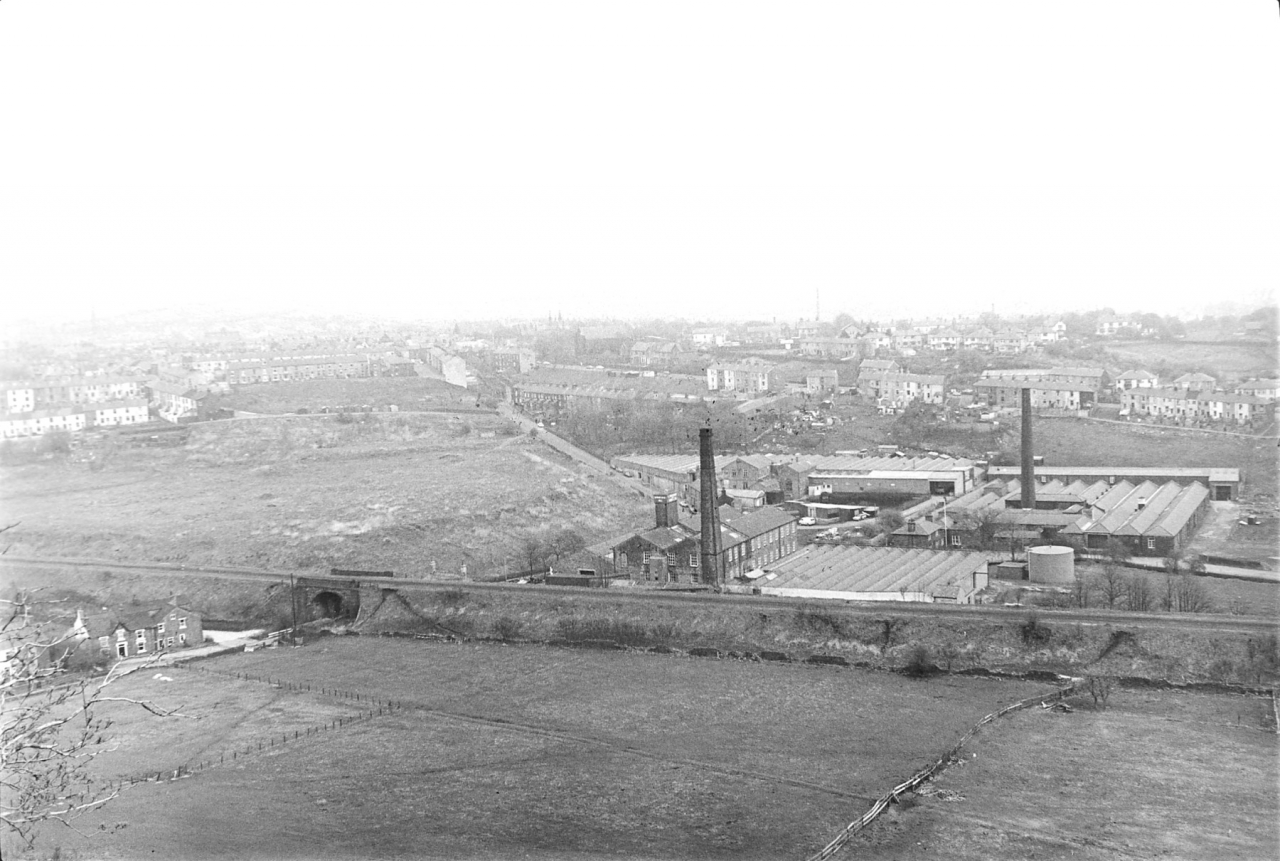
Now one interesting thing about this mill is that in common with a lot of other mill sites in this part of Lancashire it's on the site of an old water power mill. There's a brook runs down, Swinnel Beck runs down alongside the mill and at one time, up to about 1846, it’s on
(50)
the 1846 map, the first edition of the 6" Ordnance Survey, there was water powered fulling mill on this site and the tenting frames extended into the field towards the left-hand corner of the picture. And even to this day you can see some lines in the field which almost look like the lines of where the tenting frames were. When you think that Bronze Age Ploughing can still be distinguished after that length of time, it's quite possible that these traces in the field are the traces of the walkways and pathways up through the old tenting frames. They certainly ran there because they were marked on the 6" map.
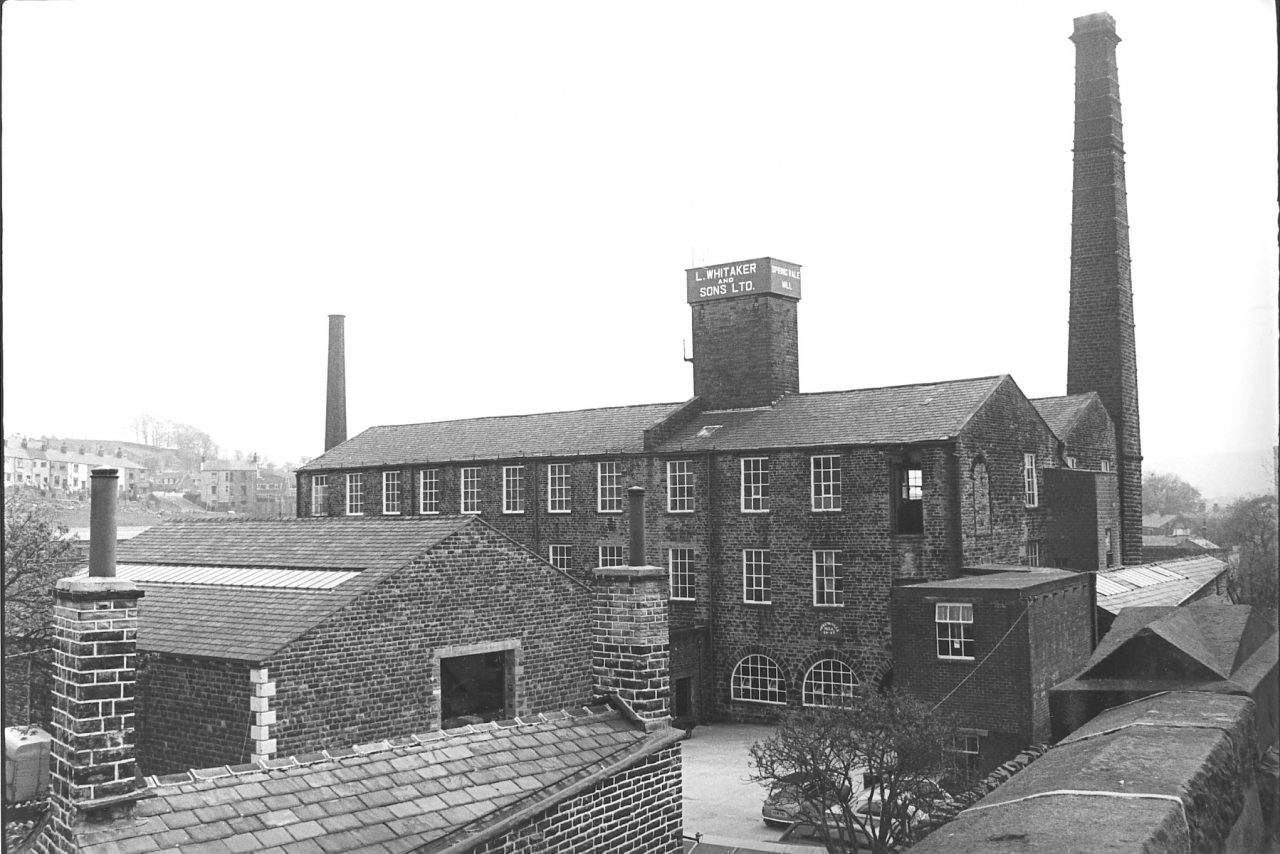
Picture number 2 is just a view of the mill from the front. The two round windows in the bottom are the arched windows of the devil hole and above are the two warehouse floors where bales are stored. On the first floor it's also the Jumbo and blending room and to the left, the block to the left is where the mule spinning is done. And at the back there is what it used to be at one time a weaving shed I should think but which in now the card room. It certainly looks like a north light weaving shed and probably was used for weaving at one time.
(100)
R- It was yes.
Was it Jim? It was ...
R - It used to be a weaving shed, yes.
Aye, I thought from the lay out Jim, I thought it must have been.

Picture number 3 is just a nice. picture of the wall, of the nameplate which gives the date 1847. I have no reason to quarrel with that because as I say, the 1846 map does show that this mill wasn't there. So this mill was evidently built on the site of an earlier mill in 1847 and appears to have been built as a weaving shed and it's now nothing but carding, preparation and spinning. Now, the first picture we come on to then, number 4, oh well, I’ll just do a quick description of this one myself.
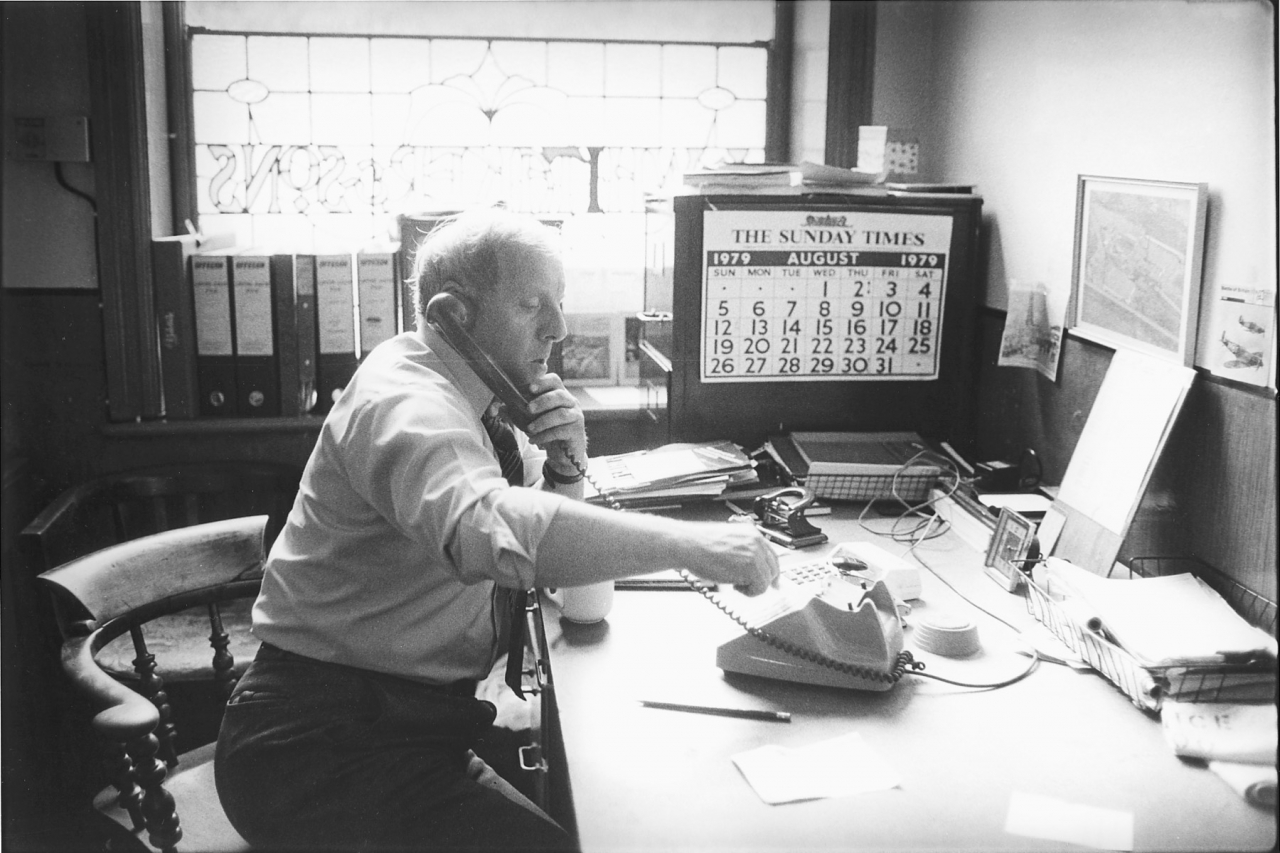
Number four is Roy Tomlinson. I should point out, I’m sat here with Jim but I'll just describe these four pictures. That’s Roy Tomlinson sat in his office. I like that picture, it's quite a nice picture, there's Blackpool Tower on the wall, there is an aerial picture of the mill on the desk in front of him and the stained glass window at the back, L. Whitaker & Sons. Nice thing, you don’t often see them in an office now. Another thing which is of interest is that there is a Sunday Times calendar hung up. For any of you in later years who know your history right well, 1979 was the year that the Times closed down and it doesn't look
(l50)(5 min)
as if it's going to open up again so that calendar in itself is a bit of history. And then we start to get into the pictures dealing with the preparation of the cotton and the spinning itself and I’m going to let Jim describe those. So I’ll pass this across to you now Jim and we start with number 5. Now then Jim, you just give your description in your own words of what these pictures are, and if I think there are any questions that can be asked I'll ask you.
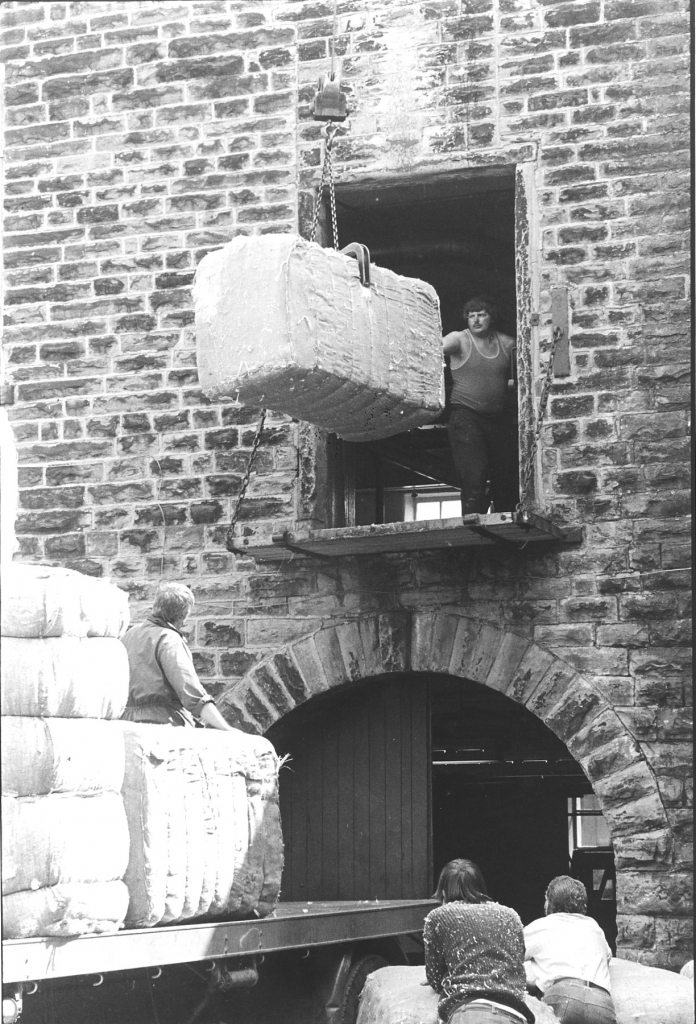
R- Well photograph number 5 is the bales coming to the mill and unloading them into the bale room.
Yes. Those bales, when they come on those wagons Jim, now they can be all sorts can’t they. Some of them will be raw cotton but some of them will be waste won’t they that's already been processed.
R- Oh yes, that's right. It's not just all one sort, they'll all be marked, each bale'll be marked what they are you see.
Yes. Now am I right in thinking that Spring Vale takes in not only waste to process, but also takes in raw cotton that’s never been used before?
R- Yes I think they do take raw cotton in.
(200)
Yes. That bale that's going up there was an exceptionally heavy bale. It's a very, very tight bale, and I'm not just sure what was in that but I know that Brian did show me some up there that had come from Russia.
R- Oh now then I don't think I ...
… and there's some in there that had come from Malaya I think there was, it surprised me the number of different places those bales had come from.
R - Oh, I didn't know they had come from Russia.
Aye. There were some up there that was Russian. Anyway, next picture, number 6.

R - There's number 6 and that's when it's coming into the room.
Yes. Now, that’s on the second floor isn’t it, where the Jumbo is to the right.
R- That's the second floor where the Jumbo is yes. That's when they bring it in before they weigh it,
Yes, they are just dropping it on the truck.
R - They just drop it on the truck and then they take it over to the weighing machine.
Aye, that's in the left hand-side of the picture here.
R - Yes that's right.
Yes. And that's Brian, what's his name? Brian …
R - Brian Finney. Yes.
Brian Finney. Yes. Now, what's the name of the lad that's got hold of the truck?
R- I don't know what he is called, he is called Jimmy but I don't know his second name, he comes from Accrington. And the other one's Roland Taylor.
Aye Jimmy. Aye the big lad, Roland, yes.
R- Well he is like the gaffer in there of everything you know. He has been here the longest as well and he knows everything there is to know about that job, you know?
Yes. And that hole in the floor to the right there, that's where the…
R- That’s where the waste goes down after it's come from the Jumbo. It runs through the Jumbo, out through the back and they shove it down that chute into the devil room.
And the devil room's underneath.
R - And the devil room's underneath.
Yes, aye. Now then, number 7.
(250)
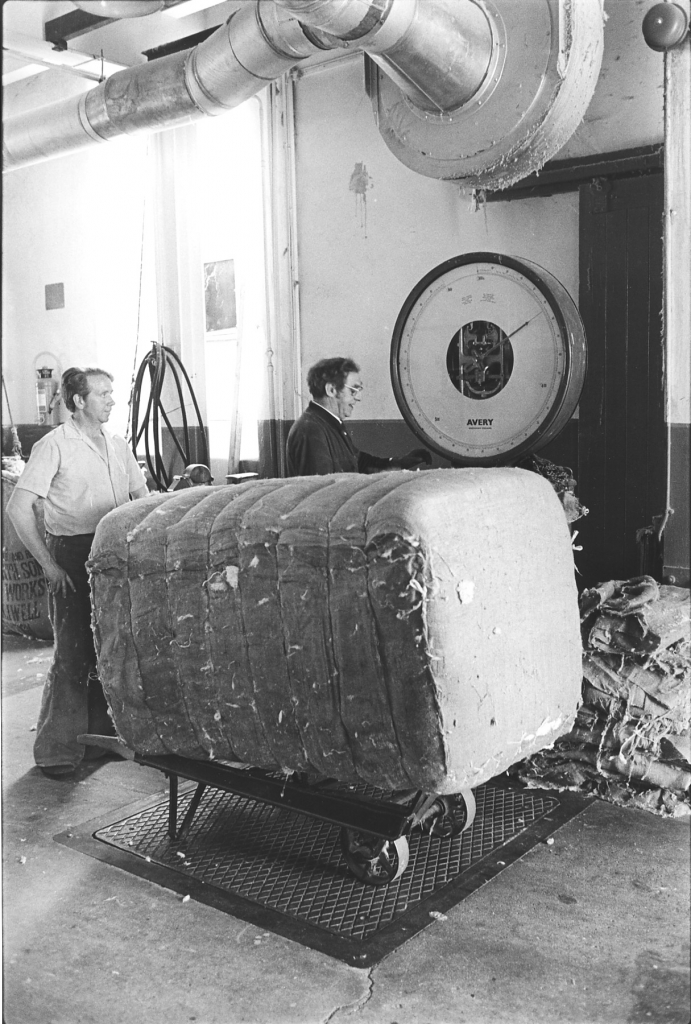
R- Picture number seven is where they’re weighing the bales.
Aye, Jimmy with his truck.
R- Jimmy with his truck and Brian weighing.
Yes. But that trunking over their heads, that's shifting cotton about isn't it?
R - Yes it is. I think that’s coming from the blending machine that.
That’s it, from the blenders yes And from the blenders where does it go to? Does that go to the baler?
R- It goes then into the scutching room.
Into the scutcher. Aye.
R- Yes it's going to the scutching room. Number 8 shows a photograph of the Jumbo, and the blending machines.
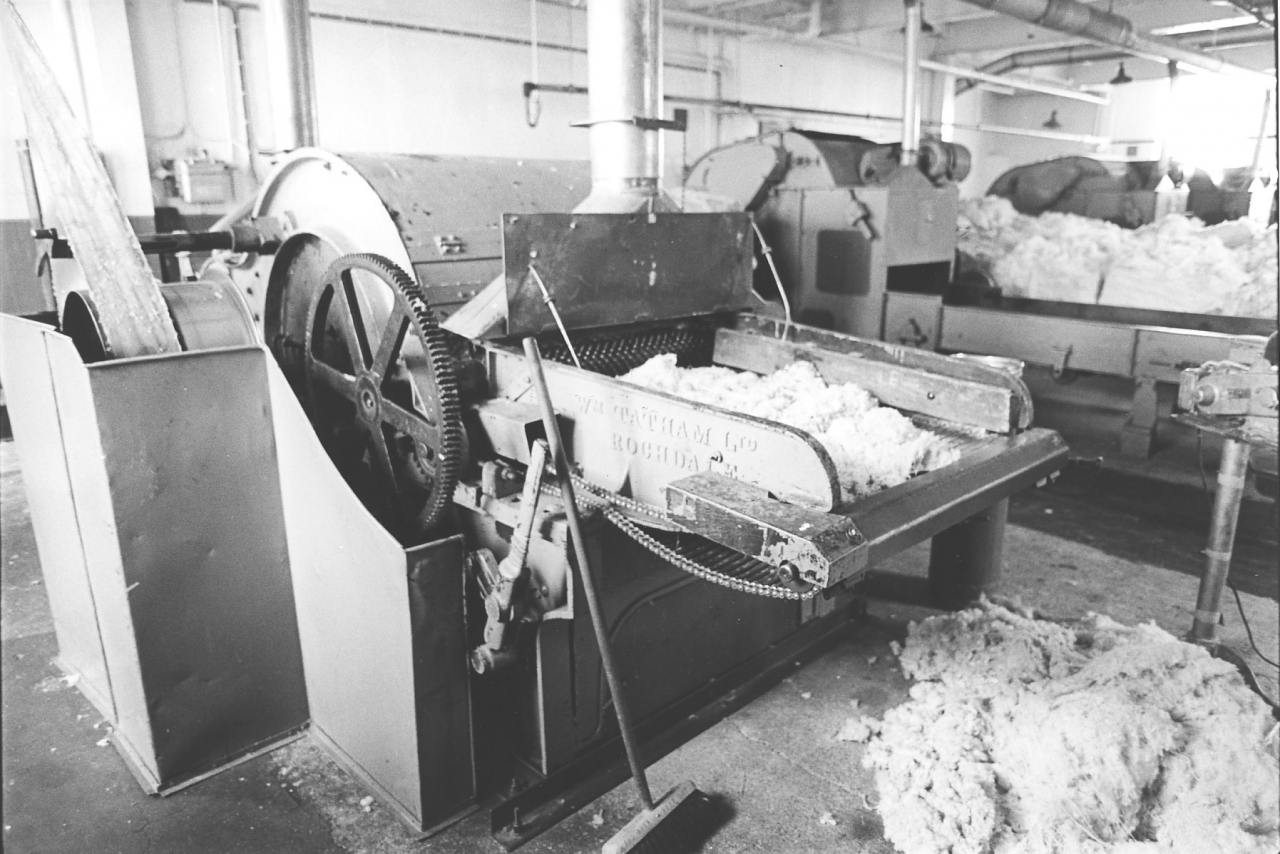
Yes. Now the Jumbo, the proper name for that Jim, it'll be a hard waste breaking machine isn’t it?
R - Yes.
Now what's the thing about the Jumbo? They were telling me, but that Jumbo, what's the sort of stuff that's put through that?
R- Do you know, I don’t know, I don't know anything what they put, I don't know what they do, what sort of stuff actually they do.
Aye. It's right. Brian was telling me that that's the machine they use for breaking all these cop bottoms up, and doing the hard waste.
R - Yes, it probably is.
And I know that machine’s, well you can see it from the size of the belt that drives it, it'll take some power to drive it, and it flies to bits regular.
R- Yes it does, aye. And the teeth what’s in, they're really big teeth to chew it all up you know. It needs them.
Yes. Tear it up, aye. I know that it regularly breaks wheels and pulleys and God knows what ...
R - Yes it does, yes.
... because they were putting some new teeth in it at the holidays and I said well, it’ll break some bloody wheels now it's got all its teeth in.
R- Yes that’s right. Well they have got it going again now. But it fairly makes some noise when it starts!
Aye it's a fearsome machine.
(10 min)(300)
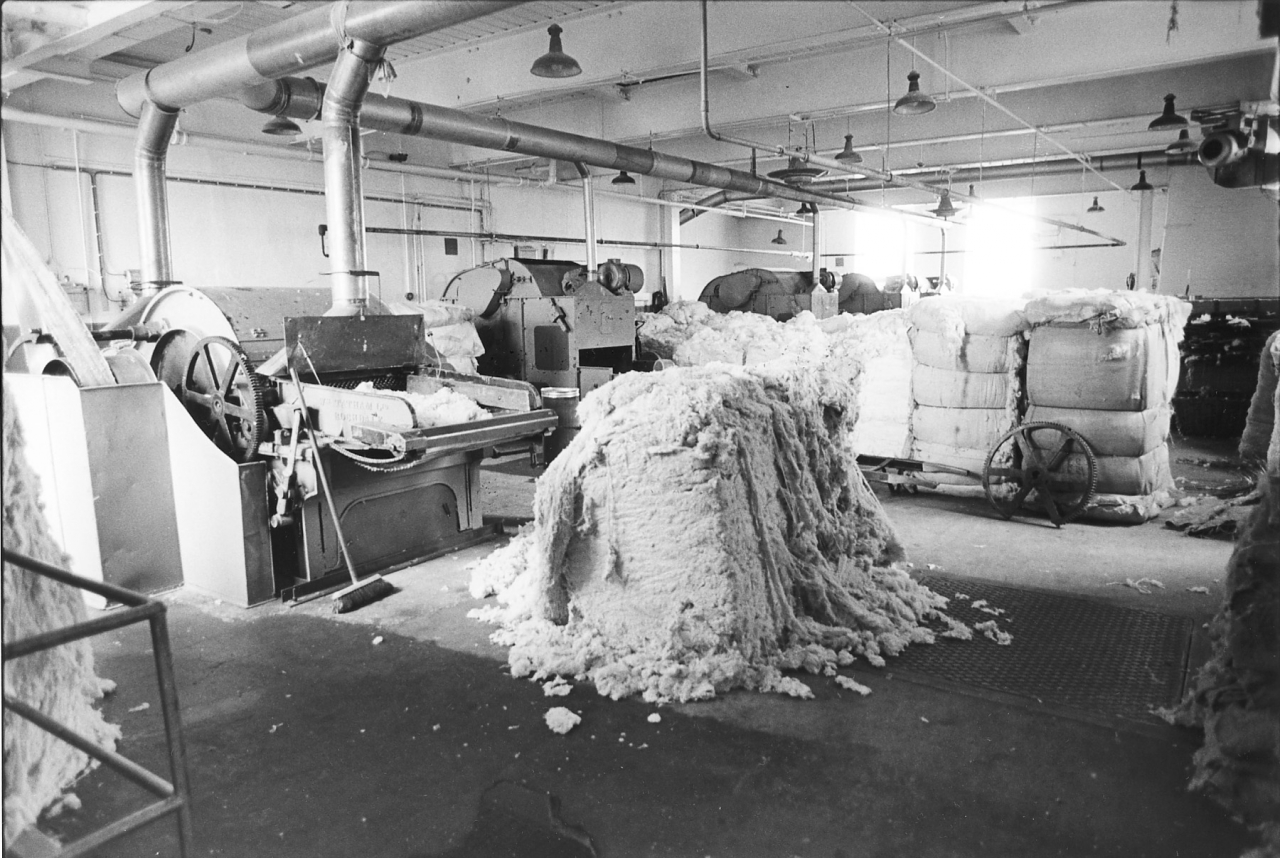
R – Yes it is. Number 9 is the Jumbo again and the blending machines and the bale what’s been taken down and opened up ready for feeding into the Jumbo.
Yes. And those trunkings overhead are taking the dust away, aren't they?
R- Them’ll be the dust extractors what’s coming from the Jumbo.
Yes that's it. Yes, sucking the dust out.
R- Sucking the dust out, yes.
Because in the old card rooms that used to be the thing didn’t it, there used to be a lot of dust.
R- Yes well there is them in our card room now, the dust stopper and that's probably what they are there on number 7 photograph.
Aye. I'm not just sure about number 7, I know one of them is shifting the waste round isn’t he.
R- Yes, that's right.
But I'm probably thinking of what goes into that room from the devils because from the devils it goes back up into the blending room doesn't it.
R- Yes it does.
And it all falls down in a bin behind. It drops down into a bin behind and then they put it through the blenders and mix it with the other stuff.
R – Yes that’s right. And mix it with the other stuff.
Yes, then it’s baled up. And then they either put it through the scutchers or it is sold again isn’t it?
R - Yes, there is some what gets fed into the scutcher and then the other is what goes to the baling machine.
Aye.
R - And number 10 is a view of the blenders.
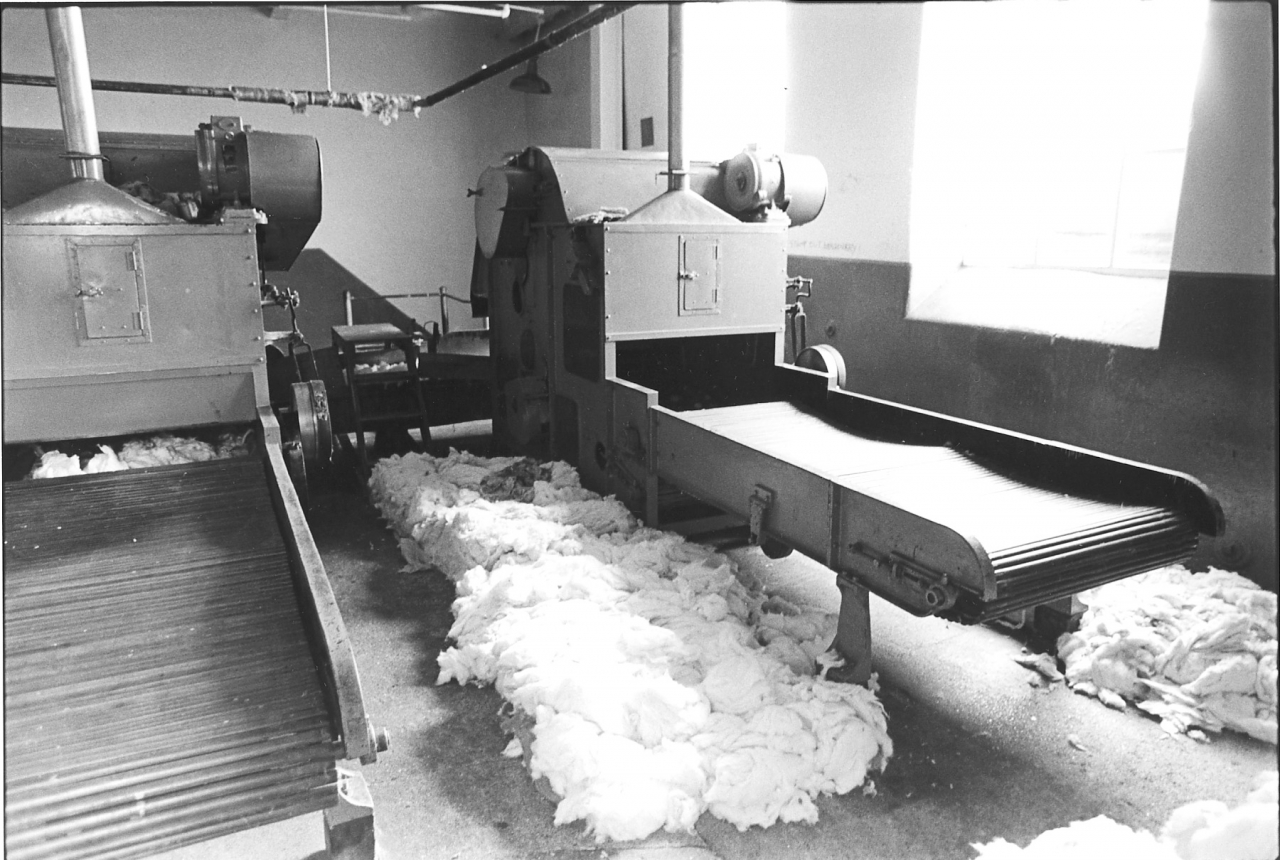
Yes. And that was taken during the holidays when they'd shifted… No it wasn't during the holidays, no it wasn't. What interested me there, I think I know the reason for it, but you tell me. Why do they work on so many bales at once?
R- I don't know.
Aye. Well they’re different bales aren’t they and they take a bit of each.
R - Oh yes I know what you mean, yes they open one or two bales you see?
(350)
Yes, to mix it up. Yes.
R- Instead of feeding one bale too much, only one, they split it all up and you have a handful out of each bale, then…
That's it aye.
R- And then it’ll not be, they can spread it out you see and then it will mix in with the other.
That’s it, and it’s mixed up isn’t it.
R- And then you’ll not get too much of one going through. Yes.
Yes. Now, picture [SVdevils] 1201 will bring back happy memories for you.

R- Oh aye. The devil room, or the devil hole they called it.
Aye, devil hole.
R - Noisy place.
Now what's the proper name for the devils?
R- I have no idea, all as I know is they’re called the devils.
Aye the devils. Well, they're like breaking and opening machines aren’t they?
R- Yes, but whether there is another name for them I don't just know.
These devils there have six cylinders, were the ones that you worked on at Goodshawfold Manufacturing Company, had they six cylinders and all? Can you remember?
R- Yes they had. There were three rows and the one that I worked on, what they call a Little Austin, that had just one. It were only a small one, but the other devils what were in three rows were just similar to these.
Yes, they have one that's only got one cylinder, one down at the back and that just takes roving waste.
R - That takes the bobbin waste.
Bobbin waste, that’s it.
R- What comes from the card room.
Yes. When you were talking about bobbin piking, that’s where that waste goes?
R- That’s right yes.
Now when you were working on the Little Austin is that the sort of stuff that you were breaking?
R- Just the same. Bobbin waste plus other waste as well. But it was mainly bobbin waste.
Yes. Because it's soft waste and it doesn’t take as much breaking down does it?
R- No. But a lot of firms didn't used to put their bobbin waste through, they used to sell it. They used to bag it up and sell it.
Aye.
R - Because it weren't just quite good enough and the spinning were bad with it. They used to bag it up and sell it you see and get rid of it because they didn’t want it to go through again you see. Because that meant there was still more bad spinning you see.
Aye, because it could just keep going through over and over again.
R- They could, that’s what we said you know. It's going through again and it’ll get another packet like that you know and so they used to bale it up, or bag it up, and sell it. But if it is pretty good stuff, there is good staple in it, then they could put it through again.
Aye. And of course the thing about the devil hole, the thing that always strikes me down there… If you notice there are two fire buckets in the middle, what happens in the middle?
R- Oh yes, they have fires. Fire’s pretty frequent in the devil hole.
Just before the holidays they had all three on fire didn't they?
R – Yes. Oh, and it gets covered in smoke this room and it’s terrible Oh I've seen them pass out many a time in the devil hole at Dunnockshaw, oh yes.
Is that right?
R- Just overcome with smoke you know. Oh it’s terrible.
It was exactly the same there at Dunnockshaw was it?
R - Just the same yes.
Frequent fires.
R – Yes, just a spark and all the lot, right down, right down the row of devils. Yes it used to just travel like lightning.
It makes you wonder how they went on with the insurance company with the devils doesn’t it.
R- Oh their insurance's very high I believe for the fires.
It must be when you come to think about it mustn’t it? It must be.
R- It was, the premium was very high. But you have got to have good men to work in the devil roomy you know, what know the job, and as soon as it starts, as soon as a fire starts then you have to take quick action because you have only a split second you know, as soon as it sparks it's down. Yes, you have got to be pretty quick.
They had one the other day while I was there, I've got a picture anyway, you'll see it.
R- Yes, it’s a thankless job. I didn’t like working in the devil hole.
(15 min)
Aye, they are always covered with dust and muck, they are.
R- Yes, it's a dirty place in the devil hole, but still it has to he done. [Svdevils] Number 38 is just the makers name of, is that the devil?
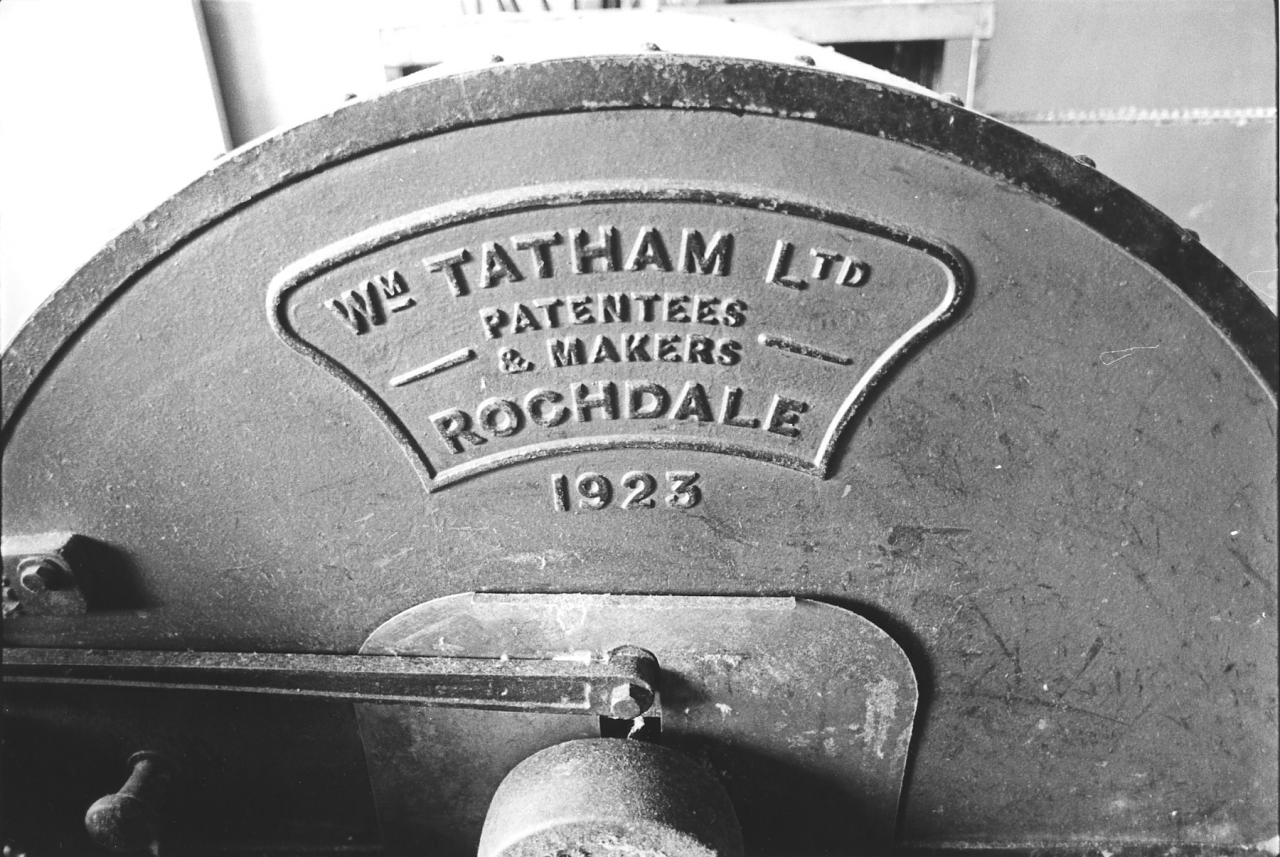
Yes, one of the devils at Spring Vale. Were they Tatham’s at Goodshawfold? Do you remember?
R- Yes.
They all seem fairly standard these machines.
R- Yes. Nearly all the cotton mills in the area had them you know?
(450)
Aye. That Jumbo's a Tatham, it's one of Tatham’s. Aye.
R - Yes it is aye.
And of course a Jumbo is very similar to one cylinder of the devil in lots of ways.
R- Yes it is.
Only it's bigger.
R – Yes, picture 0039, is that when they're putting the fire out?
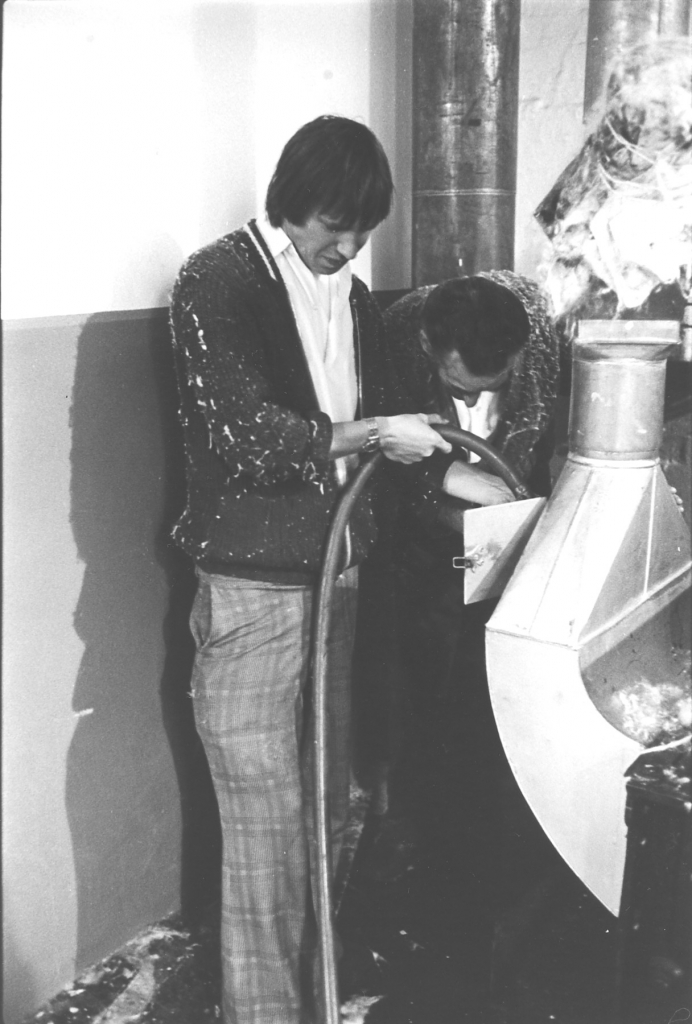
That were it, aye ...
R - They put it out and it flared up again, did it?
Aye, that’s it. His mate said, what do you call him? Is it Jimmy? The fellow in the devil hole.
R- I think he is called Stanley.
Yes but the other fellow in the corner, he is in charge of the devil hole, isn’t he?
R- I don't know his name .... Oh that bloke, he is called Billy Capell
Billy Capell?
R - Billy Capell he is called Billy Capell.
Aye well, Billy, I know him, Billy says “it’s out!” and the other bloke says “No it isn’t.” Billy says “It is!” And it puffed up into his face. He says “All right, it isn’t! Put some of that bloody water on!”
R - Yes, that's Billy Capell that is.
And they had it all on fire in the trunking, but they seemed to do very well, they got it out. By God there weren't half a smell of burning cop.
R – Yes. I know, and it goes on, it comes up you know into the room and it stinks for ages.
Aye, it does smoke.
R - And sometimes, if they have a really big fire, and a lot of smoke gets in the mule room then we have to stop the mules and go outside, open all the windows, and it gets really bad sometimes. Just the odd times, if they just don’t catch it in time.
Aye. Did you have to stop before the holidays when they had all three on fire then?
R- No. Of all time I have been at Spring Vale we've only stopped once to go outside. But at.0ak Mill at Dunnockshaw it used to be a regular occurrence, stopping the mules, because we really had some big fires there.
Aye, when you come to think there is some friction in them devils isn’t there? I mean that bloody great motor's going away all the time taking 140 Amps on the ammeter. It’s a 140hp motor and all. My God it’s some power going into it.
R – Yes. Oh, some power, yes. Picture 0040. You know what them are don’t you?
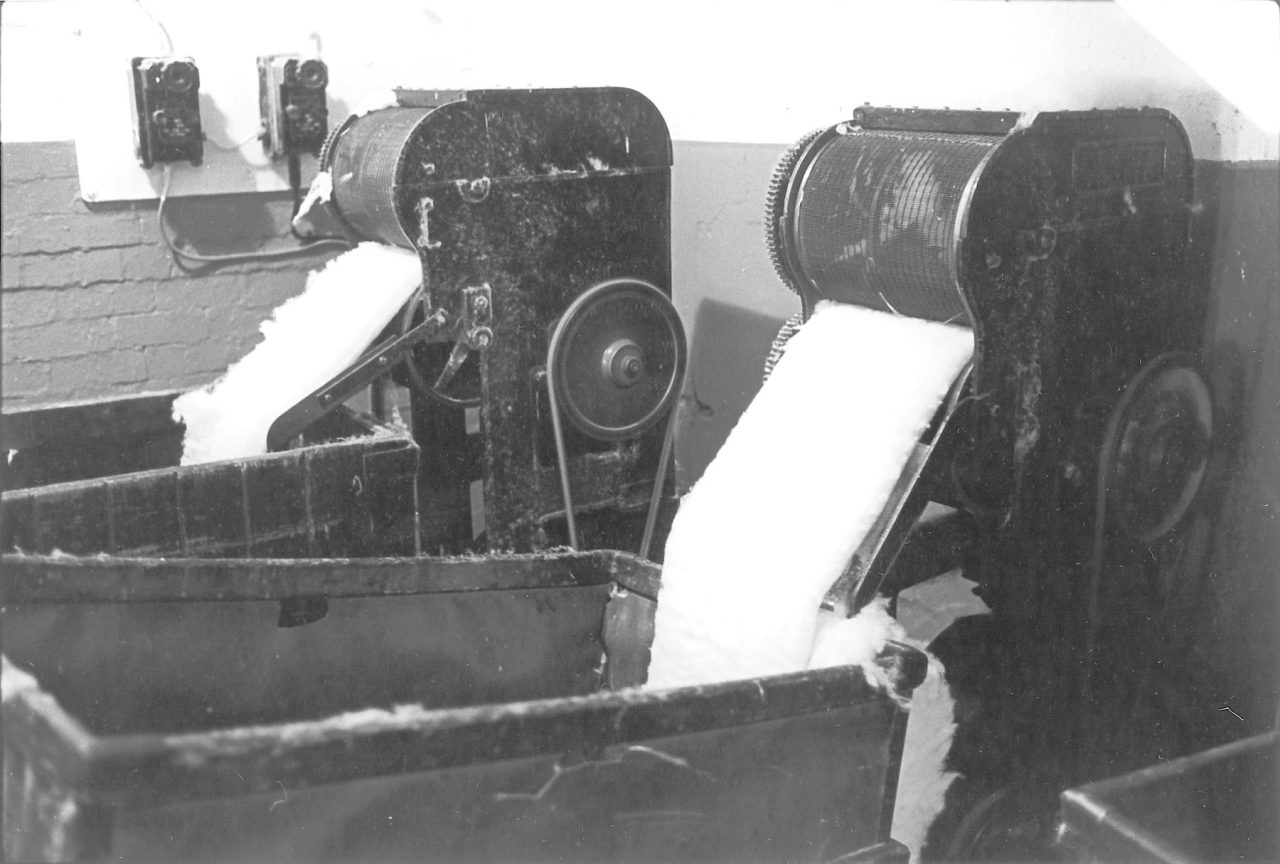
Aye. Those are some sieves in the corner that are picking all the dawn up that's coming through off the side ends on the condenser cards. Out of the trunking from the carding room.
(500)
R - What they call side ends. They are what they call side ends. The side ends on the condenser cards. It’s taken down the pipe and then out through these machines.
Yes. And then of course that goes back in with the rest of the waste that’s finishing up ..
R - With the rest of the waste. Yes.
And it's all going down, it's all going into the baler, which is the next picture, number 0041. And then it’s either baled to send out, or it's baled and it's used again. It’s stored and then used on the scutcher. But I didn't see any going to the scutcher that hadn't been baled. You know, they're feeding bales into the scutcher all the time.

R- Yes full bales what they open and feed in through the scutcher. Yes. These, on this here baling machine on the next photograph, these are just baled up and they are sent out, they have been sold have them. But they don't break them out again and use them, them’s sent away.
Yes, but they are breaking bales open to put on the scutcher.
R- The bales for the scutcher are bales what come in through the bale house. You see, on the wagon, and then they open them up and send them through to .
Aye, so that stuff that they’re breaking down in the devil hole then, that’s just about all going out for re-sale?
R – That’s going out and they’re going in these, on the baling machine to be baled up you see. That’s making a good profit at our place is that baling machine.
Aye. Opening, breaking or breaking open and then baling aye.
R - Yes. Breaking and then baling and selling them. Yes, it's making a profit on that.
Well there’s some expense on it when you come to think because by God it’s hard on the machines. It's hard on the men and hard on the insurance policy and all.
R- Yes it is aye. And they run a lot of over time on it and all doing it you know, and honestly, it's paying them.
Yes. Nice to know sommat is paying!
R- Yes well, it is paying is that. Now, [Svcarding] number 1601.
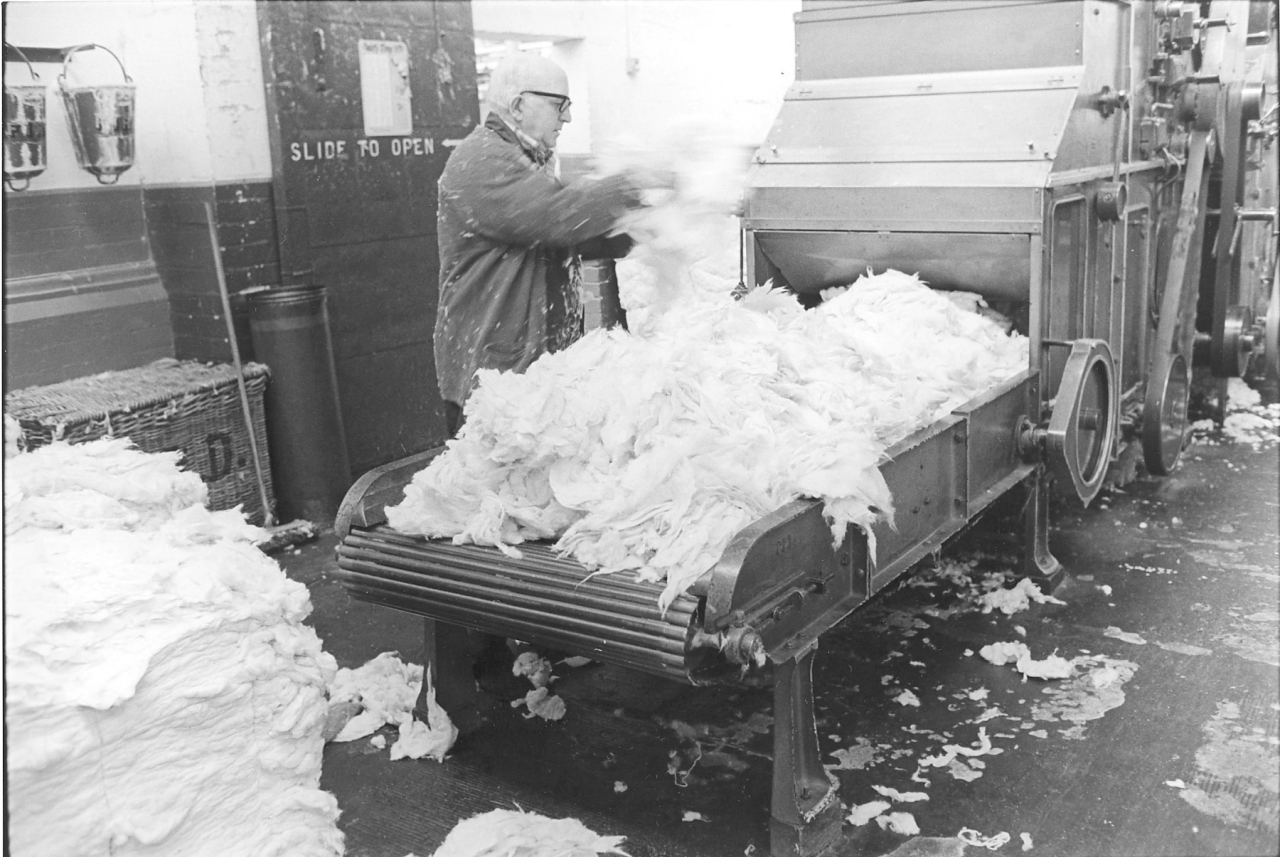
(20 min)
R- 1601 is the scutcher. I don't know a right lot about these, they hadn’t this sort at Dunnockshaw, they were a different type, they were like this on photograph 0017.
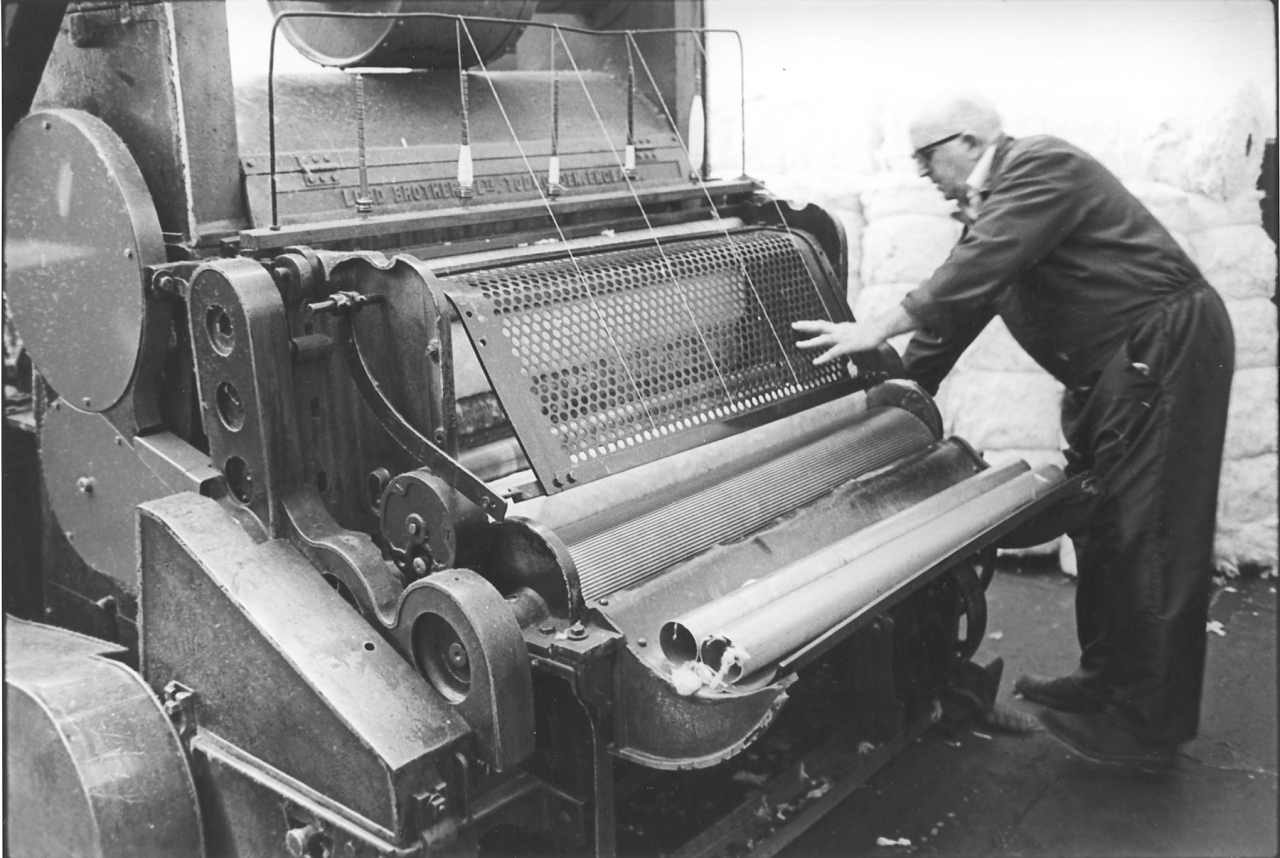
No well, aye the delivery end. Well I mean, all the scutcher is doing is taking the cotton in out of the bale and that cotton has already been opened up and broken hasn’t it. It’s been broken and straightened out and the scutcher is taking it, lofting it and making a nice even lap for the breaker cards.
(550)
R - That's right.
That can go into the breaker cards. It teases it up a bit more, and blows it about. It's opening it all up and blowing the muck out of it, cleaning the muck out of it and making sure that it’s in a good condition to go into the breaker cards.
R- Yes, that’s right.
And then on 0020 there’s, what’s his name? Pickles?
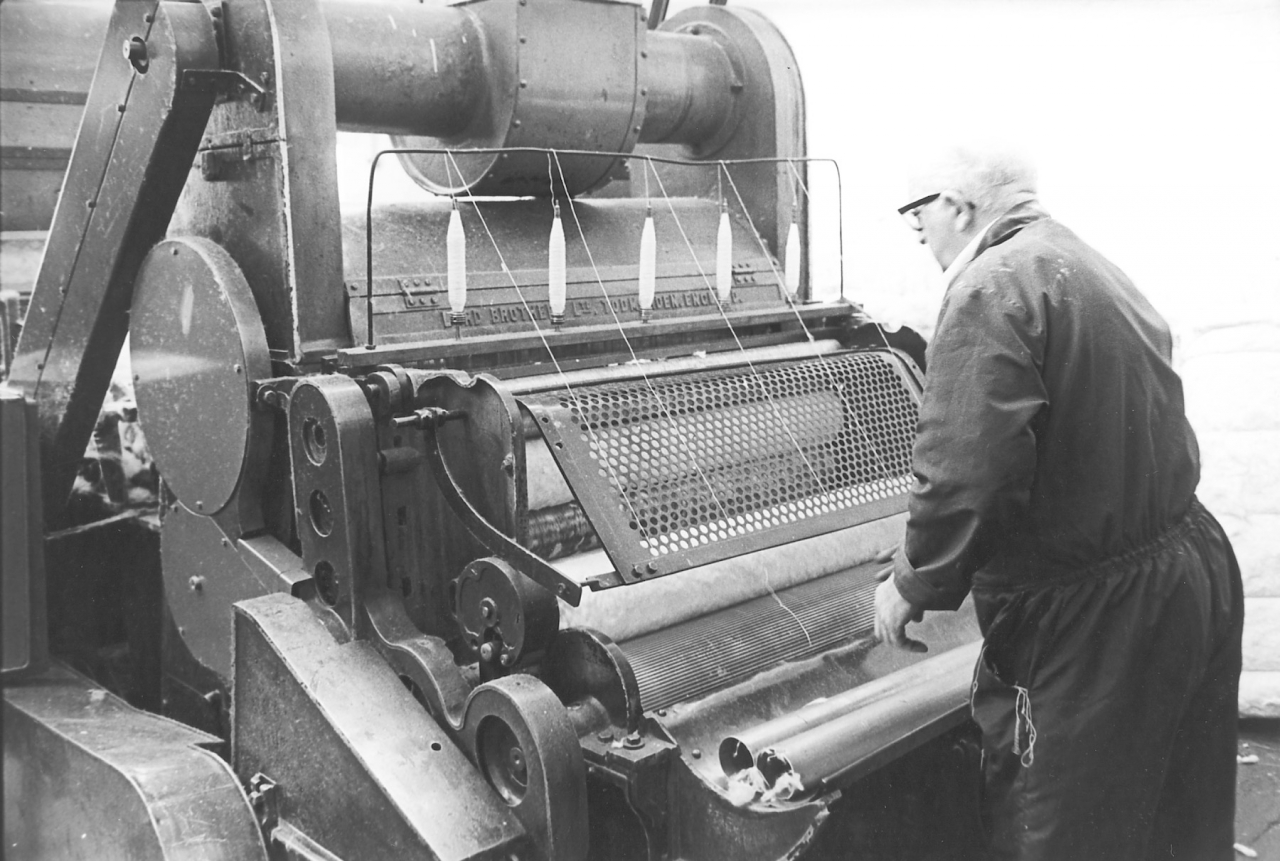
R- George Pickup.
George Pickup. Now he is just about to take a lap out.
R - A lap out yes.
And anybody that's looking at this, if you just notice there's some threads coming off cops on the top and they wrap round the lap. Well that keeps, they help to keep the lap separate when it’s unwinding into, when it’s being fed into the breaker cards.
R - Into the breaker card yes.
Which converts it into the sliver which goes into the cans which is what you were talking about when you were working on, when you were a can breaker yes?
R - Yes, a can breaker, yes. And that’s picture 0015 where he is weighing a lap.
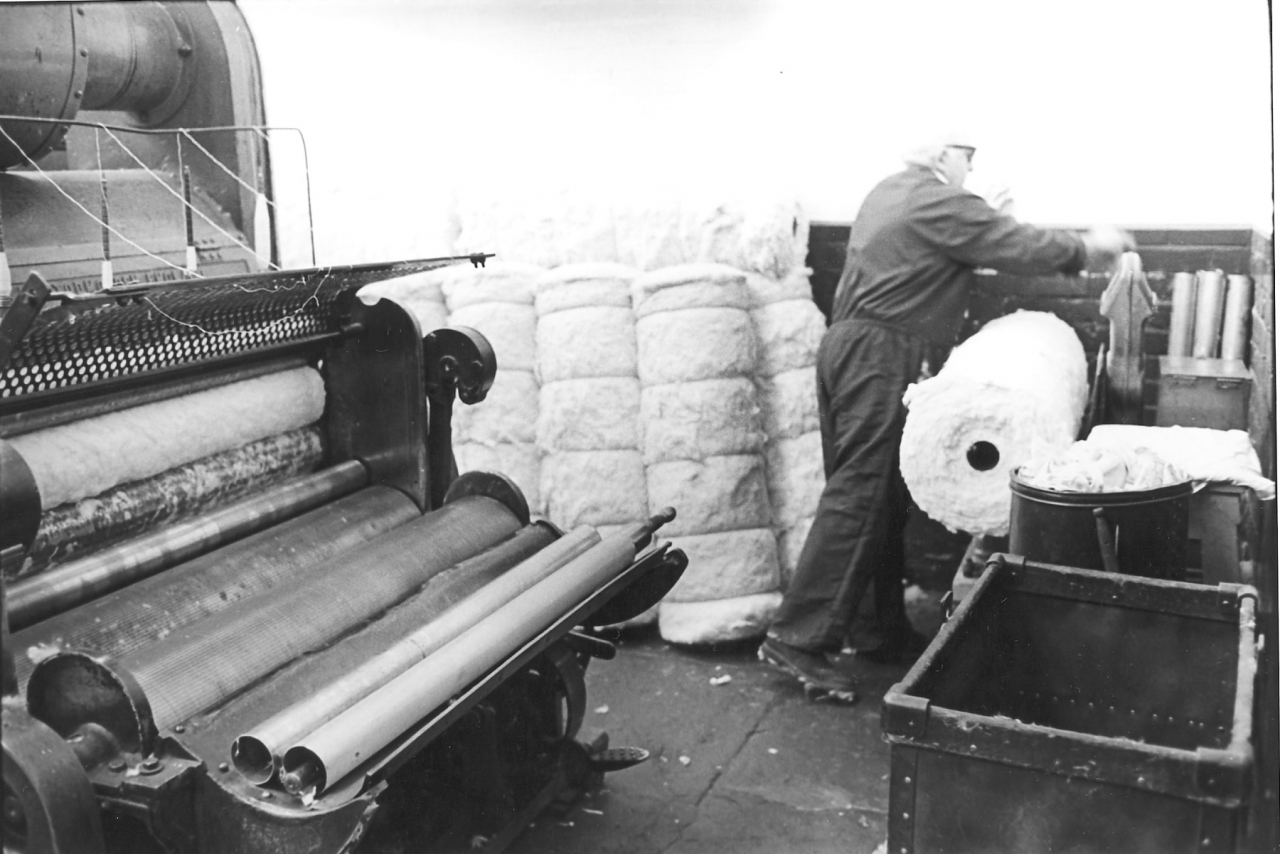
Aye, he is just weighing a lap. Now, all them laps there are worked out so they are the same weight when they come off, aren't they?
R- They have got to be the same weight, for the same weight to go through for spinning and what have you. Because if they aren’t, then they are going to have to alter things, they're going to have to alter the cards, and alter the mules because they vary so much in weight. So if George gets his weights wrong here on the scutcher then it’s wrong all through then. They’ll have to go back to the scutcher and get it right, the proper weights.
Another instance of how well one man does his job affecting everybody else down the line like the way it used to be.
R- Yes, if he knows his job then everybody'll get some good work from him. But if he is a bad un on that job then things can be really rough you know.
Yes, that’s it aye. And how does George rate? How does he do…
R- Oh he in a good scutcher tenter is George, he's done it at Oak Mill at Dunnockshaw has George. He worked there when I worked there did George.
Oh! Did he work, he worked at Dunnockshaw?
R - Yes he worked on running the big doubler at Dunnockshaw when I were can breaking for George.
Aye, Derby Doubler. Aye, a big un, aye.
(600)
R- Yes. He has always worked in the card room has George, always been a doubler. You see he has got experience, you see?
Yes, there you are. And I mean, that’s the union and all, isn't it? Card Room Association. Are the grinders in the same association?
R- Yes. They are in with it yes. Picture 0016…
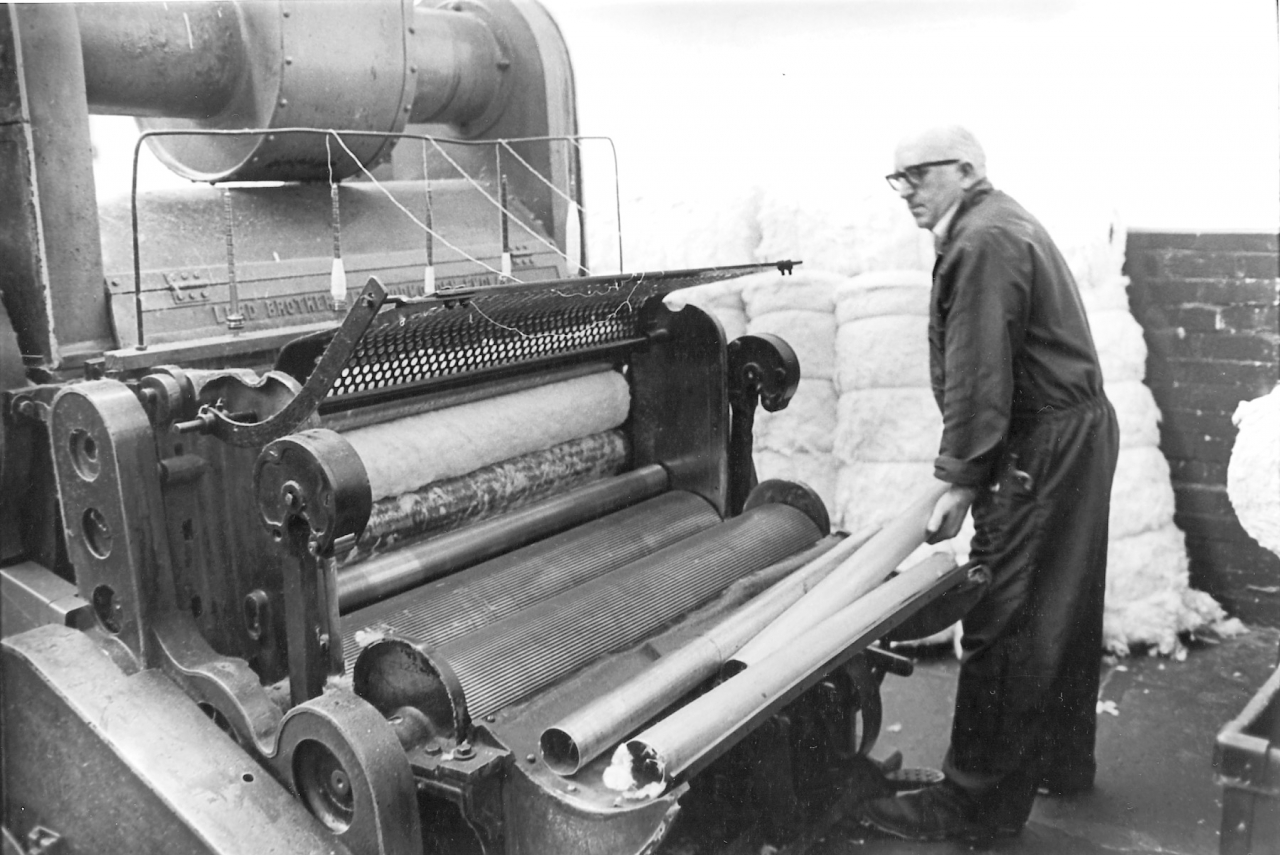
He is just putting, he's taken one lap off and he is just putting a tube in, an aluminium tube that's going to form the core of the next lap.
R- That’s right yes.
He is just going to put it in between the rollers and of course that machine stops while he in weighing the other one off. You can see the finished laps leaned up against the wall, behind him .... Aye, and then on 0017 he is just…

R- In 0017 he's put it in and put the cage down.
Yes and he is just setting that machine going, just setting the lap going. And then on 0018 he is just putting come fresh cops on, actually he renewed all those cops on top there so that he had plenty, he had some twist for the…
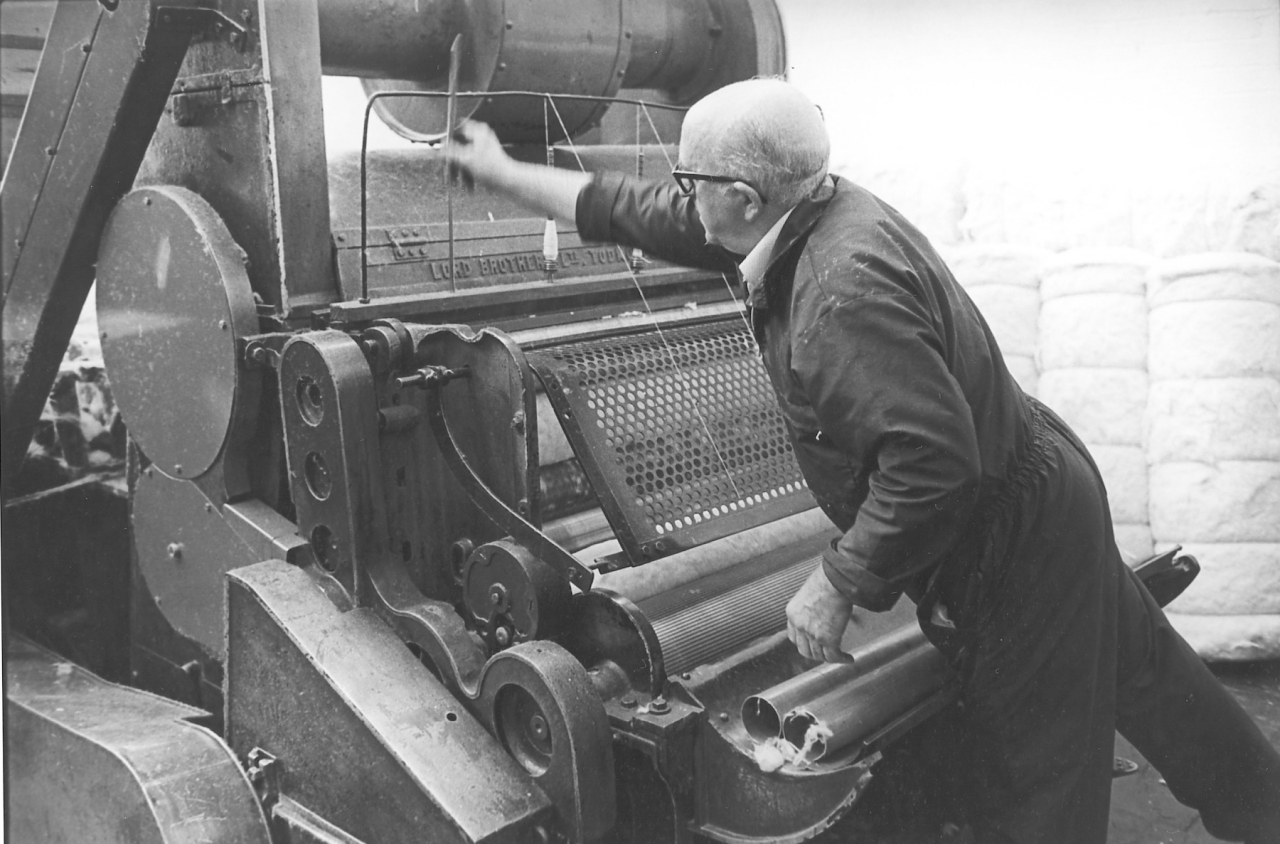
R - So that lap would have a full thread through it, you know.
Aye, a full complement of [continuous] thread aye. Because of course that helps to keep it going through in one sheet doesn't it?
R- Yes. It keeps it going through the card, stops it from breaking up and it keeps it even yes. And them cops are what comes from the mules you know? They're like reject cops you see?
Aye, are they short ones, you know?
R – Yes any rejects, normal cops what’s no good, tubes what gets broke and things like that.
Aye. And of course the thing about that is it is going through the card and is getting broken up so it’s going to be re-spun anyway.
R - It's getting broken up, yes, just the same, yes.
Aye. Recycling.
R- I was just going to say, recycling.
Aye that's it, aye. Now, there he is, he is just threading the thread through one of the holes in the guard. [19]
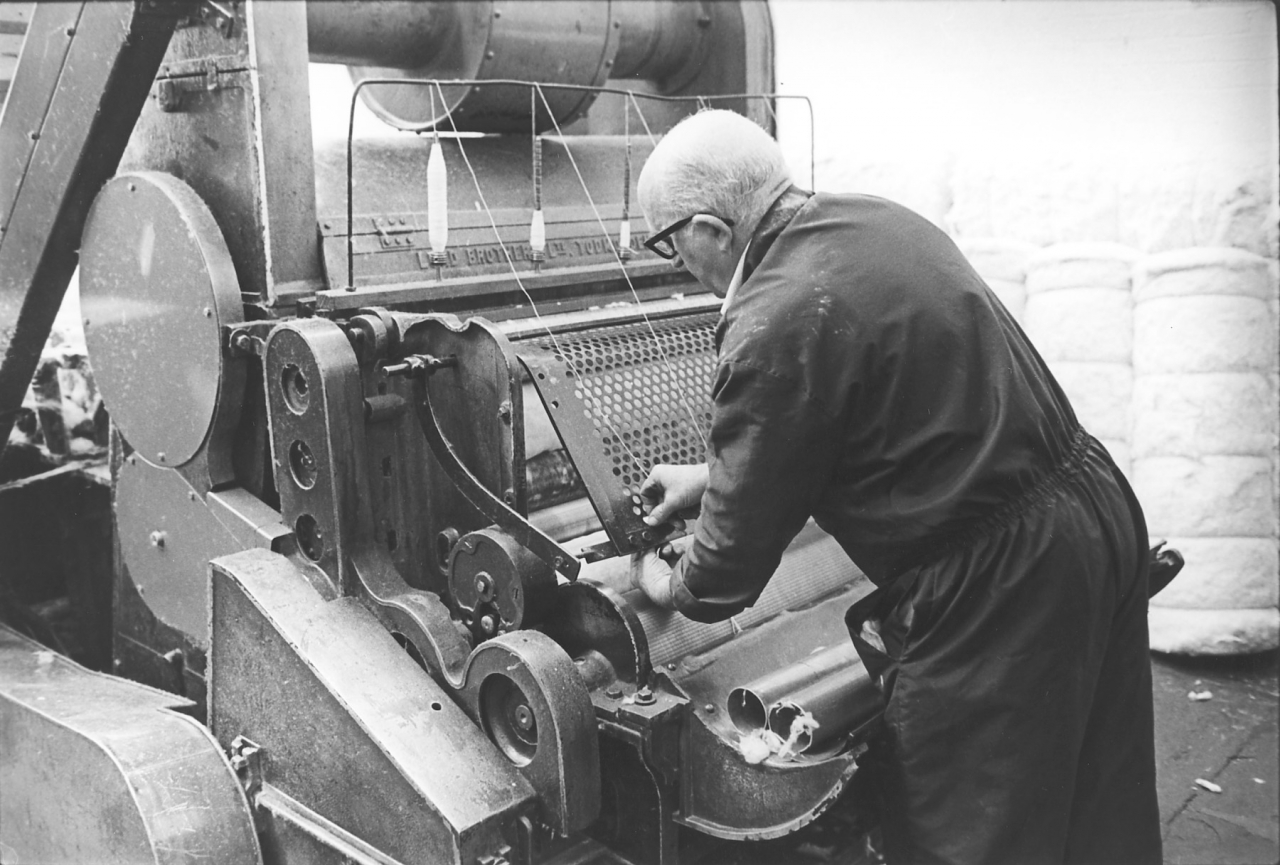
R - Yes, that's right.
And then he just chucks them down into the lap and they get picked up in the lap. Picture 0020, he’s got them all on there, he's got five fresh cops running there so he is going to be all right for a bit.

R- Yes he is ready for his lap. It'll run a few laps will them cops now. I don't know how long they take, you’re never there long enough. I don't know how long they take to fill a lap.
No, I didn’t take any notice.
R- They don't take a long while ... they don't take long.
It won't take long. I bet it doesn’t take more than what, five or ten minutes?
R- No, I shouldn’t think so Stanley, no.
No. Well it doesn't take all that long Jim. Aye, we are in the card room itself now aren't we?
R- That's him.
And, this fellow here is putting a lap into one of the breaker cards. [Svcarding] 0021
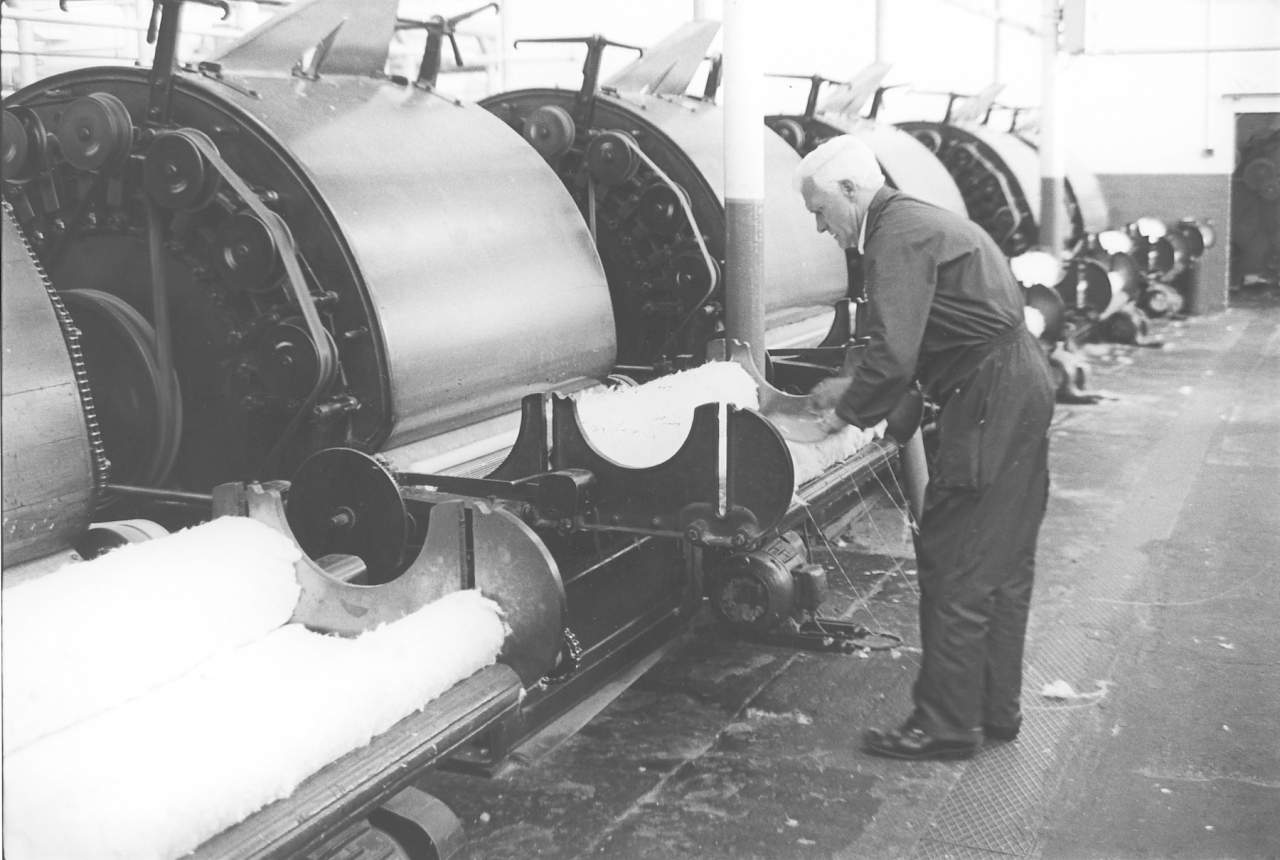
R- I know his name, he is Charlie Robinson. Now then he is one what come up from Higher Mill. They haven't been at Spring Vale so long. When they closed Higher Mill down they moved them up here.
(650)(25 min)
Aye from Helmshore aye.
R- That’s right. So he is one of them, he is a grinder is Charlie.
Aye, I have never seen them, how often do they grind?
R - They are supposed to grind every day.
I've never seen anyone grinding down here.
R - And they are supposed to grind two cards, one in the morning and one in the afternoon. And they are supposed to grind four days a week, Monday to Thursday and Friday’s the day when they do the cleaning and they look on for the card tenters while they are cleaning, you see? But they should grind four days a week.
I've never seen them grinding a card yet.
R- No well, they should do. But you see there is that many jobs they’ve to do when people's off, lap carrying, things like that, then it gets neglected does grinding you see?
Yes aye. And yet grinding's essential really for the cards isn’t it?
R - Well that’s it, it’s essential you know. If you are not getting grinding done then you are going to get a lot of shit running through and it will cause a lot of trouble. And then your cylinders are going to get blunt you see. If they are not sharpened up with the grinding you see, they are getting blunt.
Yes. As well as that, tell me if I am right, grinding levels them up as well doesn't it? It keeps them level. Aye.
R - It does. Yes it certainly does yes.
Yes. I know, I've never seen them grinding yet, because I've heard what a lousy job grinding is and all.
R- Yes it’s a very dusty job, and a lot of dust comes off, terrible.
Do they grind them in the machine or do they take the rollers out?
R- They have to take the rollers out and they have a grinding machine.
Yes, I've seen the machine aye yes.
R- At the side, for to grind each roll individually. Yes just at the side. And then they grind the big cylinder on its own there in the machine. And they put the grinding machine on the roller then they set it on and it just grinds the big cylinder. And then they have one on the front as well for this Little Doffer, what call the doffer at the front.
Aye, the doffer at the front, yes.
R- To the right yes.
And the idea of that is to get them both dead level, so that when they are working they can adjust them properly to get the best work out of the machine.
R- Yes that's right.
Because the thing with the card is you want it to be clearing the cylinder off all the time don’t you. It wants to get clear and sharp clean.
R- That’s right yes.
Yes well, he is just tearing the back end off the lap on picture 0022.
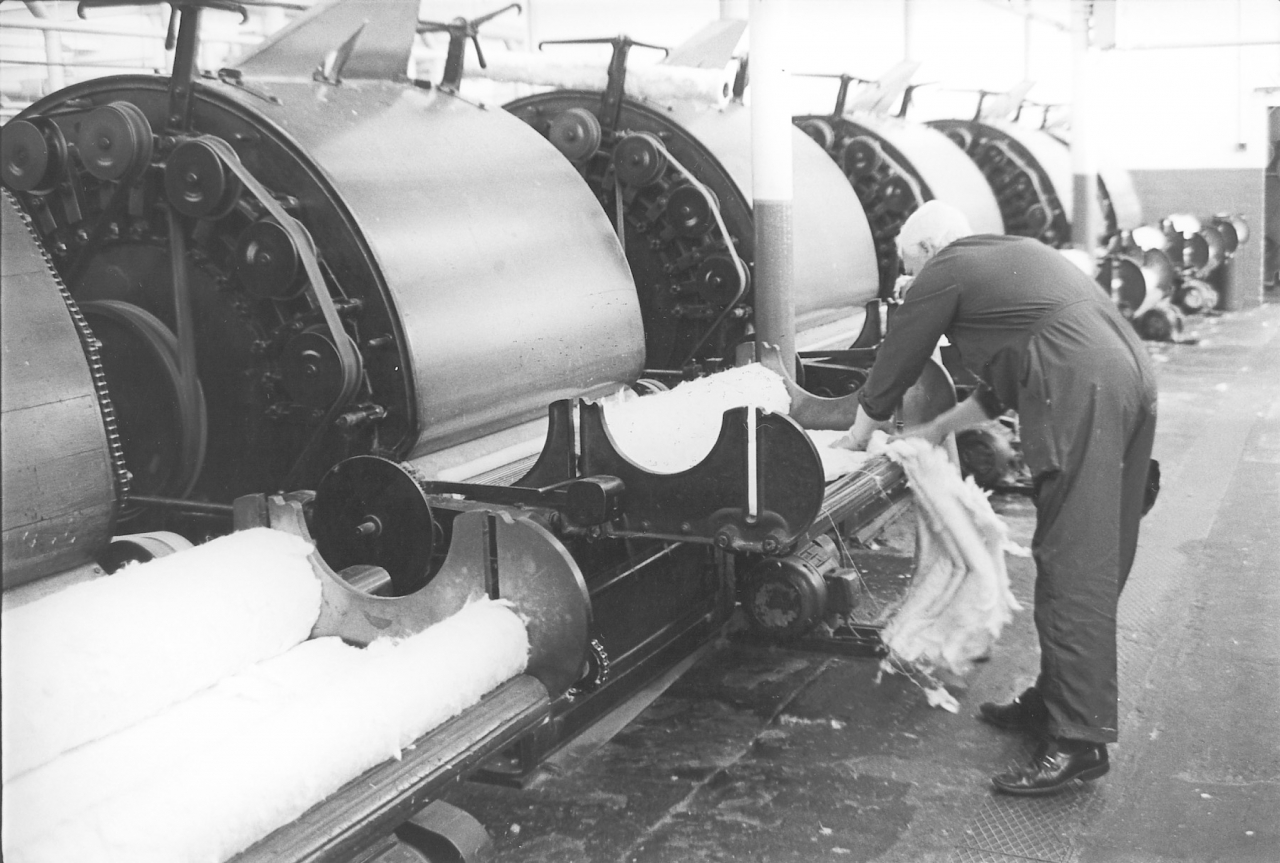
(700)
R- He’s tearing the back end of for waste yes. Ready for his new lap to be put on.
And he’s putting a fresh lap on. Now, another thing there Jim, again they feed two laps through at once don't they.
R- Yes well there’s a double lap running through isn’t there there and it meets up with your front lap.
Yes aye. But that again is another way of blending and mixing all the fibre isn't it, because you've got two going through at once.
R- Yes that’s right yes.
And another thing that a spinner once told me, not here. I've never heard it mentioned here, was that in the spinning process the direction of travel through the machine's always reversed each time. And when you think about it, it comes out of the scutcher, and the last to come out is on the outside but when it goes into the breaker is the first to come out.
R- Yes. I know what you mean, yes it is.
Now when it comes off as a sliver the last to come out is the first to go into the doubler and they say that the idea is to keep reversing the direction of the flow, because that helps it to comb and it'll straighten it out better. It helps to straighten the fibres out better if you process one way the first time and the other way the next Time. Now, I’ve never heard anybody say that at Spring Vale but it’s one of the things that I want to get on to somebody like Roy Tomlinson about.
R- Yes, well he'll probably tell you about that, yes.
And you know, and see whether that's right. Or whether it's one of them things, I mean there's a lot of things like that. I was told this tale about mule spinners having to pull splinters out of their feet every night and I said I can’t see that, they’d have more sense than to be running round on boards where they were going to get splinters in their feet, they are not silly, I couldn’t believe that. And I rather think that that's like one of these tackler’s tales you know, it's highly exaggerated.
R - It is aye.
Yes, and there’s …
R- Picture 0023.
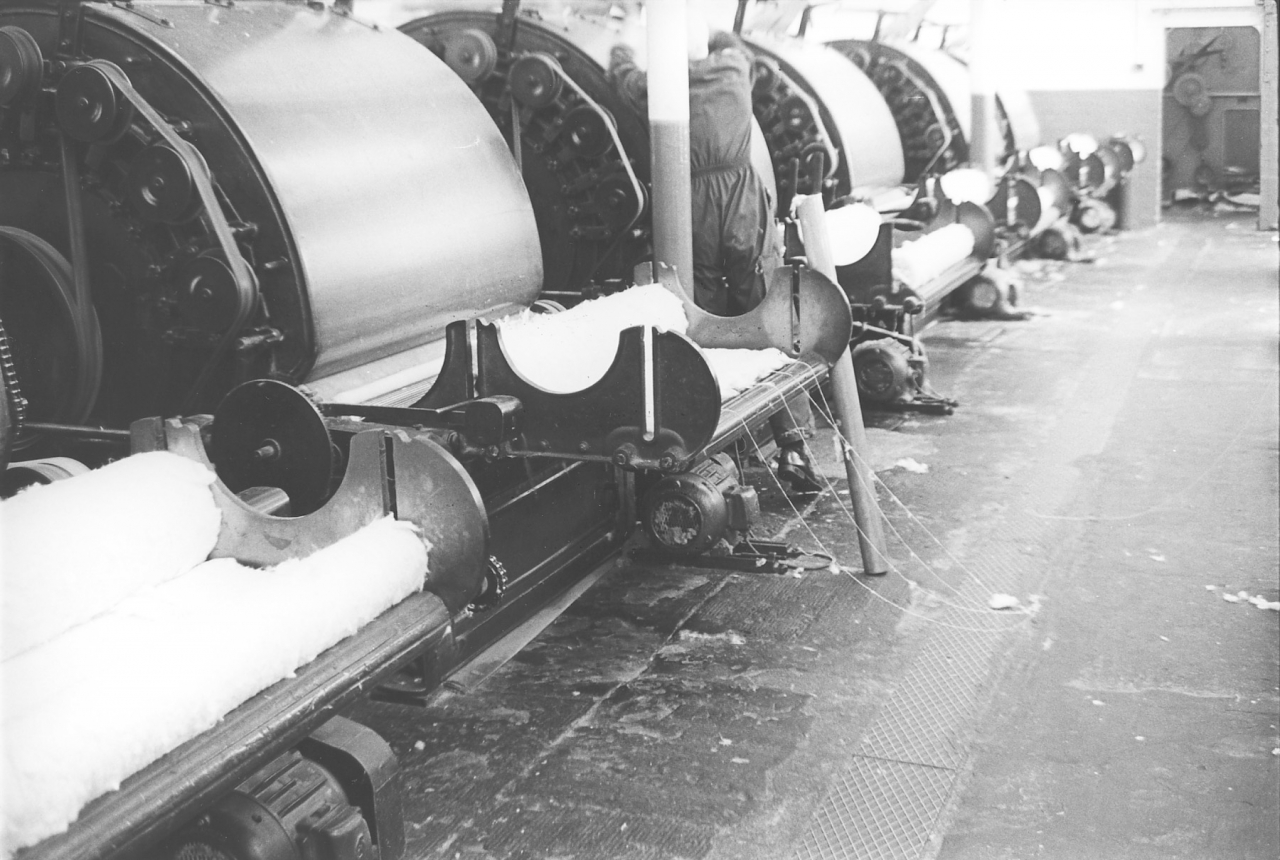
You can see the thread's hung down there, from where he's torn that lap off, the threads are hung down and of course he is going to put another on. I'm not just sure what he is doing there. He is doing something up on top of the next card, I don’t know.
R - No, I don’t know what that is.
But that picture was put in really so that you can see those threads hung down on the ground. He is certainly ready for another lap to go in there on top of that one to follow that one through because I know they keep them running through behind each other. And then here we are, picture 0024 is something that you ...
R- Yes now on 0024. He’s on the front with the can what’s running for the doubler.
(750)(30 min)
Yes, that's the other end of this breaker card we have just been looking at with the laps going in isn’t it, with the scutcher laps going in. And that's just combing it off, an oscillating comb at the front, taking it off that doffer cylinder and it comes off as a beautiful web, and that’s condensed it to a rope, hasn’t it. I love to see that coming off, it’s like a cobweb isn’t it?
R- Yes, nice isn't it. Yes, it’s nice is that, lovely isn’t it.
Like a cobweb going away from it.
R – Yes, it’s nice when it comes along there, And we used to have a lot, when you’re learning at first on can breaking you've to learn to get all that together for to shove it through a little hole. [If the web breaks] Now then when it breaks down, if you had a lap run out all that breaks off where it goes down into your can. Now, when you knew that comes through then you have to pull all this to the side and rub it together, spit on it and rub it together and feed it through a little round hole, you see? And it's got to be right fine twist and you have to shove it through there, and then thread
it through that little hole at the top, what goes into your can. And it were only a right little fine hole and you can see there’s like two rollers there and there's two rollers inside, which are similar to that but a bit smaller.
What do they weigh one of them cans?
R - What do they weigh? Do you know, I don't know.
They are not very heavy.
R- They are not no. I don’t know, this is only a small one but the others, them big ones, them’s pretty heavy is them. Them big ones want some dragging about but these are not no bad, you can carry four, two in each hand but the big ones you can only manage one and drag one behind you. But them, you can carry two at the front of you and two at the back of you.
Just put your hands in the top and grab hold of them?
R- And grab hold of them, yes.
That'll strengthen your fingers up Jim.
R- Yes. Oh you get used to them in time you know. And picture 25.
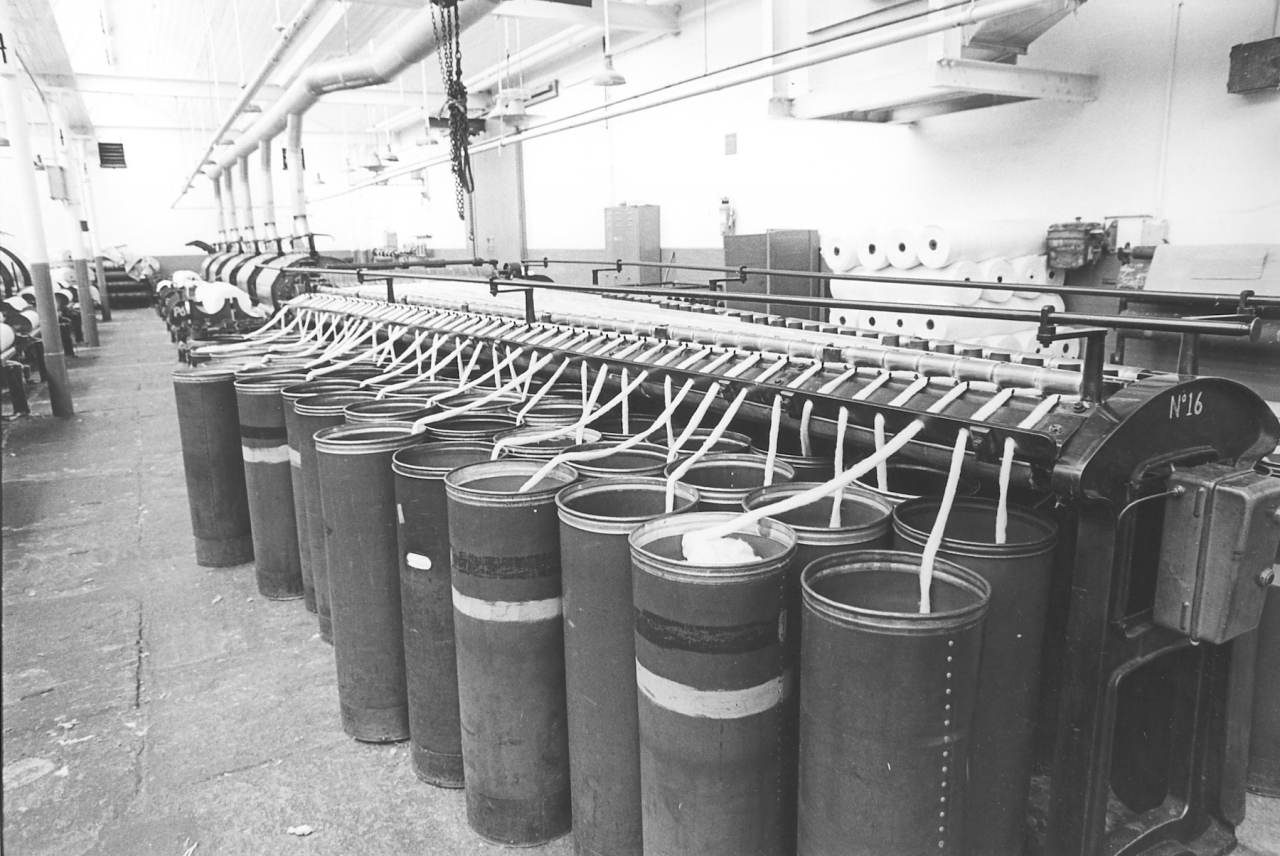
[25]
[26]
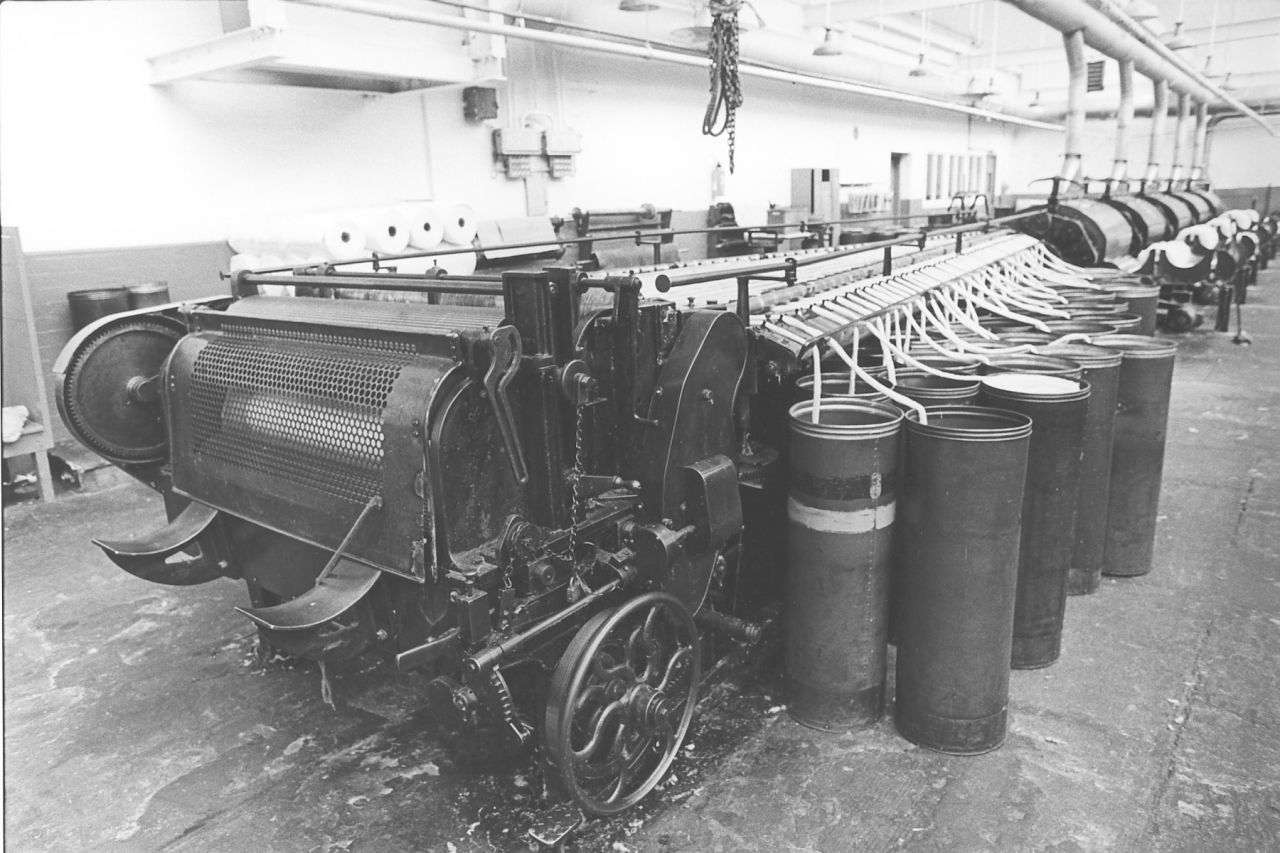
[28]
Aye, 25. Well 25, 26 and 28 are views of the doubler from the opposite sides, aren't they?
R- Two views of the doubler. Yes.
Now then, what is going on here Jim?
R- Well, the cans from the breakers are brought in and fed through into that, into the doubler, under through, under them rollers, and then down into the front of the doubler there for to make a lap.
(800)
Yes. Aye well I think if you turn over on to the next page, on to…
R - On to number 27.
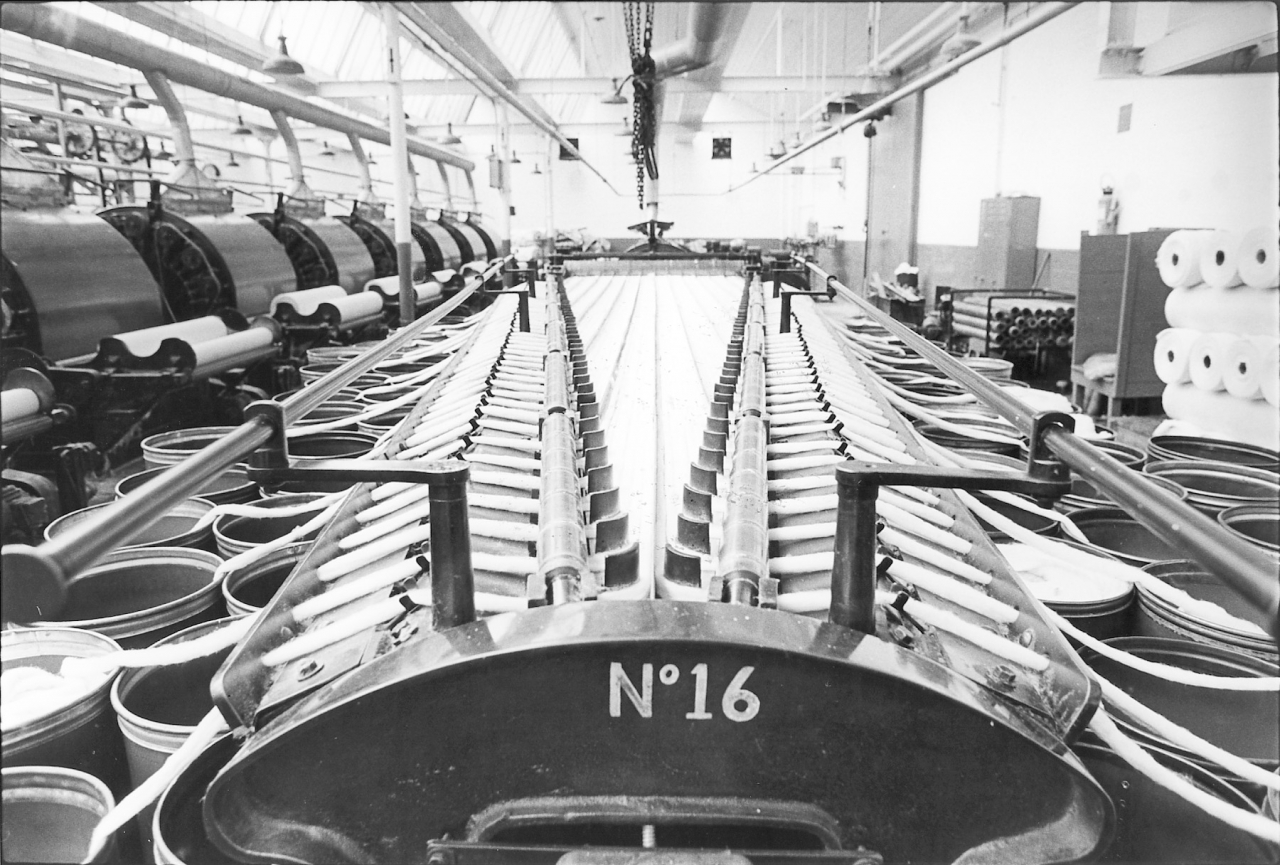
Picture number 27, it's a view from - if I remember rightly - it's a view from the end of the doubler. That’s it, looking down the doubler.
R - That's it.
...and you can see then all going in together.
R- All being fed in and running all down yes.
And there again, when you think about it, that’s mixing all the fibres together isn’t it?
R – Yes, it certainly is.
They are all going down, and it's mixing it together. And all those slivers are going down and finishing up on the roll at the front. On the next picture, number 28, you can see the front of the machine.
R- Up there ..
And that presses that lap at the same time doesn’t it.
R- There’s two big rollers in there, well there's one big un that came down and presses that down, you see, on to your shell. Inside, there's a shell inside and there is some weight in there you see and what they weigh ...
Yes, and when it comes off there's a lass there, taking the laps, and stacking them.
R – Yes. I don't know what they weigh but they are heavy them laps. Yes, which is them at the back there.
Yes, that's it aye. There is a lot of cotton gone into them laps isn't there?
R - Yes they are very tight, very tight laps. There’s a few hours running on them when you've put them on cards. I don’t know exactly how long, but at least four hours.
Yes. Now, well I think when you get on to the next picture 0029, that it shows the condenser cards where they’re… Ah well, that's looking down from…
R- That's looking down the alley.
That’s just looking down the alley, those are breaker cards aren't they, those are breaker laps going in.
R – That’s the breakers, that's the breaker laps yes.
Like the main reason I put that photograph in actually, was that there again, we have got the fire buckets. Because once again, fire is the big thing isn't it?
R- Yes. It's the big thing in a cotton mill yes. And them's essential, they have got to be there has them.
Yes, a finely devised… Yes.
R- And the fire inspectors come round regular and check them you know to see if they are full. Oh yes they are pretty strict on things like that.
Yes. I noticed there there's a piece of card on top of each one to stop the dawn collecting on them.
R- Stop the dawn collecting in, yes. Yes Picture 0033 is the front of the cards, condenser cards.
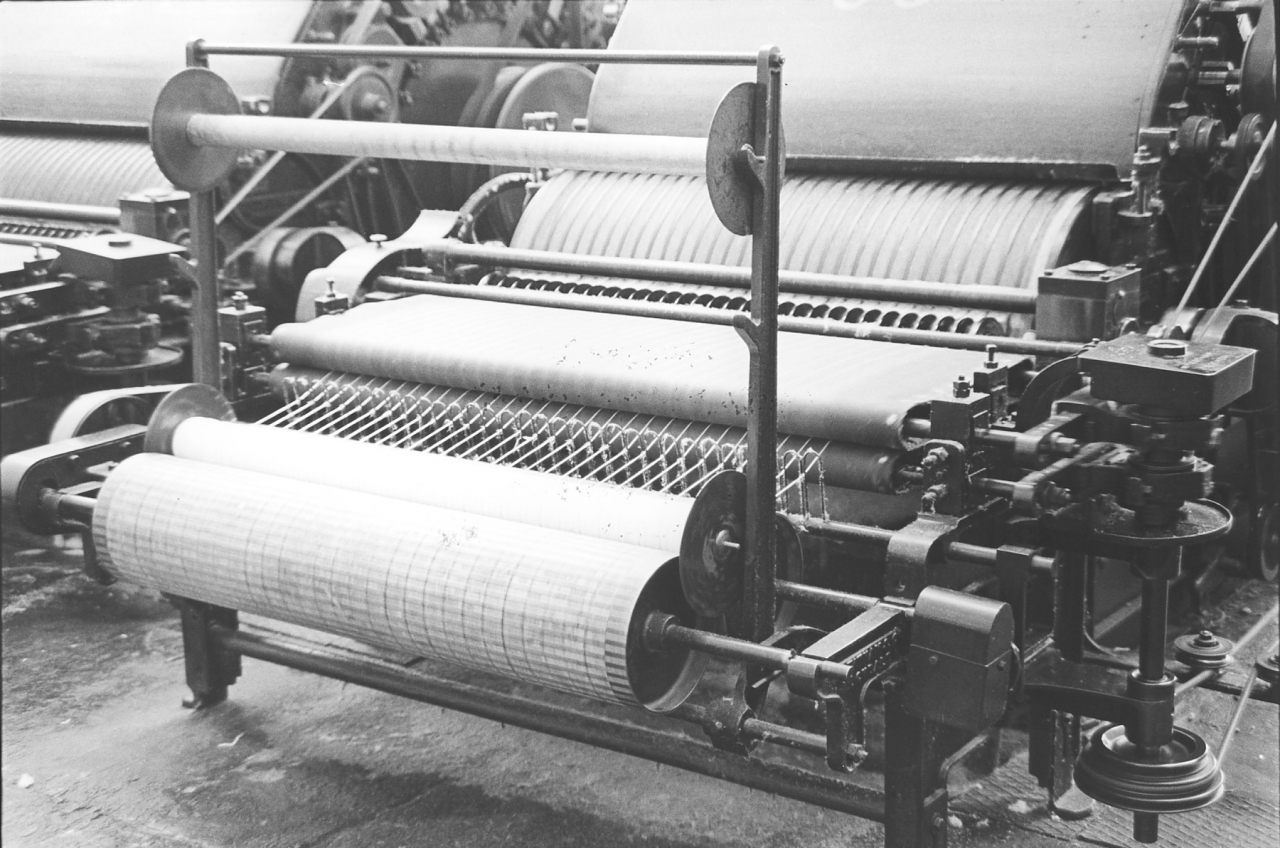
Aye. Now those, the doffing roller on a condenser card is divided up isn’t it with strips of leather.
R- Yes strips of leather on, yes. Each one represents one end what goes on to your bobbin.
Yes that's it, of roving when it finishes up on the mule yes.
R - Of roving when it's finishing up, yes.
And how many ends is there on each bobbin Jim?
(850)(35 min)
R – There’s 30 on these.
Thirty on each bobbin?
R- And when I worked at Oak Mill at Dunnockshaw there were 36 on them bobbins, they were a little bit longer, they were 36. Which in a wide span you know when you are putting a bobbin in. But on them there is 30. On some cards you’ll get 32 ends. Now then, that's where them side ends come in. They have what they call side end pipes which is the two ends at either side what don't go into the card, it's sucked down your pipe, sucked away to your side end pipes what they call the side end machine.
Aye, sucked away.
Yes because when you think about it those at each side won't be as even as those in the middle will they.
R- No, it's just sucked away and took down.
It’s sucked away and taken back into those little machines which are sieving it out.
R- That's right, although the cylinder there has 32 leathers on…
Yes there's 32.
R- You are not actually getting 32 ends on your bobbin, you are only getting 30.
No you are getting 30, that’s it yes.
R- But these all have 30 on.
Yes, that's it, aye. And that at the front of the card, there's those two big flat belts which are oscillating all the time aren't they. They are flattening, they're rolling and rubbing it ... yes.
R- They’re rubbing it together you see. That is pressure on your stuff coming through and they can alter that. They can take the belts down and rub it a lot harder and make your bobbin a lot heavier which is not good enough for spinning. It’s no good, you don’t want a hard bobbin what's rubbed because your ends’ll, you have already to put twist in the roving and when you get it in the mules, when they're putting twist in it's too hard, they fly back. So that's why we like a soft bobbin so they slacken these leathers out you see and have them rubbing just nice and soft.
Yes I've noticed that they are very soft. I mean, like that picture I have of you, which is a picture that's got to go in there. At dinner time when you are having a nap, having a sleep in the wheel gate and you are using one as a pillow, they make a nice, soft pillow, don't they?
R - Yes, they are soft, they are. Yes, well all the other spinners what I used to talk to, you know they used to say “Never have a hard bobbin, never have a hard bobbin they are no good, they are too hard. When you get twist in them they just fly back.” And that's why when bobbins come through we only need to just get hold of one, just feel at it “Oh, that’s too hard.” So we have to tell the overlooker then, will you a look through your cards, there's some hard bobbins coming down. Well, he'll just walk
(900)
along and just touch them and then he knows which they are. But sometimes it might mark the flanges, does the card tenter on the front. She’ll put the number of the card on the flange of the bobbin. If you get a heavy one and it’s happen say number 6. When it comes through to me and I'll put a number 6 in and it starts flying back I'll go and tell them that number 6 just want to take a bit of rub off. What they call a bit of rub you see?
Aye. And all those cards are numbered of course.
R - And each card's numbered individually, yes.
When you come to think, us talking like this about these pictures, I'm glad we decided to do all these pictures because you know far more than you think you think. It’s the amount of skill. It's a thing that strikes me over and over again with the textile industry and I know it’s the same in every other industry. People get the idea that the textile industry is a bit of a rough and ready operation. They are all a bit thick that work in it you know. I mean they have got to be thick to work in the mill. You know that mentality. But you know when you think about it, there's some skill, there's some skill and experience has got to go in to, well just for ....
R - There's a lot of years of learning for to be a good card tenter or a good spinner. Whatever you are doing in the mill, it takes years and years to be a good un. And like anybody can't walk in and just start doing the job because they'd be lost. They think they can do it when they look at it. They think oh that's easy and it certainly isn't.
Who pikes beams off? Because I noticed when they're coming back on the…
R - These bobbins you mean?
Bobbins rather.
R - The card tenter, they pike them.
Aye, they pike them off do they? Aye.
R - But years ago they used to have bobbin pikers to do the job.
Yes that's it.
R- Which were young lads.
Yes, you can see coming down on the conveyor there. [0035]
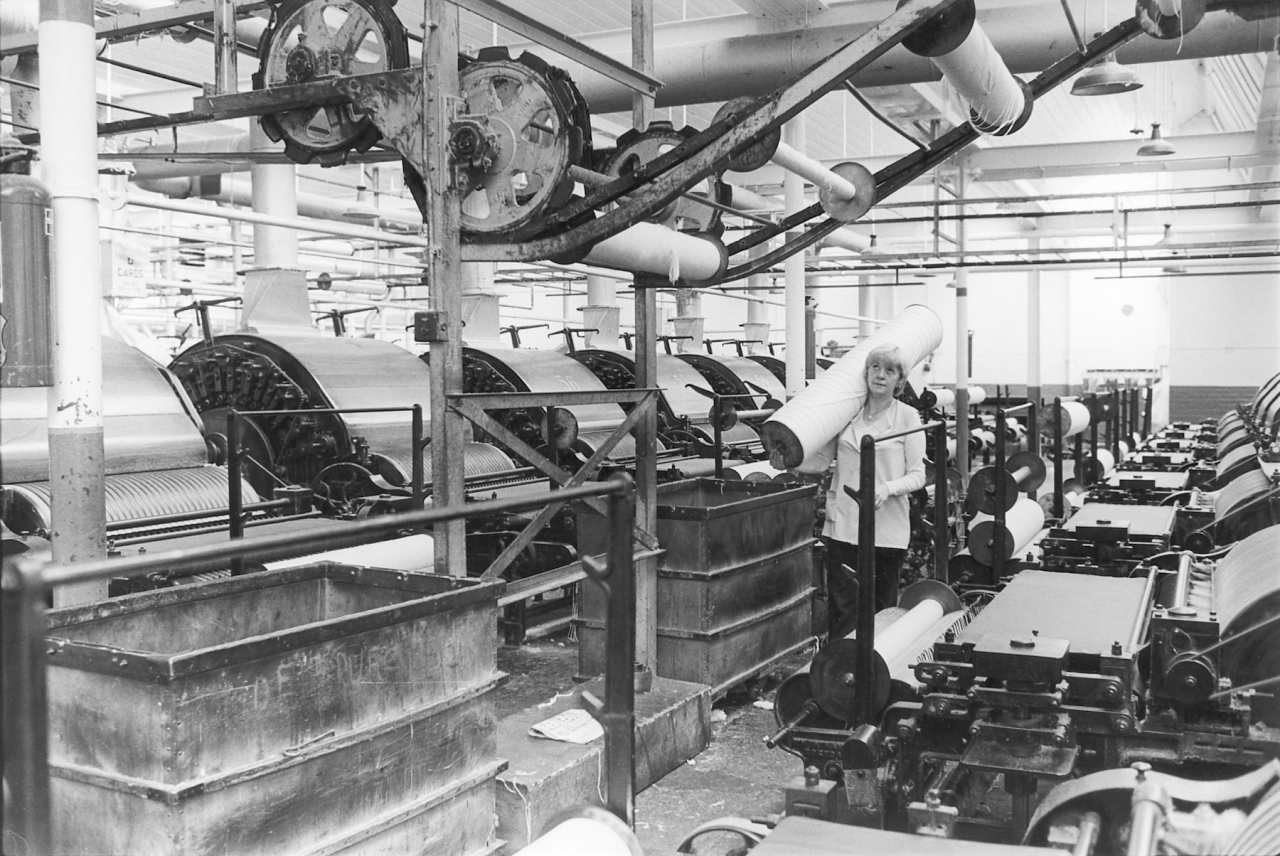
R- On the bobbin rack yes. They call it a bobbin rack.
Bobbin rack aye. On the bobbin rack, there you are. They are coming back down with the odd ends left on.
R- Yes, well the card tenter takes them off and pikes them.
Yes Tell me something Jim, while we are on about that - and I know there’s going to be a good answer for it. Why don't you spin all of the thread that’s on a bobbin?
R - Run it right off? Well for a simple reason. Sometimes when a card tenter changes the full bobbin up and they put their empty one in, well for instance, they might have had a bad bobbin what wants to come out where they get stuff in the dividers [spoiling the bobbin] and it comes through and it breaks some of the ends down. So they take the bobbin out they put their empty one in and feed all their ends in. Then they might be readying that bobbin what's been taken out, what's a bad one now, and they might get some ends what are run in, it catches your loose ends when you are readying and it goes round and that’s the simple reason why you can’t run it off. There’s odd ones you can do and a good card tenter will take the bobbin out and break their ends off and feed them in even and it’ll be straight. They take the bobbin off and walk away. Now that’s very rare is that.
So you can't rely on it.
R- You can't rely on it, no. And I’ll tell you another reason why you can't run them off. Some card tenters, if their bobbin comes back and they want to put it in and they haven’t another one available they won't pike it. They’ll take the full bobbin out, and shove the bobbin in what has already got stuff on it. Well if it comes to us and we are running then down, if that ran right out, and all those ends'll come down they'll all be missing. See, they haven't piked it off to the bare wood or whatever it’s made of you see.
But how do you know when to change your bobbin over, is it just by experience? By looking at it?
R - It's by experience, with looking at it, you can tell with looking at a bobbin when it’s going to run out.
I know a taper, I know we are dealing with different things, but back beams on a tape, you'll see the taper just go to them and he'll just knock them with his knuckle and he'll know how much there is on. Have I seen you do something like that with a bobbin?
R- Yes, I do that, I walk along and I go ... like that, and I can tell you just how much will be on that bobbin. And I can walk away for about five minutes and I know when I turn round it'll be ready for coming out.
Yes. I thought I’d seen you do that.
R - And that's the same as you said, that's my experience.
Yes, I’ve seen you do that. And I have seen the same, I know they are a lot harder are back beams with the twist on, but I've seen the taper do the same thing. They've just gone to them, just walked up and just tapping them with their knuckles.
R- Or I’ll walk past and I just tap, I just touch it and I'll know how much there is on that bobbin roughly, you know, a rough guess.
Yes. Because obviously if you let it run right off you are making a lot of work for yourself.
R - Well it's all extra work, you have to piece all them ends up again you see?
Yes, and if it’s gone off right perhaps have to thread them through the roller and all and piece your ends as well.
R- That's right, yes. It’s all experience, that's what it all boils down to.
Aye. Well, I tell you what, before we go on to picture number 34 I’ll stop this tape and go on to a fresh tape.
SCG/14 July 2003
8,445 words.
LANCASHIRE TEXTILE PROJECT
TAPE 79/SD/07
THIS TAPE HAS BEEN RECORDED ON AUGUST 16TH 1979 AT 26 HARGREAVES DRIVE, RAWTENSTALL. THE INFORMANT IS JIM RILEY, MULE SPINNER AT SPRING VALE MILL. THE INTERVIEWER IS STANLEY GRAHAM.
We are going straight on now with the description of the pictures in the Spinning Folio, starting with picture number [Svstripgrind] 3964, Now then, 3964 Jim.

R- Well them are condenser laps.
Aye, and those are the laps going in.
R- What's come from the doubler, what's going in to make them bobbins.
Yes and it's good to see, just by looking at those, that they are a lot tighter and tidier and heavier than scutcher laps.
R - Yes they're, they are a good firm lap are them.
And how long do you say a couple of them laps'll last on there?
R - They, these types they are on, they’ll do about four hours, five hours. Yes, they run a long while do them.
Aye, aye. And one thing I noticed in the card room, and I know probably that somebody that worked in a card room in the old days would say that the floor were mucky but they always keep it tidy don't they, they keep it fairly tidy.
R – Yes, it’s a pretty fair, tidy card room is this. I have been in a few card rooms, and they have been really dirty; but this card room, it's pretty fair you know?
Tell me again, what might seems a silly question. What are the advantages of keeping a card room clean and tidy?
(50)
R - The advantages?
I mean, why in it better? Why is it better to have a card room clean than to have one mucky and with dawn all over the place?
R - Well it's better for you, for working in the conditions. There is such a lot of dust about you know and it’s better for yourself for to keep sweeping it up. I know some card tenters don't bother about cleaning them up, you know, they just do it once a day. But it's probably a lot healthier if you tidy up you know.
I've seen them, I've seen card tenters go down there and, especially that fellow that you were saying came down from Higher Mill, Charlie Robinson. He is for ever going on and just wiping the dawn off.
R – Yes well he’s a good card tenter. You’ll see them do that regular, wipe all the dawn off the cards while they are running, a good card tenter, one what's been brought up properly, Yes.
Aye, brought up the old fashioned way.
R - The old fashioned way. Doing the proper things what should be done, like sweeping under your cards and what have you where all the dawn settles. They don’t bother today don't some of them, only do it once a day some of them. The old card tenters, they used to do it twice a day about 11 o’clock at the morning then again about half past two, going up to three in the afternoon because there’s such a lot of dawn comes off, drops off your cylinders you know and then it…
(100)
Then of course, apart from anything else it's such a hell of a fire risk isn’t it.
R - Well, yes that’s another thing, yes.
Finely divided cotton like that, it's very nearly explosive isn’t it.
R – Yes and it’s very dry.
Yes. I know in the weaving shed it were the same. I'll tell you what I’ve heard the tacklers saying in the weaving shed; in the days when there used to be gas lighting, when they went in to light the gas jets at night, many a time they used to get a flare on the [roof] beams from it and it just used to run like a flickering blue light. It just used to go the length of the shed along the beams. All the dawn that had settled that day just caught fire but with it being clean there were very little there so it just burnt up and went out. But it just flashed on like that. It’s like dust, I’ll tell you another place that's the same, proven mills and flour mills. Flour in the air is explosive, it can actually explode and I have no doubt that cotton's the same.
R- Just the same, yes.
It'll burn that quick, it's such a fast fire that it's an explosion. It’ll blow the windows out. Aye.
R- Yes it does.
Anyway, [Sv carding] 0032. Now then.
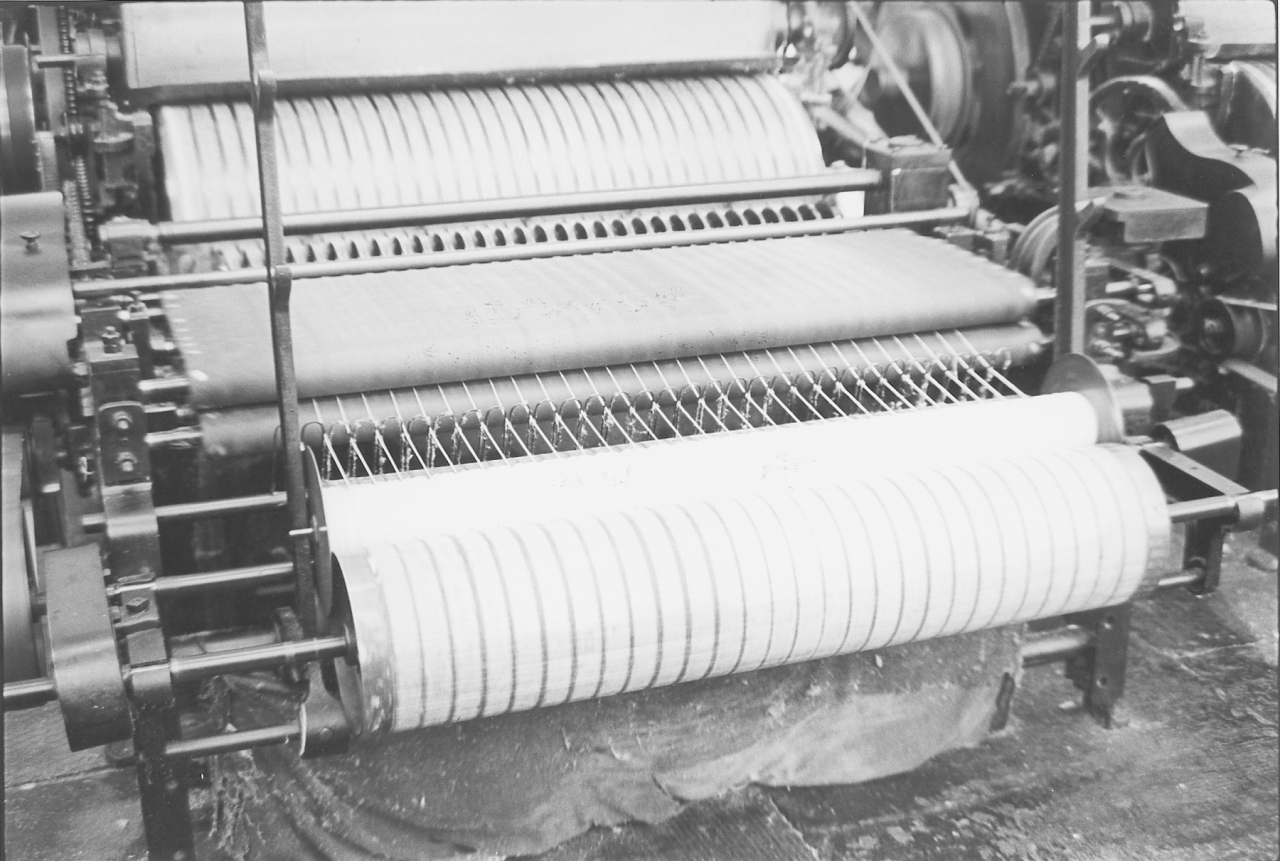
R – Ah, that’s the front view of your bobbin what's being made.
Yes. Now, I tell you what we can see on there Jim now I come to look, you can see how at each side, the outside side end looks bit whiter on the doffing cylinder because there in no comb working on it, it’s only sucking.
(5 min)
R – That’s where it is yes.
Yes. So there's no comb working on that, you can see where the comb ends there anyway can’t you? And then you can see the little jets.
R - Now there is a little pipe there what goes down to the floor and then it's sucked out.
Yes. It’s sucking now, it is sucking that off at the inside.
R - Sucking that off, yes.
And it comes, the ends come down between those two big flat bands.
(150)
R - There?
Yes, the condenser, what do you call that, what’s the right name.
R- Well, they are called rubbers.
Rubbers? That’s it yes. What are they made of? Are they rubber?
R- No, it’s leather.
Leather? Ah, it's leather.
R- Some of them what they make to day are like plastic you know? But, you don’t grease them, being plastic ones. But them are proper leather, and them has to be greased has them.
When you say greased, what do you mean greased? Well obviously you grease them, but what with?
R – With oil.
Neatsfoot oil, is it?
R- I’ve forgot what it's called now. No, not Neatsfoot
Whale oil?
R – No.
Sperm oil?
R – No. I forget what it's called now, it’s just ordinary grease you know. It’s thick stuff, and they feed it on, put it on to the rubber when it's running, and it works its way around both of the rubbers.
It's something like dubbing isn’t it?
R – Yes, it keeps it right soft you see. And then they leave it overnight then to dry out.
Now there again, that bobbin's getting pressed isn’t it, by that roller at the front.
R – Yes but there is two rollers isn't there? One at the back of the bobbin and one at the front which is going against, they're running alternative aren't they?
Yes.
R - You see? It’s rubbing it together on to the bobbin. But the same as I've said before the hardness of your bobbin is not with them rollers at the front, it’s done by the leathers there.
(200)
Aye, that's it yes.
R- It’s your leathers what control you.
What pressure your rubbing leathers are putting on it, yes.
R - And you can alter them also with these little screws there on the side.
Aye, at each side of the rubbing leathers.
R - That lifts this top leather up you see, the farther down you take it the more rub you're putting on, and the farther up you bring it you’re taking it off.
Aye, it takes it off.
R - And you've to take each turn, each screw off equal.
Aye, the same each side.
Because if you don’t then you are going to have your bobbin sloping.
You are going to have it hard at one end and soft at the other. Yes, aye, that's it...
R- Yes, and soft at the others. And when you’re putting it on the mules your soft at one end is going to climb, your ends climb your other that's come through straight and hard. Your top where it's slackened too much, then it's too soft and it climbs. And if you look at a bobbin you can see and it slopes like a hill.
Yes. It's one of the things I keep on about, there’s so much to it.
R- Yes, there's a lot of little things you know. You know, they're part and parcel of the job, and they’ve got to be put right you see?
They make the difference between good spinning and bad spinning don't they?
R- That’s it, yes certainly. Picture 0033. That’s another one.

Aye. Now 0033, that's another view of the same machine from the front.
R - That's the empty bobbin at the top waiting for the bottom one to be filled up.
Yes. That one's been piked anyway.
R – Yes. These are aluminium shells on these bobbins, aren’t they? I think them are aluminium, there is some wooden ones, but I think they did away with a lot of wooden ones and they've got all aluminium because the pikers, well the condensers were getting spells in their fingers and so they got rid of them you know.
That’s it, aye.
(250)(10 min)
R- And then also there were lumps of wood used to come off, and go into the stuff and then it used to come into the bobbin, and then up into the mules and break their ends down. So they did away with all the wooden ones and got aluminium ones.
0034 shows Glenys….
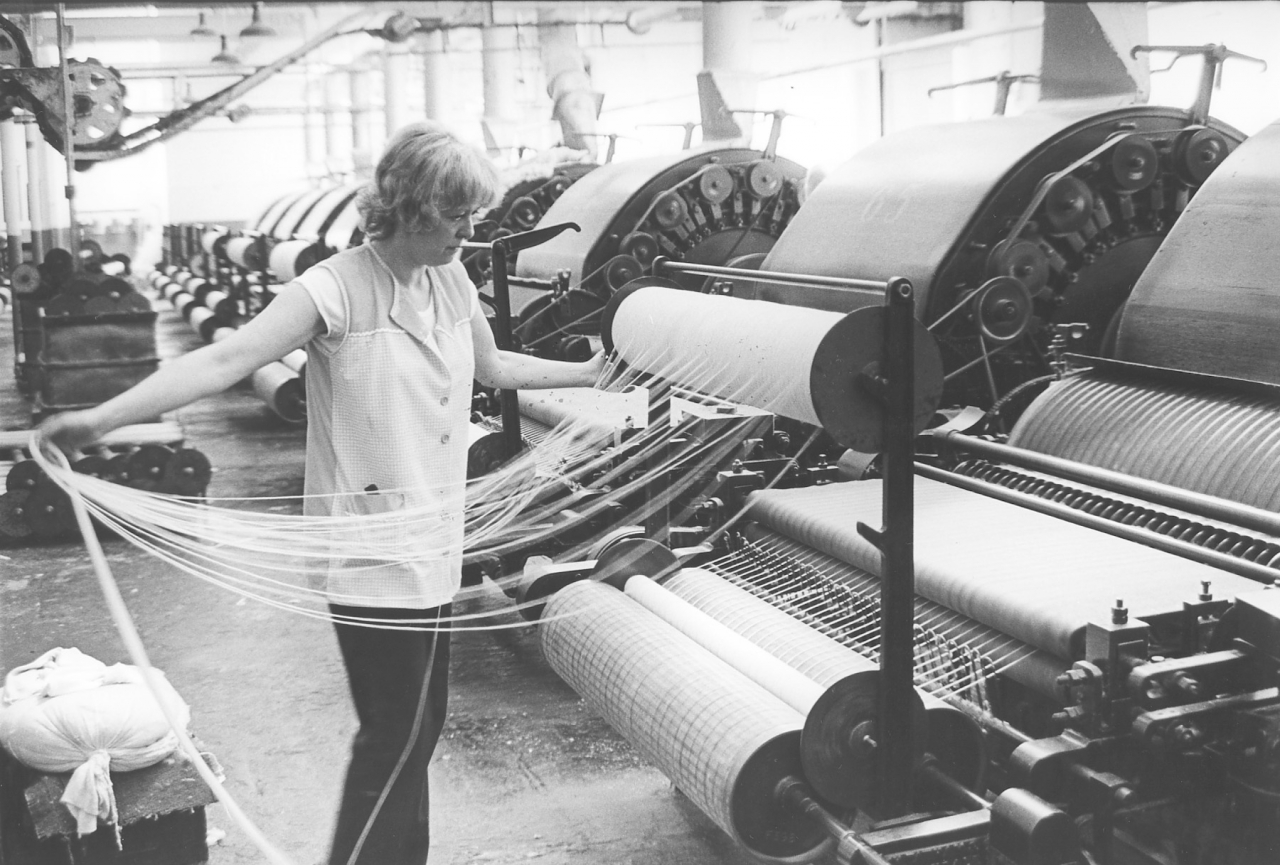
R- Glenys readying her bobbin up.
Aye. Now if that were a taper doing that with beam we’d say he was balling it off.
R- Yes. I've heard you say about balling it off.
Yes, balling it off you know, and the taper would be making a ball in their hands.
R- We just say they're readying the bobbin. Readying it up.
Aye, readying it. Now, what exactly is she doing there? You tell me what she is doing there Jim.
R- Well she's probably taken the bobbin out where it broke down, probably her end's broke down in this divider what divides your ends.
Ah, in front of the doffer cylinder.
R - In front of the doffer. So she has took her bobbin out and she’s readying this down. Now then, that bobbin, that end might have ran down for a bit so as all her bobbin's level till she gets level with that where the hole's been.
Yes, that’s it.
R- And then when she gets it level, then she'll find that one end what's broke down and then spread them all out evenly.
She did Jim, she did, because I watched her doing that. She kept, as I call it, balling it off, she kept balling it off until she got to where there was an end down, she only had 29 ends in her hand there.
R - That's right, yes.
And that was the reason why she had taken it off there. In fact she gave over doing that to see to the bobbin that was in the machine because it wasn’t just running right but she got it running to her satisfaction and then she balled a hell of a lot off that to get the end. She got to it once, but she evidently wasn't satisfied with it, and went on a bit further until she'd got it.
R- Until she got it all level and then found her end.
That's it, then she just got them, bunched them all together, broke them off, …
R – Broke them off and then put them into the bobbin rack.
Just tucked them into the bobbin and up on to the conveyor with it, aye. Up on to the bobbin rack with it.
R - Bobbin rack yes.
Aye. In fact I think that if you turn over, on the next page it shows her trotting off with a bobbin, it wasn't that one. Ah, she is passing up here with the bobbin. [0035]

R- That’s it on, over her shoulder, yes. And them were the bobbins these were the trucks used for piking her bobbins off.
(300)
Aye, that’s it aye.
R- She puts her bobbins on there and pikes them off into this truck.
R - And then there are the grinders, they are coming and emptying them for her.
Aye. Yes well, she's come down with it, and on 0036 she has lifted the empty bobbin down off the rack.
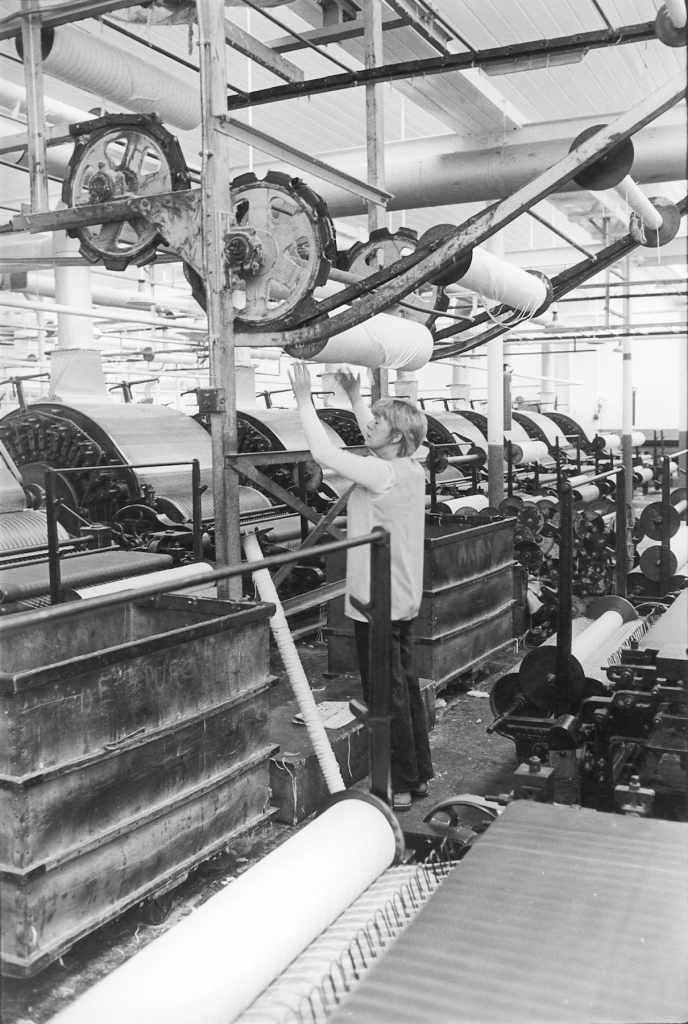
R - Off the rack to put a full one on.
... and she is just popping the full one on, and it’s just a fair reach for a lass up on to that isn't it?
R- It is, it is a fair reach, isn't it?
Aye, I know she has got her eyes shut while she is doing it, I don't know why.
R- Yes perhaps frightened it'll hit her on the head because they do fall down sometimes. Yes, because them little recesses here what your bobbin goes in, over the years they come loose you see, and they turn ..
That's it, aye.
R- You see? And if you haven’t put your bobbin in right it'll just fall out, drop on you. Yes.
And even though they don't weigh so much you don't want one of them dropping on you.
R- Well, if you get them flanges at your end…
Aye the flanges, they’re sharp.
R- If one of them hits you on top of your head, then it can cut you up, cut your head up.
Aye. And number [Svspinning] 40 is a picture of a fellow that we seem to know quite well. The one and only ...
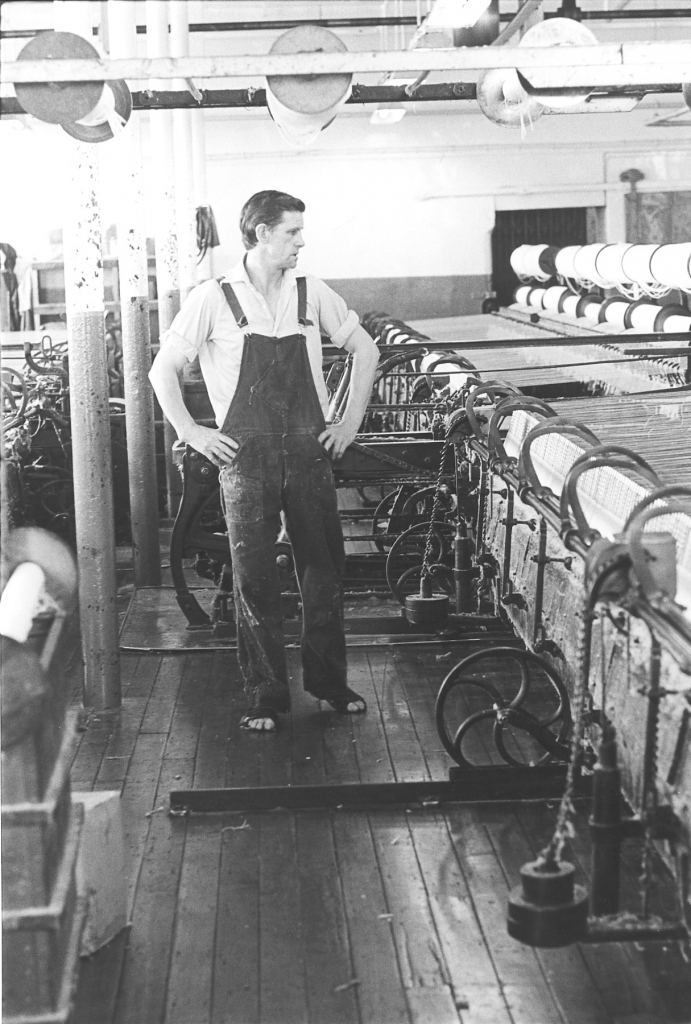
R - Yes. His face is familiar.
Yes. Right, come on, picture 40, who is he?
R – It’s Mr Riley.
Mr Riley. Oh bloody hell!
R – Esquire.
Ah, we are getting the Sunday hat on. Now then, you were stood there in, now you tell me where you were stood.
R - Well I’m stood against the headstock, I'm just watching my mules run, waiting for ends coming down, either on the mule or in the bobbins.
Yes. Now what do you call the area in the middle there? Up the middle there?
R - Well, it's just, it's just the mule room.
Yes but it’s wheelgate
R- It's the wheelgate that's right.
The wheelgate. Aye, that’s it. Christ almighty Jim, I’m going to have to start teaching you about mules I can see that.
R – Yes, it is a wheelgate.
That’s it. And over your head?
R - Over my head is the bobbin rack what's coming out of the card room continually going round with the bobbins on.
Yes. So that when you want a bobbin, instead of having to walk half a mile you just...
R- I just reach up and take one down, And this here empty one, and I am waiting for a space for to put it on. Which I can soon do if I just take one off, a full one, and put the empty one on.
Yes. Now what have you got on your feet Jim?
R- Just a pair of sandals, open toed sandals, for comfort.
Aye. Now, that floor, even now, that floor's highly polished isn’t it, a good floor.
R- It’s a good floor is that, you can work in your bare feet on that one, it’s a very good floor. Yes. No spells [splinters] anywhere in that.
No, I was just wondering what sort of wood it was that’s all.
R - I thought about it, it's maple.
Do you know I think it is. I think you're right.
R- When you'd asked me the other night, I started thinking about it again.
Aye. I think it is maple.
R - And I looked at the floor and I thought I'm pretty sure it is maple. Very hard wearing stuff.
Aye. And that’s what they used to make ballroom floors out of.
R- That’s the sort of wood and them in schools.
Yes. Them block, them parquet floors, that’s maple.
R- There, that there is maple.
Aye. It’s very dense grained and it doesn’t go into spells does it?
R- No. It just breaks off and…
When you come to think, it’d cost sommat to put one of them floors down now. It makes you wonder how much them floor’s would cost nowadays.
R- Yes, God yes.
And, another thing about it, those floors wouldn't have lasted as long as they have if people had been going round on them with nailed boots and God knows what.
R - Oh no.
I mean, with bare feet say and them floors would just about last for ever wouldn’t they?
R- Well, I think that's mainly why they've put them sort of floors in, for people to walk about in their bare feet. 'Cause I don't think they'd have used expensive wood like that if they were going to be up and down them with the old nail boots and clogs and what have you.
No. They wouldn’t would they.
R - And to me I think that's the reason why they put that sort of floor in there.
And another thing about it when you think, it’s easy to keep clean.
R- For to keep clean and hard wearing. I mean they weren’t daft in them days you know?
Anything but! I notice on that picture there, and it varies, now you have got full bobbins on top of the mule ready for use, almost every one. Now sometimes I have come and taken pictures of you and there's been very few full bobbins there in that creel because perhaps the card room wasn't just working flat out, and there was a shortage of bobbins, or…
(400)
R- There’s a lot of reasons and there's also a lot of reason for what we call bits, half bobbins and little bits of bobbins what's only just a bit run on to them. Most of the time this rack is full of them. Now this pair is the last pair at the end of this bobbin rack. It starts first at the bottom, it comes right up into the top room and the three top pairs get all the best bobbins.
Aye.
R- They don't take any bits off, and it comes down the wall into our room. And it comes to the other pair over the other side and we are the last. And after it's left us it goes back down into the card room. So we get all what they call the shit.
Yes, I know shit, I know that word.
R- But, once of a day up to just, I should say, I think about three or four years ago they could turn that round.
Reverse it?
R - Reverse it. So as when it came out of the card room this pair got all the first bobbins. And go right through upstairs, back and down to the card room. But it's something about the bearings, sommat wrong with the bearings and it will only run one way. That’s what I've been told, 1 don’t know whether it's true or not, but they said they can’t reverse it and some say they can. Now they used to reverse it and they used to reverse it every three months, you see. So as that pair what I am on now had a pick of the best bobbins just for them three months and then they turned it round which it's going this way now you see? And that's the reason I don’t get a lot of bobbins on, I will fill my creel up if there’s some big bobbins come through, I fill them up.
That’s it, if there's good bobbins coming through you'll take them up.
R- If there's good bobbins I'll take them up but I’m certainly not taking all the bits off and running them all.
Now, what happens if, what happens to them bits there, I mean do they keep going round and round and round?
R- Well, they keep going round and round, until eventually Arnold, the overlooker will come, and he’ll look at them bits and say “Lot of bits on there” I’ll say “Yes, but I’m not running any more. I’ve run me share.” So he'll take all the bits off what comes round and he’ll stand them all at the back of my mule and then he’ll share them all out. He'll get a truck, and he'll give everybody four a piece, every mule and he'll get rid of them. All the rack's empty then apart from the bobbins what want piking off. But you can guarantee the day after the bloody bits will be back again. Now then that is bad card tenting out of the card room and not looking after the work right you see. And they’re just readying the bobbins up and sending bits up and that's how they keep coming round and round, there's just a lot of bad work in the card roomy plus all the other spinners'll not take any off, they won't run them you see because it means a lot of creeling, because they don’t last so long do them little bobbins, they’ll only run about an hour and then you are changing what can. But normally a big bobbin what you put in will run four five hours you see. You are doing double work.
Will it last so long a full bobbin?
R- They run about five hours will a big bobbin, out of the card room.
That’s a big difference, a lot of difference isn’t it.
R- Certainly, if you were taking all then bits off, and they were only running an hour you’re doing three times the work.
(20 min)
Aye. And I must put something in here in your defence. I mean, for people who are listening to this in years to come, there will be people who will listen to you saying that and they’ll think well, he is being a bit fiddly. It doesn’t make that much difference, ‘cause it doesn’t take long to creel a bobbin up but I know what you mean. There's two things about it, you tell me whether I am right or whether I am wrong here. The first thing is that these things do make a difference, and if you are trying to do a good job you like to think that other people are trying as well, and that you are getting a fair crack of the whip. And really that is the second reason, I know as well as you do, and I want you to give me your opinion on this, there is nothing worse than thinking that you are being made a bloody mug of. It used to upset me, things like that. It's all right, you could be a good man for the gaffers and everybody else, and you could take them bobbins just as they come, and finish up taking odd bits and working half as hard again as any other mule spinner in the place. But the thing is that nobody'd think any better of you. In fact they'd say “Bloody hell, look, Jim’s arseholing again.” You know, they start, that’s how it works isn't it?
R- It certainly is.
And they’d be right and all. I mean, why should one person have all the muck and the dirty end of the stick all the time.
R- All the muck yes. Well that pair does get all the dirt and all the muck. All the bloody leavings, all the lot that nobody will do and nobody wants, this pair has to have it. And you see, the trouble is when we get down with the bobbins, when they get short of bobbins in the card room and there is none coming through only bits, then we have to run them for to keep our mules going, otherwise we’ll stop. Well, we go for the overlooker and we say “Arnold, we are stopped for bobbins.” “Plenty of bobbins on the rack!” “yes, but they are all bits.” “Well, you'll have to run them off!” I say “Well we have been running bloody bits all week!” And things like that you know? Well, you’ll have them to run, you can’t stop and things like that. So it annoys me like and I start falling out with him you know and that's when he comes along then and takes them all off and spreads them all out, gives them to everybody. . But I've seen, well I’ve heard, people in that mill has told me that when he has taken them bits off them bobbin racks and taken them upstairs, they've put them on the rack again after he has walked out of the room. It's been done has that. So I don’t know whether that's true or not, but that's what I've been told.
Well, it's one way of, like, keeping the lads quiet isn’t it.
R – Yes certainly. But apart from that, another reason why I don't like all these bits going in and all is every time you put a bobbin in, you piece a bobbin up and when you piece it up you’re getting a double end, you see? If you put a bit in you piece it up, you get a double end in and it goes into your cop and it goes to the weavers. Now it might show up in the cloth, it might do, it might not, but if you run that bit off you might put another bit in before you've run a full set, then you've two joints.
Yes in one cop.
R- In one cop you’ll have two joints.
Yes, in every one.
R- From two bobbins, off two bits. Whereas if you put a full bobbin in then you get them even all the way through on that set of cops and another set after that and another after that. But if you are putting bits in all the time you’re going to get double ends coming through happen twice in one set of cops.
(550)
Yes. Which means that in effect no matter how well you are working you are actually turning out bad weft.
R- I'm turning bad weft out through them bits. Which it's unavoidable, you can’t get away from it.
Yes that's it, aye.
R- You are just piecing up you see and putting two bits in. But whether they've thought about that I don’t know but to me that’s what I'll think about, it’s there you know.
Right, anyway, bib and brace overalls, you have got them on I see.
R – Yes.
Yes I like bib and brace.
R- Yes I've never had boiler suits because you’re too warm in boiler suits. Up to the neck I don’t like them.
Yes. I can't imagine a mule spinner being able to wear a boiler suit anyway.
R- No, I've never seen a spinner have a boiler suit. No, he’d be too warm.
No. Another thing about bib and braces, they're tidy, there’s no loose ends flapping about. Now then, tell me the advantage of that. And another thing there, you've got your sleeves rolled well up.
R - Oh yes, that’s for safety’s sake isn’t it?
Tell me about it Jim.
(25 min)
R- For when you are reaching over into the mules when everything’s running, and two bands are running and you don’t want any loose bits on your shirt or pockets or anything like that. You haven't to have anything loose because it'll catch and you could get hurt. That’s the main reason for the bib and brace.
Have you ever seen anybody get caught up?
R- I’ve seen one lad get caught at the wheel end with the sleeve. Just caught in the wheel end, I can't show it on here, there isn’t a picture of it. But it's the wheels at the wheel ends and they are running together in the teeth.
On the end of the mule?
R - On the end of the mule that drives your rollers round. Your steel rollers. And I’ve seen a lad get his sleeve catched in there, and it just ripped his sleeve right off, ripped it you know? And that’s why when we were learning spinning we always got told to roll your sleeves up and roll them up tidy and straight. But you get learned that when you go in the army that.
Yes you do.
R- For to roll your sleeves up, and tidy. But the old spinners used to tell us that, always roll them up straight. And I know some lads, and you wouldn’t believe it but it’s true, they didn’t know how to roll the sleeves up. But the old spinners used to show them and they used to roll them up right straight. Get it started straight, and roll them like that, and carry on right round.
Yes, get them square.
(600)
R- Get them square. And once you have rolled them up then you are right for the day, they’ll not come down and they’ll not get fast.
No. Yes, that’s it aye.
R - Bits of things like that, it’s for safety.
Yes. Another thing. And another thing I don't know whether it's anything to do with the job or not, but there is nowt like asking. You wear your hair short and all which in uncommon nowadays.
R - Yes well, that’s for comfort as well, for sweating you know. You get them, you get people with long hair and you are inside the mill and it's dusty and you start sweating, and their hair smells and you get all little rolls of, ball’s of cotton, sticks up in their hair and things like that. You don’t see a lot of spinners with right long hair, they always have it cut short.
No. And if your hair is short it’s quick to wash isn’t it. You can just stick your head under the tap and have a bloody good wash when you come home.
R- That's right because your hair gets right dirty, it's very dusty with cotton. You'd be surprised how much muck comes out when you wash, yes.
Now, tell me sommat, are you ever affected by the oil. We were talking about spinner's cancer and what not before. Now obviously you are changing your overalls and your underpants and you are not going to get cancer, and anyway they have changed the oil. But do you notice the oil flying off the spindles?
R- Oh yes, you can see it. You can, when you go in in the morning and you start oiling up you oil your spindles up, you put your oil tin down and you set on. That turns your spindles then it flies does your oil. Now then, they tell you, some of the old spinners used to say when you set your mules on, walk into the middle you see? Don't follow your mule out because when it's turning it's splashing. It’s only that first draw. Never walk with your mule out when you set it on, walk back to your headstock. And let your mule come out so as it spits all that oil down on to the floor. Because if you walk out with your mule you can guarantee it'll all get on your overalls which it will because you are out against your cops, your spindles which is spitting oil. But I'm not bothered with the oil a right lot. I do get some spots on, near my knees you know with bending down, my knees touch the boards, the spindle boards, which is full of oil. But it's only a bit, it's not much and when I have a bath it, it all comes out you know.
Yes that’s it.
R- But normally my overalls are pretty clean you know, it's only, they’re just a bit dusty like you know?
(650)
Very good. Right.
R - We've said a lot on that picture haven't we?
Oh it’s amazing how much you can say about one picture, you’d be amazed Jim. Picture 41.
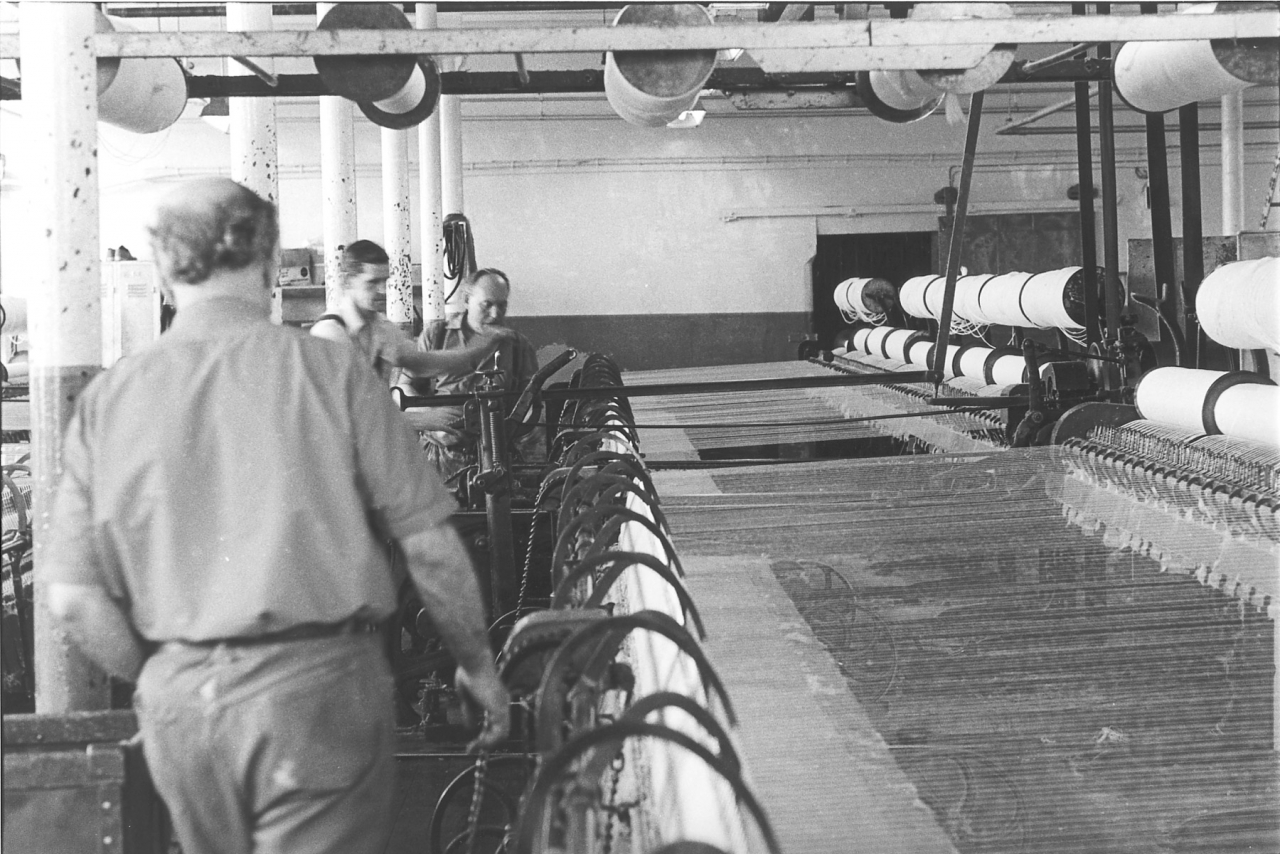
R – 41. This is where we’re getting set up for a doff aren’t we.
Now then, that’s it, you’ve hit it straight away. This is the beginning of a series of pictures, which as I said to you when we first laid these pictures out, I wasn’t quite sure where to start, because it's a continuous process. But you're just getting ready to doff.
R - What we call setting a mule up for doffing.
Yes. Now then, let’s start from the beginning now. We keep talking about doffing, now you tell me exactly what doffing is for a start off.
R – Well, doffing is taking your full pirns, your full cops off your mule, taking your full cops off your mules, and replacing them with empties.
(30 min)(700)
Yes that's it.
R- That’s what spinning is. It's just filling pirns up for the weavers and you are taking them off and putting empty ones on.
Yes. Now then, if you were to just, if that mule were just running normally and you were to just stop it, you couldn't take those pirns off as they are because the thread is going on to the cop.
R- It’s going on to the top.
It’s going on to the top of the cop where it's been winding on hasn’t it. So now, you've got to set that mule up for doffing. Now you tell me about that Jim.
R- Well, you stop your mule on your back, on the back, let it back off and go in about a quarter. But first of all, before you do that, you wind what you call a builder, you wind that back which in effect takes your end down to the bottom of your spindle. When your cop’s full your end is at the top of the spindle and you’ve to get that to the bottom of your cop. So, the only way you are going to get it there is by winding that little builder back, which is underneath where Tommy's stood there now. You wind it back, then when you run your mule in and stop it he hooks these fallers down and then it, which it does when you wind that builder back, it takes your counterfaller down. Now in effect it’s your counterfaller that controls where the end is running on to your cop, that's what builds your cop up is your counterfaller. This other faller here is the winding faller. It's a big faller what comes up. But the other faller there, your counterfaller, that’s what shapes your cop, that what makes it, that's where your end runs. Now when you wind that builder back you take that end down to the bottom of your spindle so as when we run that mule in we’ll run a bit on to the bottom of the spindle, then when you take that cop off, it breaks your end [but leaves it trapped on the bottom of the spindle.]
Yes. Now when you start to run it back in it starts trying to wind up, the spindle turns to wind up what would be the slack on the yarn. Normally, it's been spun as it comes out and then as it goes back in again it’s winding it up in place on the pirn.
R - On the empty pirns
On the empty pirn, on the top of the package isn’t it. But with you having held that counterfaller down, what it's doing, it’s winding that end on to the bottom of the spindle underneath the pirn isn’t it?
R - It winds it on the spindle underneath the pirn.
Yes so you are getting a build up there. One thing that I just wanted to ask you about that while we are talking about it, I think that it’s clear up to now. But, do you ever have to clear the bottoms of your spindles off because it’s building up?
R – It’s what we call taking your bits off because they build up over a week.
That’s it. Now…
R- So we're winding a little bit on the bottom every time we doff.
Each time, yes.
R - Then it builds up and builds up. Really, we should take them off once a week, but we don't do, we make them last a week and two days. But when you are on a thicker count, same as that next pair, they are on fours, then you have to take them off twice a week because it's such a thick yarn. Now then, when you have to take them pirns, them cops off, then you run it in and you shove all your bits up and you do the same process as what you do when you're doffing, then you run a bit more on the bottom of your spindle and take them lumps off. And then you have a clean start.
That's it aye. Now, well, thanks very much for telling me that. Now then, so what's actually going on in that picture, what are you doing.
R- Well what we are doing here is all the mule's come out and the builder's already been wound back for to get that the yarn under the spindles so I’ll run it in there. Now then, Tommy'll come along here and hook these fallers down, he'll hook it down you see, then we'll go through the process of winding stuff on the bottom of the spindle.
Yes, well I think if we turn over to the next picture, I think we'll come on to that. I think we'll find that you are doing that there on picture 44.
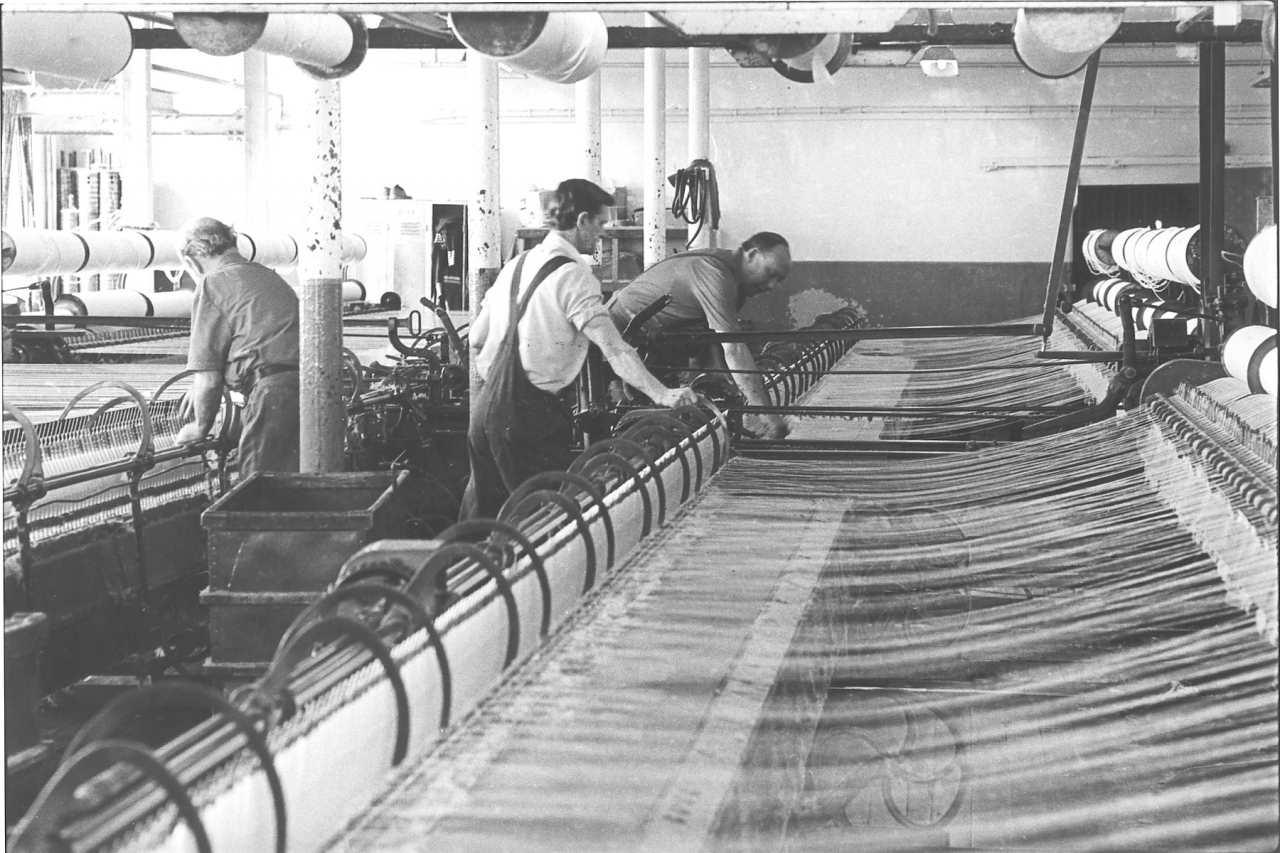
R- That's it, now that's where Tommy is hooking his fallers down.
Tommy's reaching over and hooking the fallers down.
R- He is reaching over and he hooks the faller down. Well I help, I push down with him, because there’s a lot of weight on them, a lot of weight what's on.
Yes, that's it.
R - So I pushes down and he puts a hook on you see. And then he pulls what you call a boot leg out. This is what runs on a rail, it's only for weighting this and I’ll explain this later on in another picture. But this is where we are setting the mule up for doffing. So he hooks them down, and then he pulls the boot leg out and then I'll run the mule in, ends slack, which is on another picture.
Yes. Now on picture 45 you were winding away at that handle.

R- I'm winding this down, this is a chain what runs on a drum. This is winding the chain in, this is what winds when your mule's running at the bottom of the set. And I'll wind it down so as I can get these ends to go slack otherwise if I don’t, if I don't slacken this chain off it'll be tight and this mule won’t move. That's [what I’m doing], I'm winding down to get the slackness on these ends.
Yes, right.
R- You see, and then when I run it in, which might be on another picture…
Aye well, picture 46, we'll turn over.
R - It might be because you've got to follow it in sequence you see?
Yes, that's it, 46. Ah you are still…
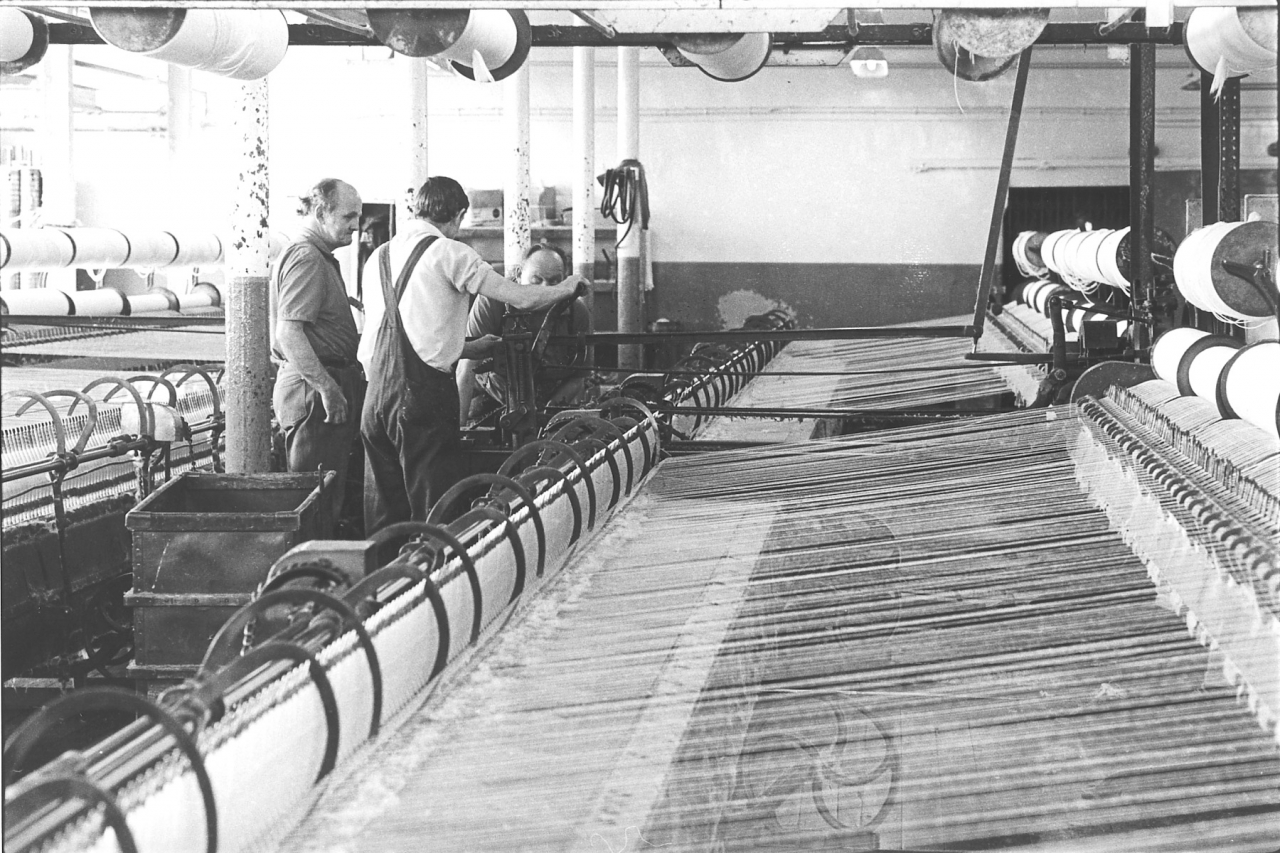
R- I’m still doing it here, you see we're talking away.
You are still doing it, you are still winding it down and you are talking away…
R- I’ve wound it down there, and Tommy is going to bend down here now which is in picture 45, to wind the builder up, so as it takes your counterfaller right to the bottom for to wind on them. Now then I’m going to set this mule on now for to run it in a bit so as it winds a little bit on to the spindle at the bottom, underneath the cop ...
Yes, putting that on at the bottom. Yes that's it, aye. Let's go on to picture 48.
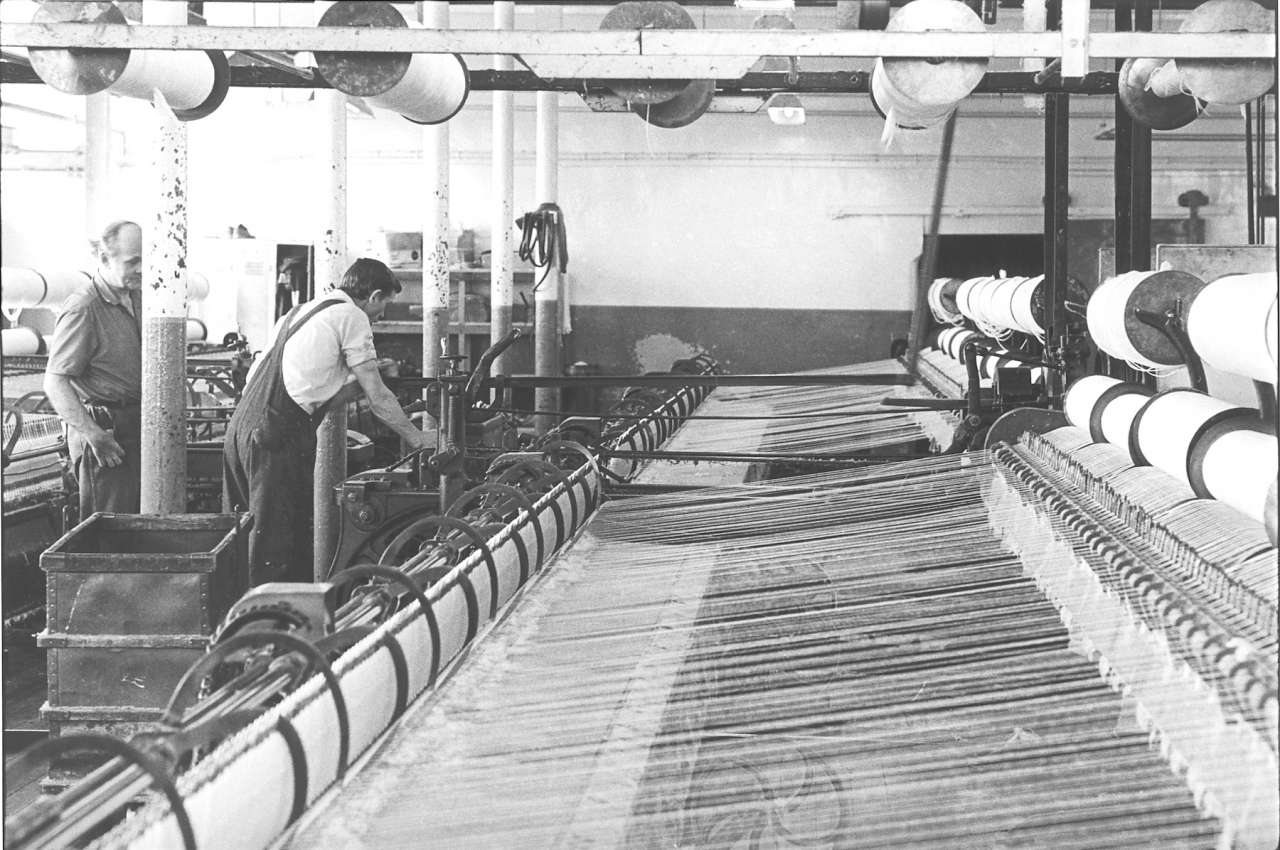
R- I'm still running it, I'm still waiting for him winding his builder back.
Yes that's it.
R- Now then, this is where I have wound on picture 49.
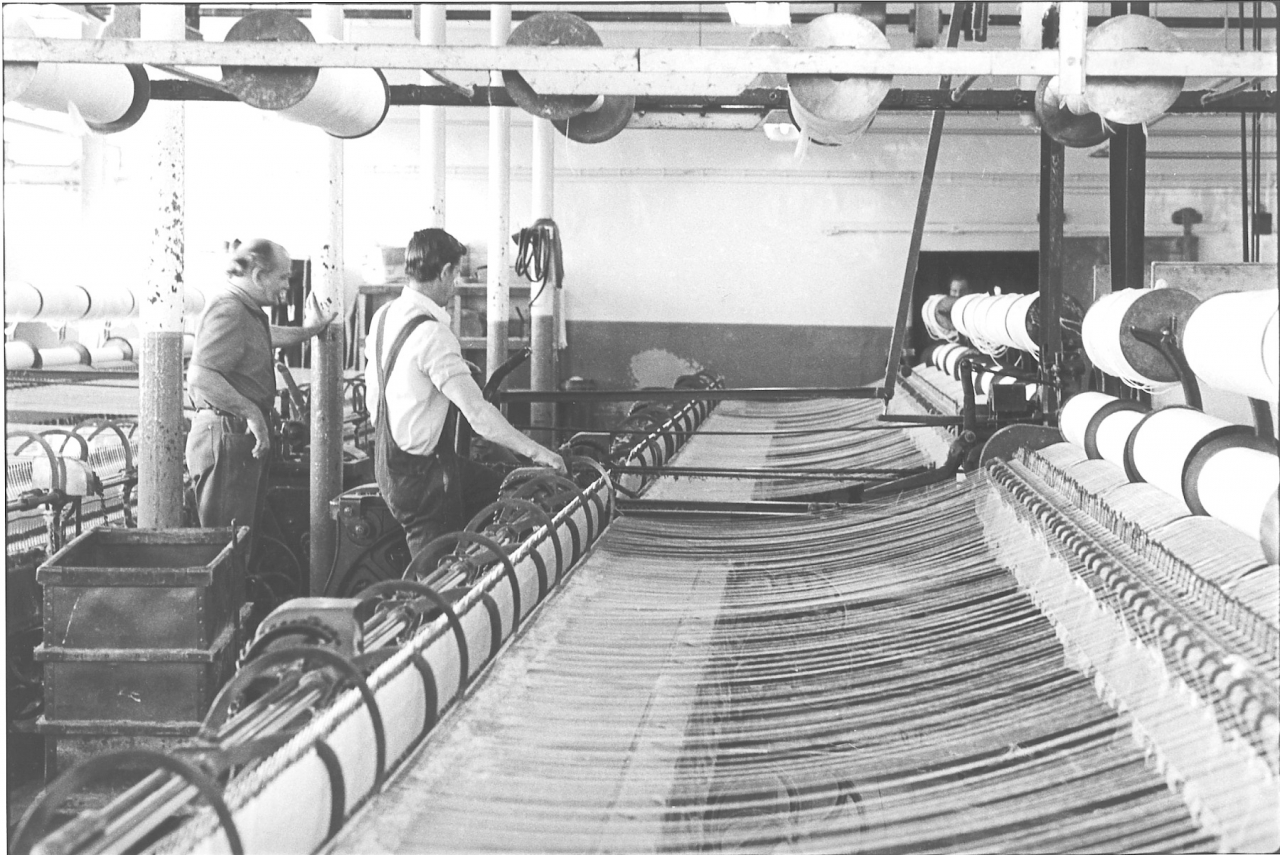
49, You can see that it's coming.
R- You can see where I've got my ends slack you see? Now then he's wound the builder back has Tommy. Now then I've brought the ends just a little bit too slack, so I've tightened my chain up, and I'm going to stand on it, which in effect, pulls the mule back, and it tightens them ends up.
Aye that’s it.
R - Which might appear on 50.
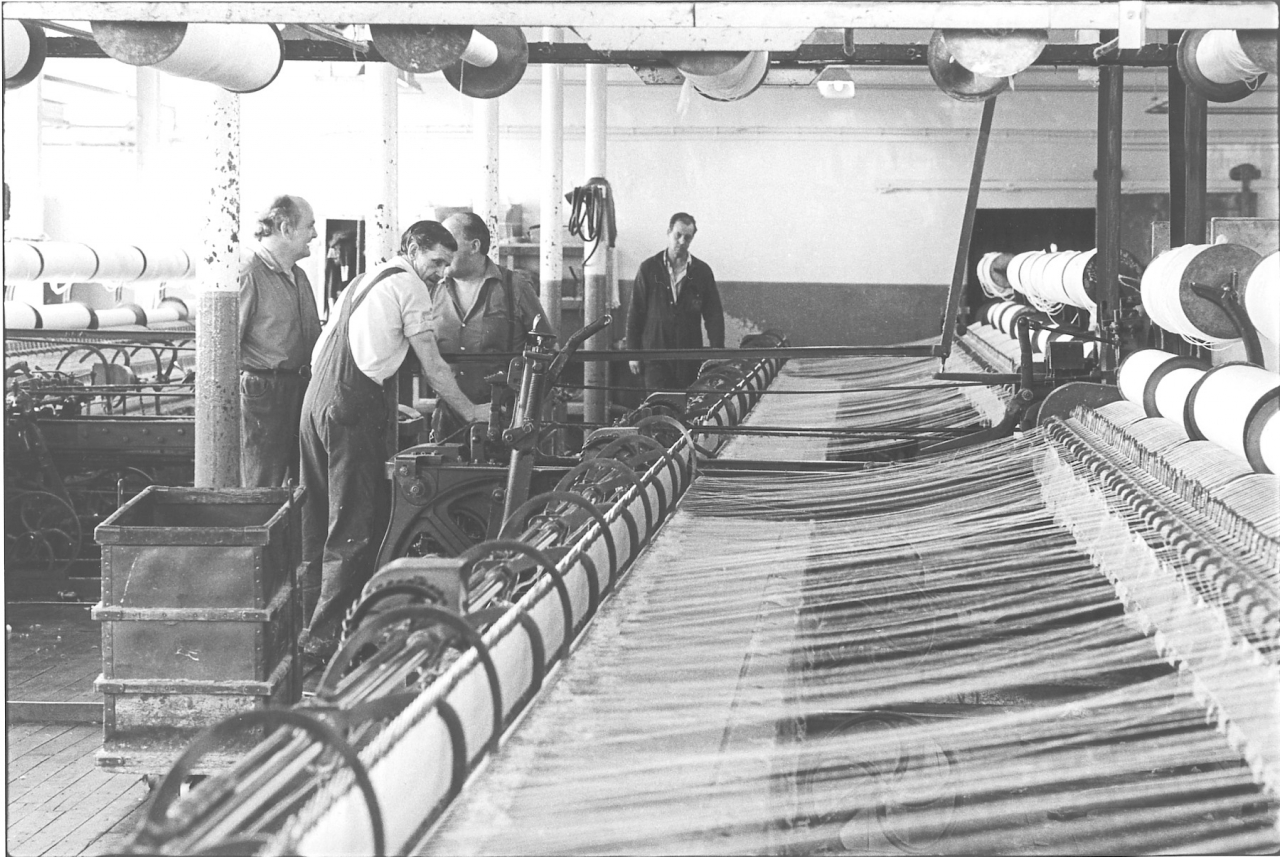
Aye 50. They are, they are tightening up.
R - They are tightening up, but you can run it up with your ends slack just like that. Some has them a lot slacker than others. It just depends, you see.
I see Arnold's coming to the wheelgate.
R- But Arnold’s coming, yes he’s probably coming helping us to put some pirns on.
Aye, that’s it. No, he's come for something else is Arnold. Now then, on 51.
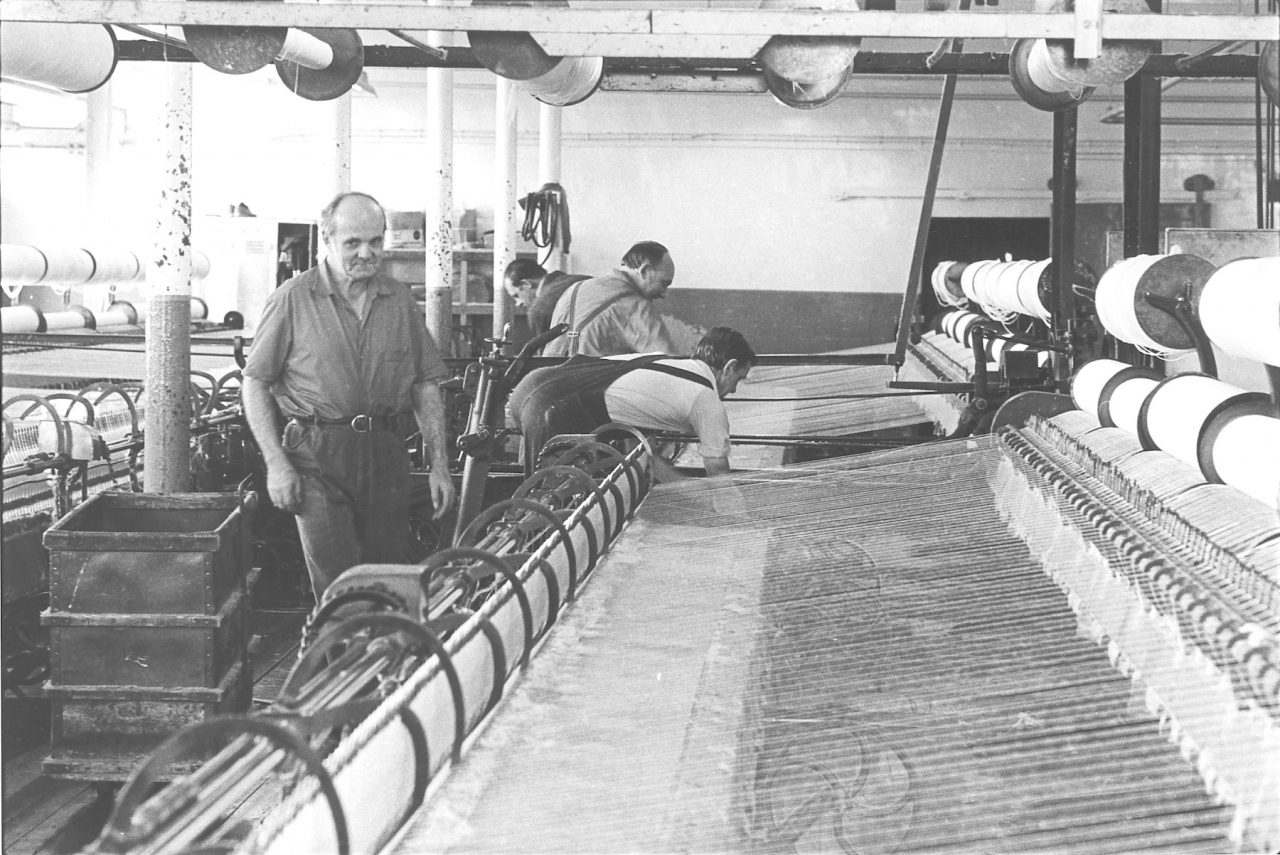
R- On 51 I've, we have already run that in now and got the bit on the bottom. So I’m loosening that chain off there, ready for when we take the cops off, for to run it in. That makes the winding fallers come up when we run it in. I've got to have some slack on there or else that winding faller won't come up.
Yes that’s it.
R - In effect it, there's another…
The winding faller is the faller that goes quietly up and down and…
R- The winding faller goes up and down and is what shapes your cop.
Shapes the cop. Yes.
R - That's winding on to your cop is your counterfaller. But your winding faller, that's your winding faller, the big one that comes up and what controls your ends.
(800)
Now the counterfaller in the one that controls whether it's spinning or winding, isn't it? Is that right?
R – Yes, that's right. And you also have a chain, this chain works when it's running and winds itself you see?
Yes. Now then what's this fellow's name here, who is walking…
R - Donald Braithwaite.
Donald Braithwaite. That’s it.
R- He is the tuber.
Yes. And he is in the wheelgate to give you a hand with the doffing.
R - To give us a hand with the doffing. Well, he waits while we take these pirns off, these cops off, and he puts the empty pirns on.
Yes well we have a picture of him doing that aye. Now then, on 52.
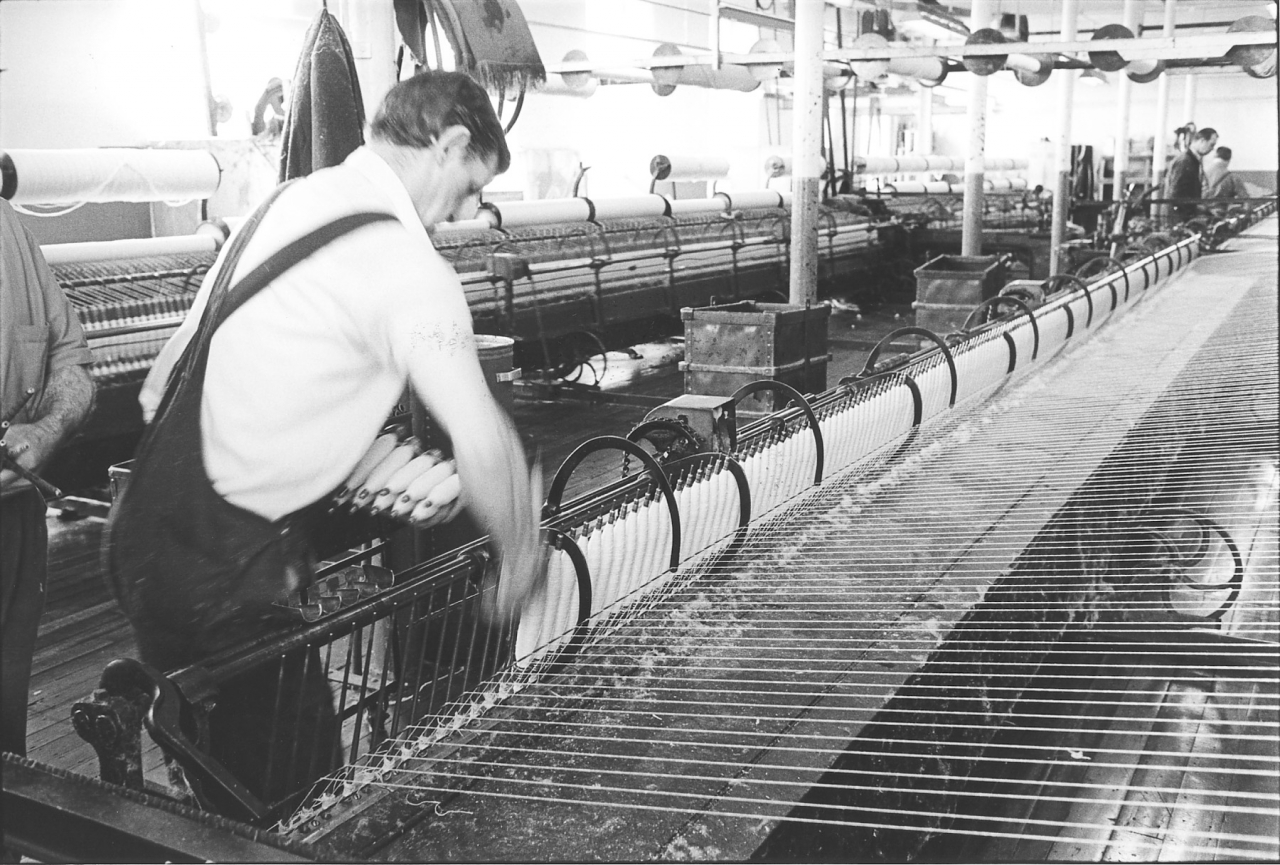
R - On 52 I'm taking these cops off.
Yes. Now every time I watch you doing that I'm always frightened for you. I’m always thinking ‘Christ almighty he is going to get a spindle up through his arm.’ because of the speed you move at.
R- And yet some can take them off faster than me. But it’s a silly thing to do, really with these because in the bottom of them pirns they have what they call rubbers, the rubber bungs they call them.
Yes. I've noticed them.
R - Now then them, they're hard, when you press them down on your spindles and there’s been quite a lot of people being ruptured taking the pirns off.
Ah, with them, one being stuck on the bung, yes.
R – Stuck. They just pull like that, and they stretch and they’ve been ruptured. There's one bloke working in the top room, Frank Pilling, he's had two, one at either side.
Aye.
R - And that’s why I don't rush, I take my time.
Why at either side? He must have been doffing left handed and all.
R - Probably, I don't know, but he's had two and I know none of them lads what work there has had any, but some of the old spinners, they’ve had ruptures, and it's all caused through pulling them off.
Yes. You can see there how it's right down at the bottom. You can see how the counterfaller is shooting right down to the bottom.
R- Right down. The counterfaller is right down on to the bottom, on to the spindle rail as it’s called.
Yes you can see how it's right round the bottom yes.
R- All that yarn is going down the bottom.
(40 min)
Yes and it’s running over the winding faller isn’t it.
R- That’s right.
Aye, that's it. Oh we have this big one at the top with the…
R – Yes, that’s the big one with the big sickle.
That's it.
R - The counterfaller's the little sickle, yes.
Yes. Now you've set off there, and you are piling them up on your arm.
R- I'm taking them and putting them on my arm.
Aye and on 53 Donald stepped in as soon as there is a gap and he is following you on isn't he?
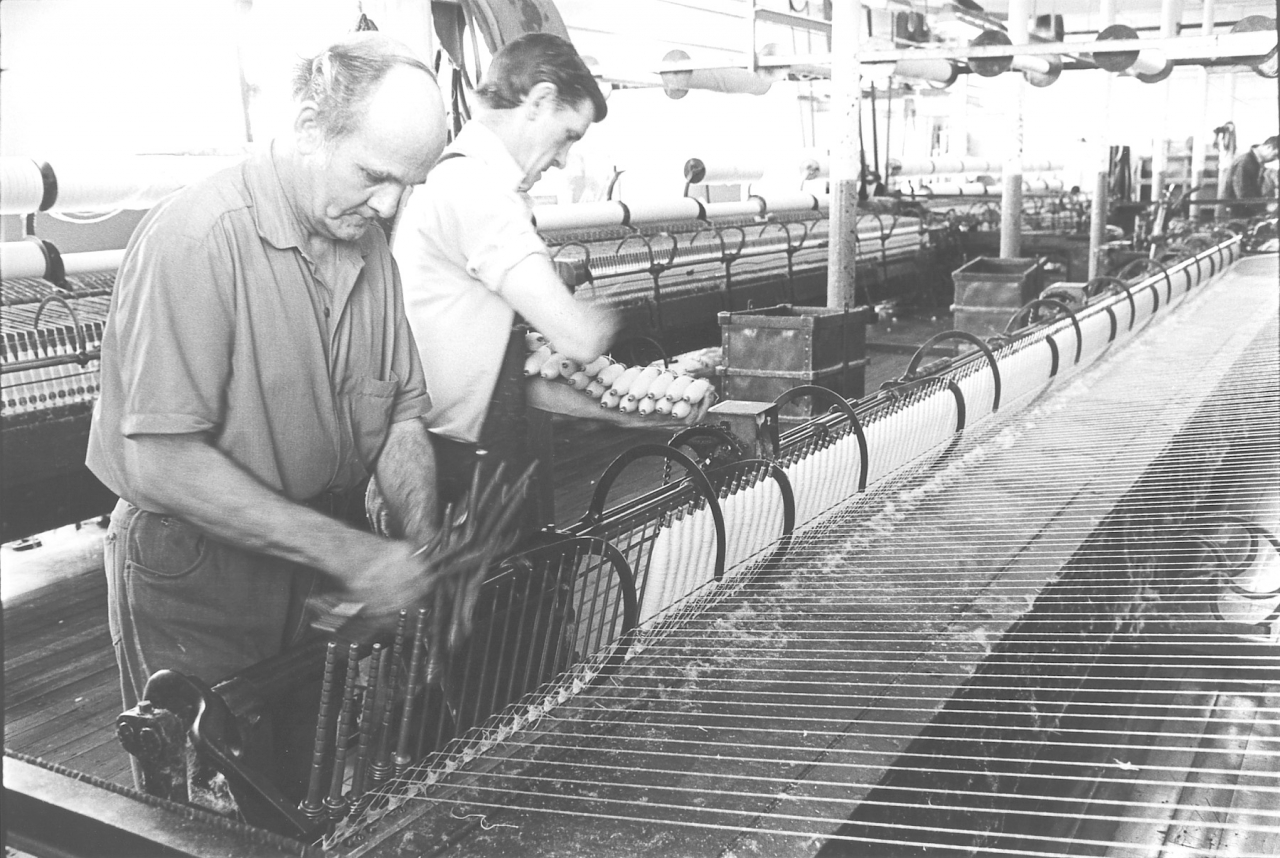
R - And he is following me on, putting them empty pirns in.
Yes but he doesn't push them down, he just pops them on doesn't he?
R- He puts them on and I press them down.
Yes, he just pops them on. Well, there is a picture of you doing that, aye. And you go on until you have got a right armful and on 54 you’ve gone on and…
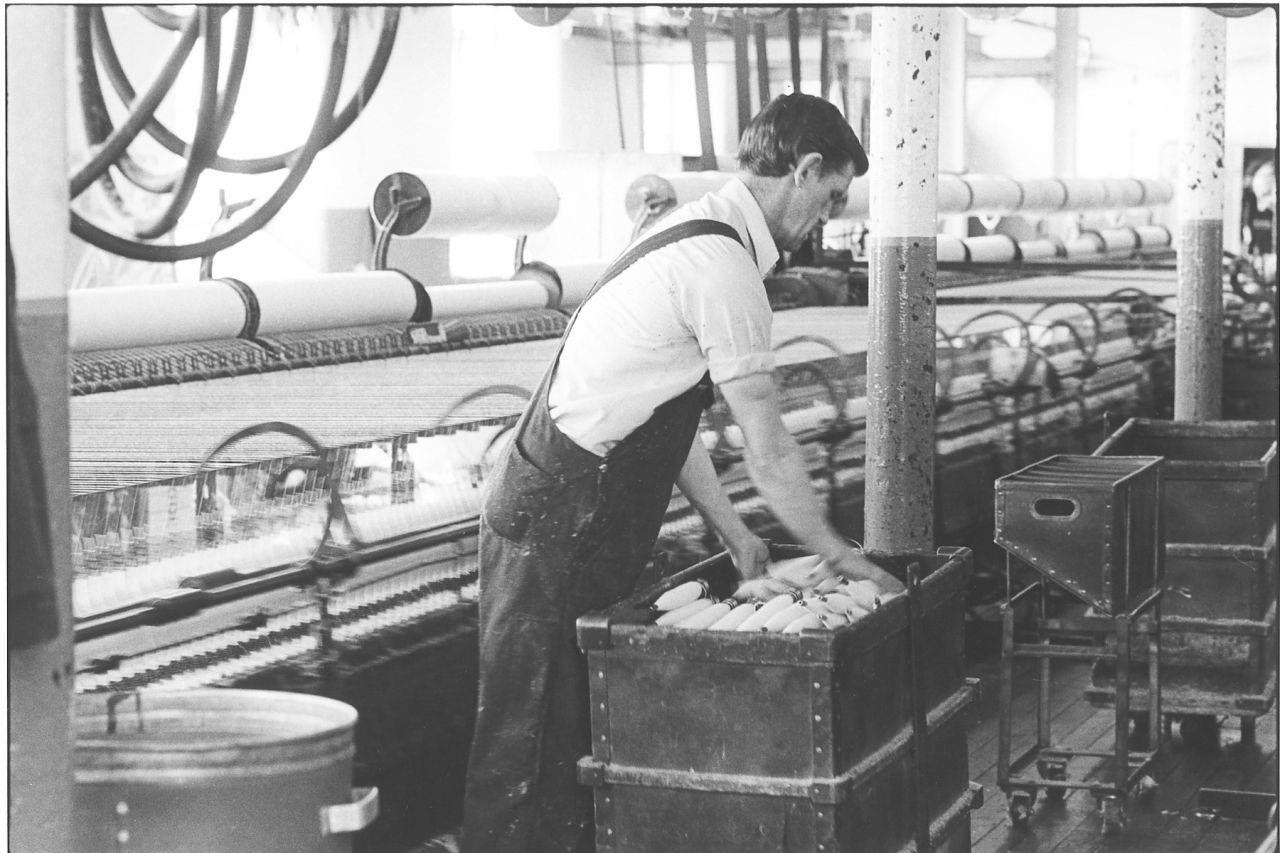
R- I've gone on and on 54 I'm putting them in the box.
You've got, you are popping them into the box. But how many will you get in an armful ?
R - I can get three bobbins off in an armful.
Yes but I mean in an armful, how many will you get into your arm, you'll finish up ..
R- Well, three bobbins, ninety cops.
Ninety? Ah, I see what you mean. My fault, I keep thinking of bobbins as pirns.
R-Yes well, three of them bobbins at 30 ends each, that’s 90.
Yes, 90 cops.
R- I can get 90 in an armful so in effect I only need to get three armfuls for to do that doff.
And while you are doing that Tommy is working away on the other half of the mule.
R - Tommy is doing his half you know, right.
Yes that’s it aye.
R - And I mean, when I have done that I go over and help Tommy to put the pirns on, over that other side, because Donald, the tuber only puts half a side on. You see? And he puts half a side on the other pair over the other side. But as a rule, no, by rights he should put them pirns on there and when he's finished he should come down and help us but he doesn’t do.
Tell me, I think you told me once that Donald is a spinner and all isn’t he?
R- He is a spinner, he is a spare spinner, but he is one of those is Donald, there’s one or two spinners worked with him but in effect he is hopeless as a spinner is Donald. So they took him off and he'll only go on as a spare spinner now. If somebody is off. Because there's been that many worked with him and they've complained about him, they can’t get any weight off with him and he is very slow and he just doesn’t bother about the job you know.
Yes. No, he is a slow sort of a bloke to look at him.
R- Yes and yet he is not old is Donald, he is only about 34.
Is that right.
R- Yes, he is not so old isn’t Donald, only he looks it because he is very serious you see, and he looks about 50 does Donald yes.
Aye, he looks, I'd have said he was 50. Eh, you surprise me.
R- Well he is about 34 is Donald and he lives at the top of Charles Lane.
So you are 14 years older than Donald. God, you'd think it went the other way around wouldn’t you.
R - And he walks up and down like an old carthorse does Donald.
Aye. Anyway, 55.
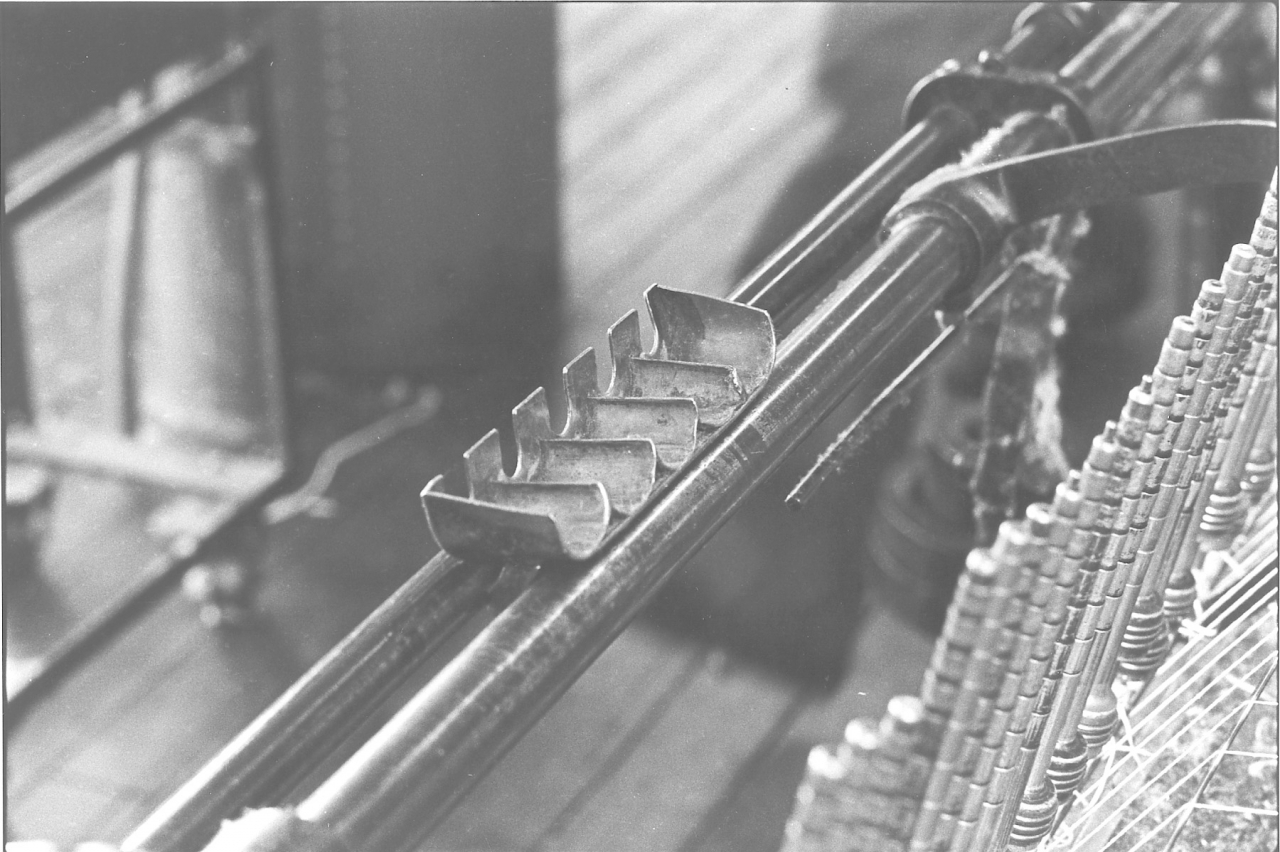
R- 55 is that of your ordinary presser, and the pirns on the mule. Which in effect I go down, pick that up and push them down.
Yes. There is a picture, if you look at 56 there is a picture of you going on your way.
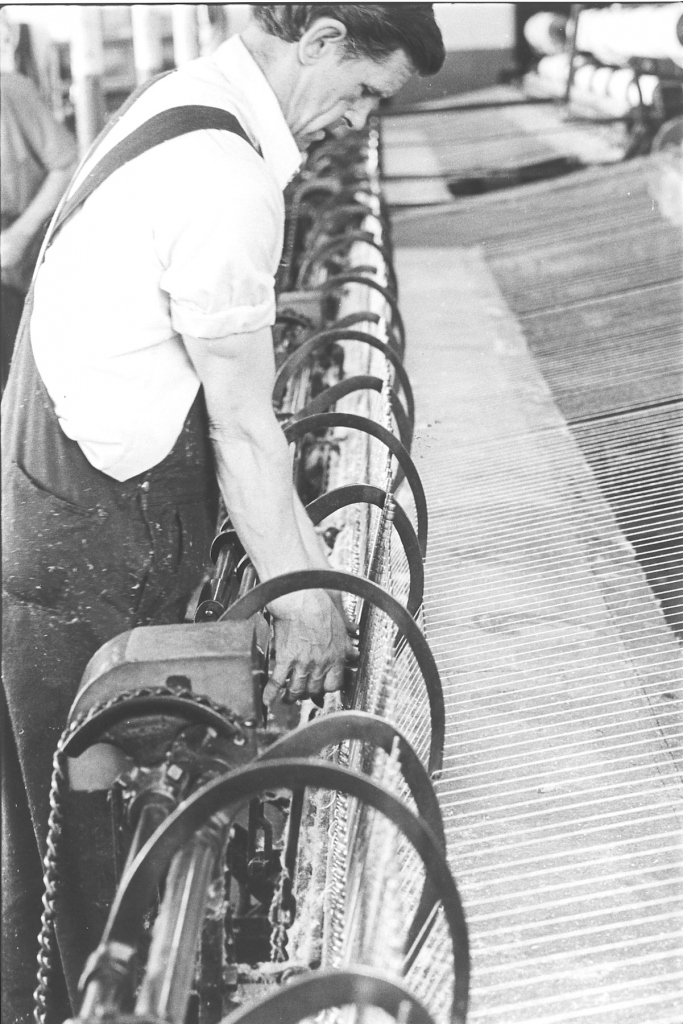
R- I look at 56 ... and there I go, pressing them down. Which is hard work with them rubber bungs 'cause some of them, they've only just put new bungs in them and they are hard rubber and sometimes you've to take them off and spit on them.
I've seen you do it.
R - Spit down it, then it's wet, and it slides down on there.
I’ve seen you do it.
R- But when you come to take them off and you have doffed…
Yes. Stuck on.
R- They are hard, they are hard. Then you have to get a cop off, and you have to knock it from underneath to get it off.
Yes. I've seen you do that and all.
R- Now then, that's the sort of thing that I said earlier on about ruptures.
Aye, that's it, yes.
R- You start rushing and start riving them off then you are in trouble.
Yes, aye.
R- And it’s not worth it, rushing about like that just like you know…
No there isn't no, ‘cause you are ruptured a long while.
R - And you are off for a few weeks.
Yes. You never get them perfect, they never stitch you up right.
R- No, I don't think you are ever right after a rupture.
No, no, you are not, a rupture can be a funny thing. Anyway 55 is going to be the finishing picture for this tape.

R – So, picture 57 ...
And that's just a close-up.
R - That's a close up of the pirns being pressed down, ready for when I want them.
Now then just to make sure that all the local gentry have got it right; when we talk about the faller wires, now that bottom one there…
R – That’s the counterfaller.
That's the counterfaller. Now that is the one which normally governs whether your thread is spinning or winding isn’t it.
R – Yes.
(900)
Now the faller, the next one, that is the one which oscillates up and down and quietly moves up the cop.
R- That's right, yes.
And builds up your package and that also governs the thickness of your package doesn’t it?
R – Yes, but with this faller, the same as you said it governs that all up and down your cop. It goes up and down all the time till it gets a full cop.
Yes. Yes that's it, aye. And what did you call this at the bottom here?
R- That’s your spindle rail, it's a spindle rail is this.
Spindle rail yes. That's it, aye where the countersunk screws are in aye.
R- Yes, and then under them spindles, each has its own individual bearing.
Yes that’s it.
R - And a brass, each has a brass bearing.
Yes. And you oil all them, that's where the oil always flies out of.
R- That's where the oil goes down and it flies out through there and on to the carriage here.
Yes.
R- That's why, how your waste sticks on, it’s all sticky.
Yes. And all your ends are stuck down under your spindle there.
R - That's all your ends under your spindle, ready for pulling up on…
Yes. And I think we should point out that these are aluminium pirns and they are to go straight on to the Northrop looms aren't they.
R- Certainly. Yes.
Aye, well thanks very much Jim, I think that's made a good job of them pictures up to now. We’ll call that a do for tonight.
R- Yes. Eh, it’s half past nine.
SCG/15 July 2003
8,762 words.
LANCASHIRE TEXTILE PROJECT
TAPE 79/SD/08
THIS TAPE HAS BEEN RECORDED ON AUGUST 21st 1979 AT 26 HARGREAVES DRIVE, RAWTENSTALL. THE INFORMANT IS JIM RILEY, MULE SPINNER AT SPRING VALE MILL. THE INTERVIEWER IS STANLEY GRAHAM.
We’ll go straight ahead Jim, we are starting on picture 56 aren’t we? No, 60, that’s it.
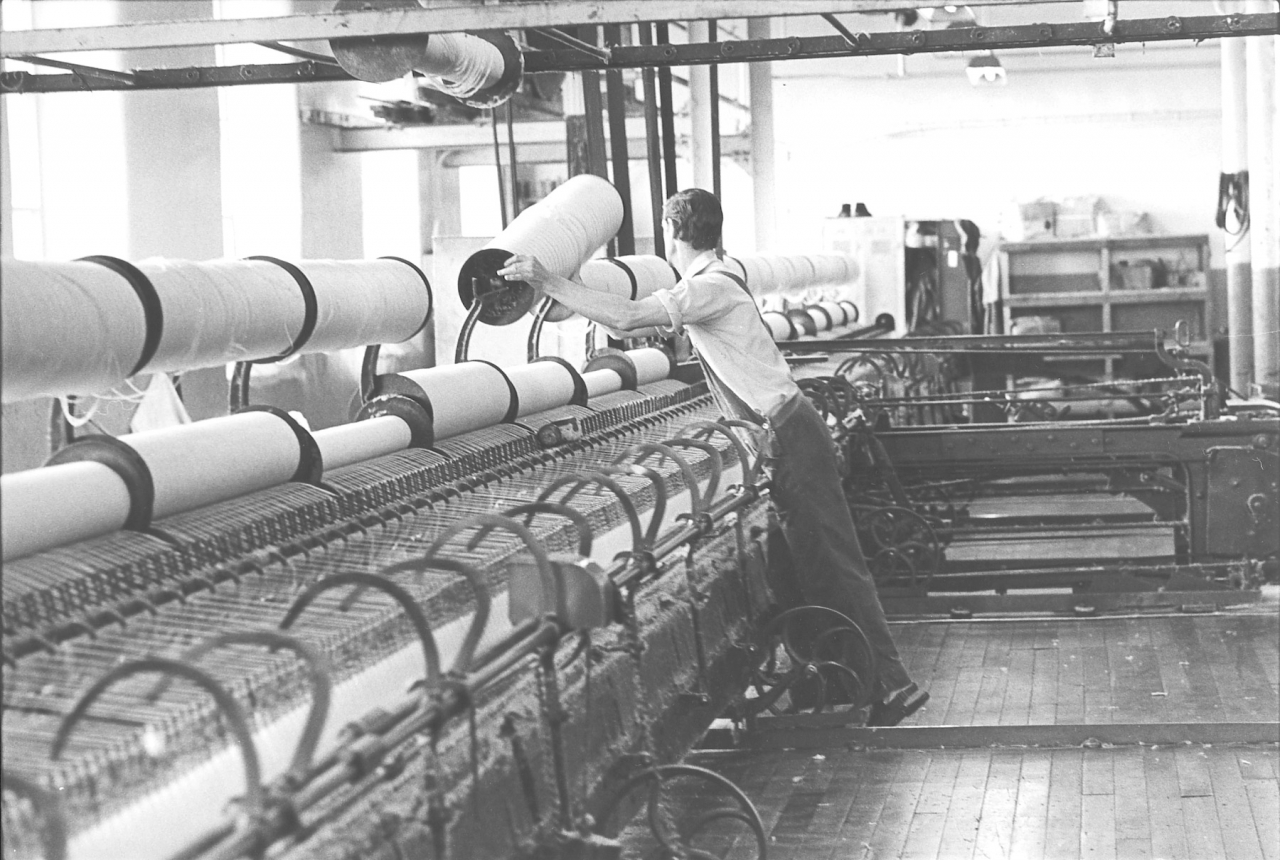
R- 60. [SVspinning]
You put me right, we are starting on 60 that’s it. Now, you tell me what you're doing Jim.
R- 60. Now this picture is where I'm putting a full bobbin on the mules what's just been taken off the bobbin rack.
Yes. And of course that's the only time you can put it on, when the carriage has moved right out isn’t it. Well right up to the…
R- Yes. Well, right in, right up to the roller beam, yes.
Right in, yes, up to the roller beam. And there, aye, you have been doing fairly well for bobbins that day haven't you?
R - Yes, well, it was nearly a full creel there you see. Whether that’s because there were another pair stopped. Sometimes if one mule stopped and there's a spinner short then we, you know they accumulate does the bobbins.
Yes. Now just remind me, you told me how long those bobbins lasted on the mule.
R- They last about four hours.
Aye.
R- But there is different sizes of flanges, what they call flanges on the bobbins, some small and some large. The large ones, if they fill the bobbin to the top, those'll last five hours. Well that’s a long while for a bobbin.
Aye.
R- And the more big ones come up, then you have less creeling to do you see?
That's it, the better you like it.
R - And better we like it, the more weight we get off.
Yes. And creeling is what the next three pictures are about, isn’t it? Right, picture 59.
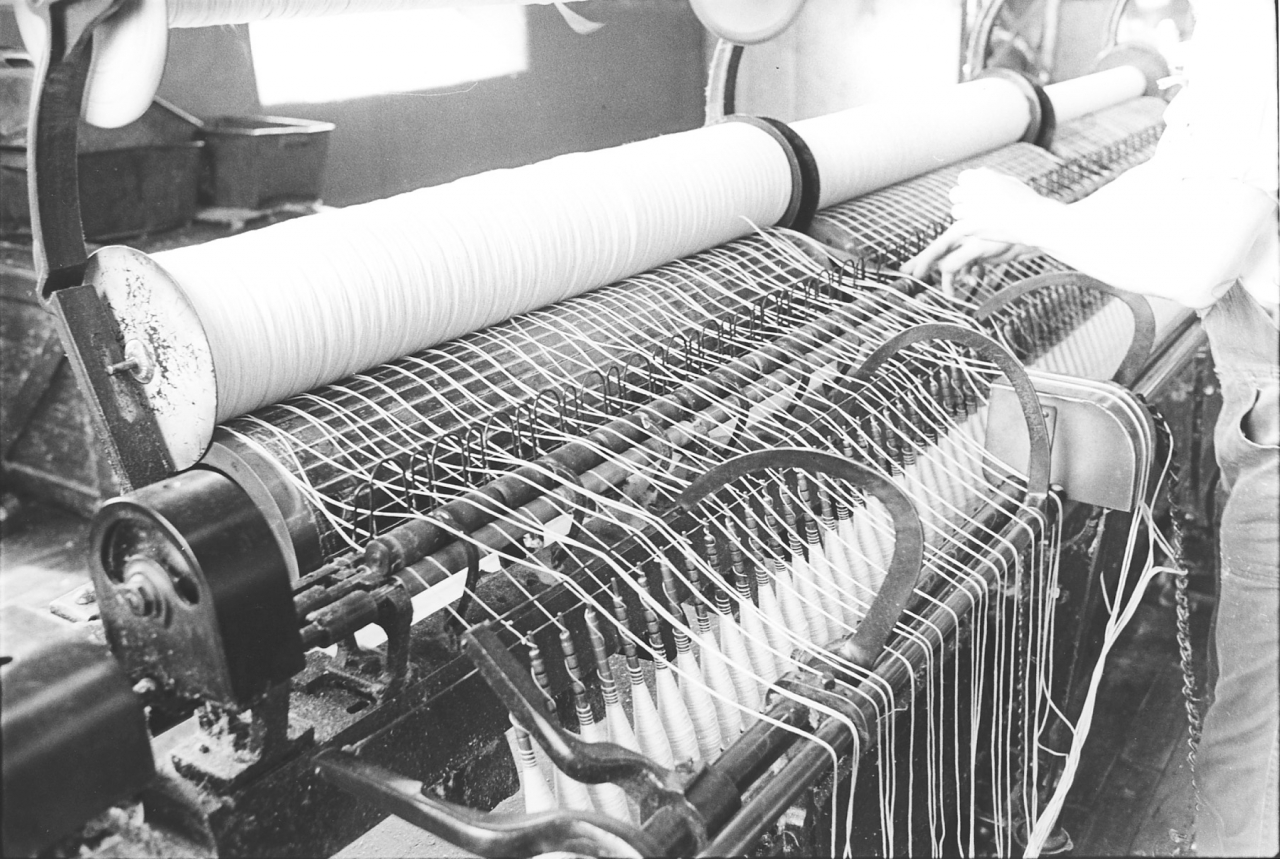
R- Yes well, this one's 61. That's where I've put one in, a full one, in place of the empty one, which I've just taken off.
Yes. Now, when you put it on, I’ve noticed you seem to do it without even thinking about it, but you sort of hold it in front of the bobbin beam and run a bit off it, and then lay it down on to it, so that all the ends are laid there ...
R – That’s right. All the ends lie straight.
Yes. And will they sort of automatically fall in between the, what do you call these little round V shaped wires?
R - These, these are guide wires.
Guide wires, yes.
R - This guides your ends down through it and into your rollers.
That’s it yes. Now when those are all laid on there, tell me what you're doing there, tell me what you are actually doing when you start off.
R – Well that’s when I've laid the bobbin in the creel and the end's out. All as I do then is break the front end off [and piece it on to the ends of the new bobbin] the back end, the ends, the old end of the old bobbin what I’ve took off. So as a matter of fact it’s a double end because I’ve twisted the two ends together.
[I’ve had to edit that pretty severely, the original didn’t make sense. SG]
Yes. Now when you take the old bobbin off do you break all those ends first or just break it when you're pulling the bobbin off?
(100)
R- No, I break it when I put the full bobbin on. I put the full bobbin on to the empty bobbin and then take the empty bobbin off. You can take the empty bobbin out before you put the full one in by just running, simply running your fingers across the ends and then you break them out. But we were always taught when we were younger, when we were learning spinning, always run your fingers along the guard wire there and break your ends out because you'll have a shorter end then to piece up. You won't have a long double end, if you know what I mean. There'll be less of a double end going through to your cop. But this is where they’re all laid out and then I just start piecing one after the other.
So you'll piece between the roller and the guide wire?
R- That’s right yes.
Yes. And when you piece you don’t tie a knot, you just twist them together don’t you.
R- All as I do is break it and twist it with your fingers.
Just twist them together. Yes. I know it looks deceptively easy but I’ve no doubt it’s nowhere near as easy as it looks.
R – No it isn’t easy, no.
Now, something that I’ve just noticed on there, that rail that the bobbins are on, that the pikes on the end of the bobbin are resting against, there is a slot in it isn’t there, half way up there.
R- Yes, that's for to put your empty in, instead of taking your empty one out you can just move it up and put them in these little slots here before you put your full bobbin in. Because sometimes, if you put your full bobbin in when your empty one’s in you are liable to catch the side of your bobbin on to your flange. If you are taking your old one out you can catch the side of your new bobbin. So that's what them's there for so an you can put your empty bobbin into it before you put your full one in.
Aye. And does that lift it up far enough for you to be out of the way ?
(150)
R - It lifts, it lifts it up out of the road of your flanges so as the flanges don’t get caught. And then again, another reason why them come in handy, when you are scouring [cleaning], you don’t need to take all your full bobbins off the top.
You just shove them all up.
R - You can just shove them all into them little recesses.
That’s it aye. To get them out of the way of the rollers, aye.
R - To got them out of the way of the rollers you see.
Yes, so you can clean underneath them.
R- And of course this is your wheel end.
Aye this is actually right at the end of the frame isn’t it.
R- This is your wheel end, at the end of your rollers. And they have a, a roller there, at the end, with teeth on them. Well it's called the pinion that.
Yes. Right, turn over Jim, let’s see what's happening on picture 62 because you are piecing on your own, creeling on your own there.
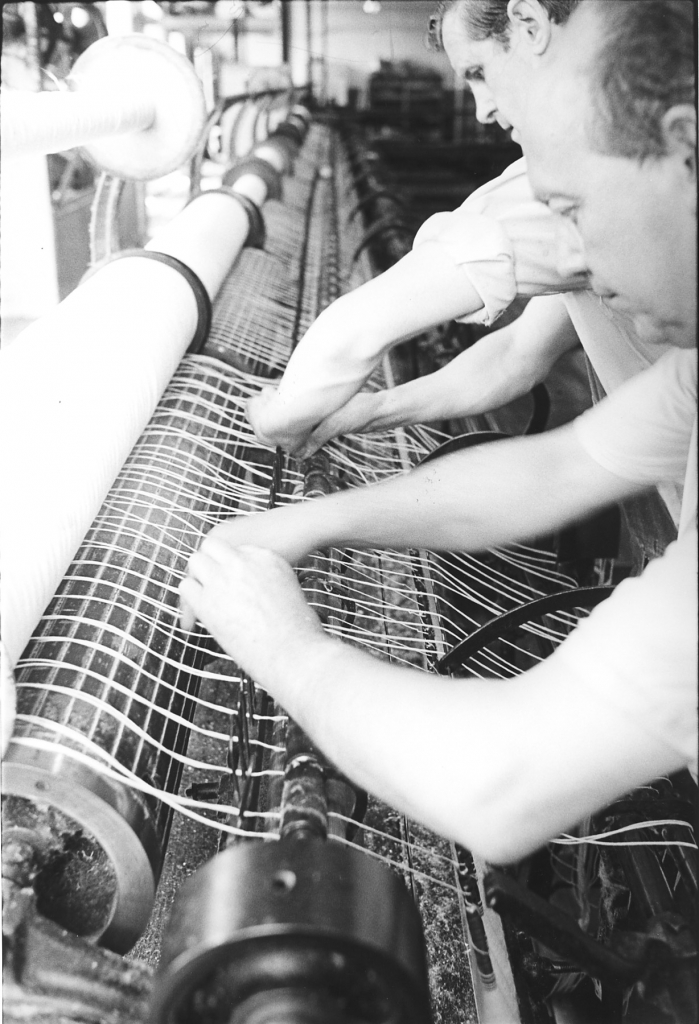
R – Well, on 62 that's piecing up with my mate.
Aye. Tommy’s come down to give you a hand.
R - He's come down to give me a lift, Yes.
Yes. Now tell me, I’ll ask you this question, I were going to ask you before. Now I've noticed that most of these ends come straight down, but some of them are crossed. Like the outside one, nearest to the camera here, it's crossing over inside and the inside one’s coming out. Sometimes you have them crossed, is there any particular reason for that?
R - Not really no, but sometimes you, if you don't cross them over you'll come with your side end down and if it's straight it'll run off the side of your roller. So if you cross your end over it’ll not run off them.
Aye. That's it, it's tending to pull it in all the time, it’s tending to hold it against the outside of the guide wire. Yes, that's it.
R- That’s right, yes. And then some rollers are just a little fraction shorter than others. And if you don’t cross your ends then it'll keep running out from under your roller. So that's why we are crossing them.
(200)
Aye, that's it. And of course 63 is the same, it's the same bobbin but it's all been pieced up.
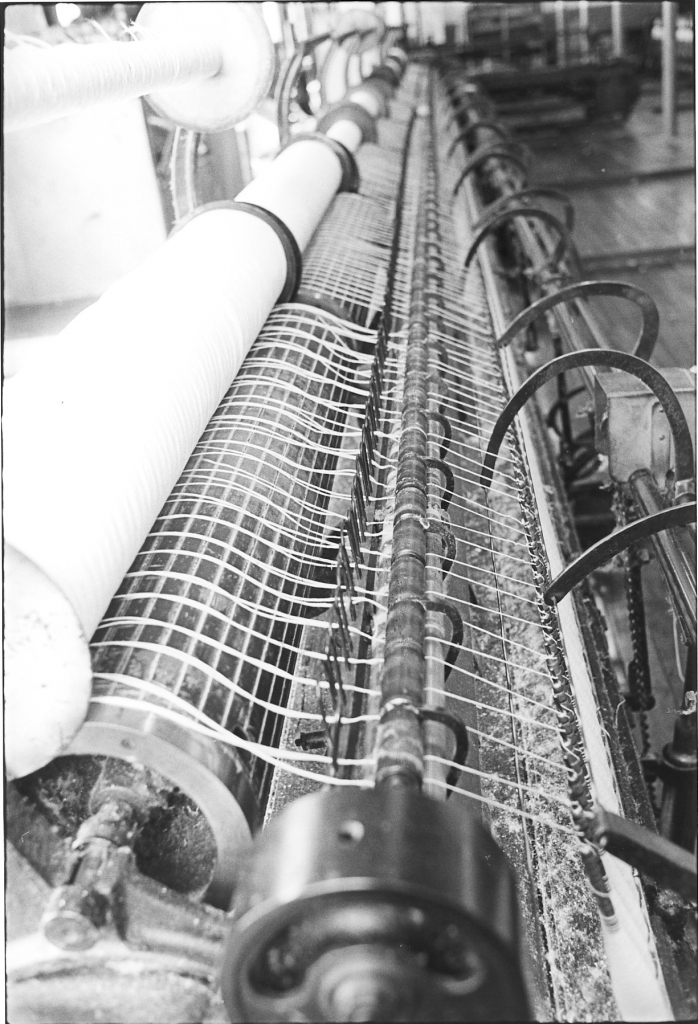
R – It’s the same bobbin, that and it's all been pieced up ready for setting on.
Aye. And I know the speed you work. I don't suppose you've any idea of how long it takes you to do that, have you?
R - No, not really. I haven't time to count.
It didn’t take you so long. I know it doesn't take you so long. I should think if you were pushed you could do one easy in 15 seconds on your own.
R - Yes certainly I could, yes. It doesn’t take long.
And I know when two of you get at it, it isn't stopped for two minutes.
R – No.
Now, you don't have to walk up to the middle of the mule to set it on again from there do you?
R - No we have what you call a starting rod which runs underneath them sickles. And you just set it on and it's worked from the headstock.
So you can stop the mule any time, that’s a safety device as well, isn't it?
R- We can yes, we can stop it anywhere in that wheelgate, wherever you are you can stop it.
Aye. Yes, if you have got anything faulty, if you have got your foot under one of the carriage wheels, you'd have a chance of stopping it, wouldn't you? Aye, that's it. Very good Jim.
R – Now, on picture 64..
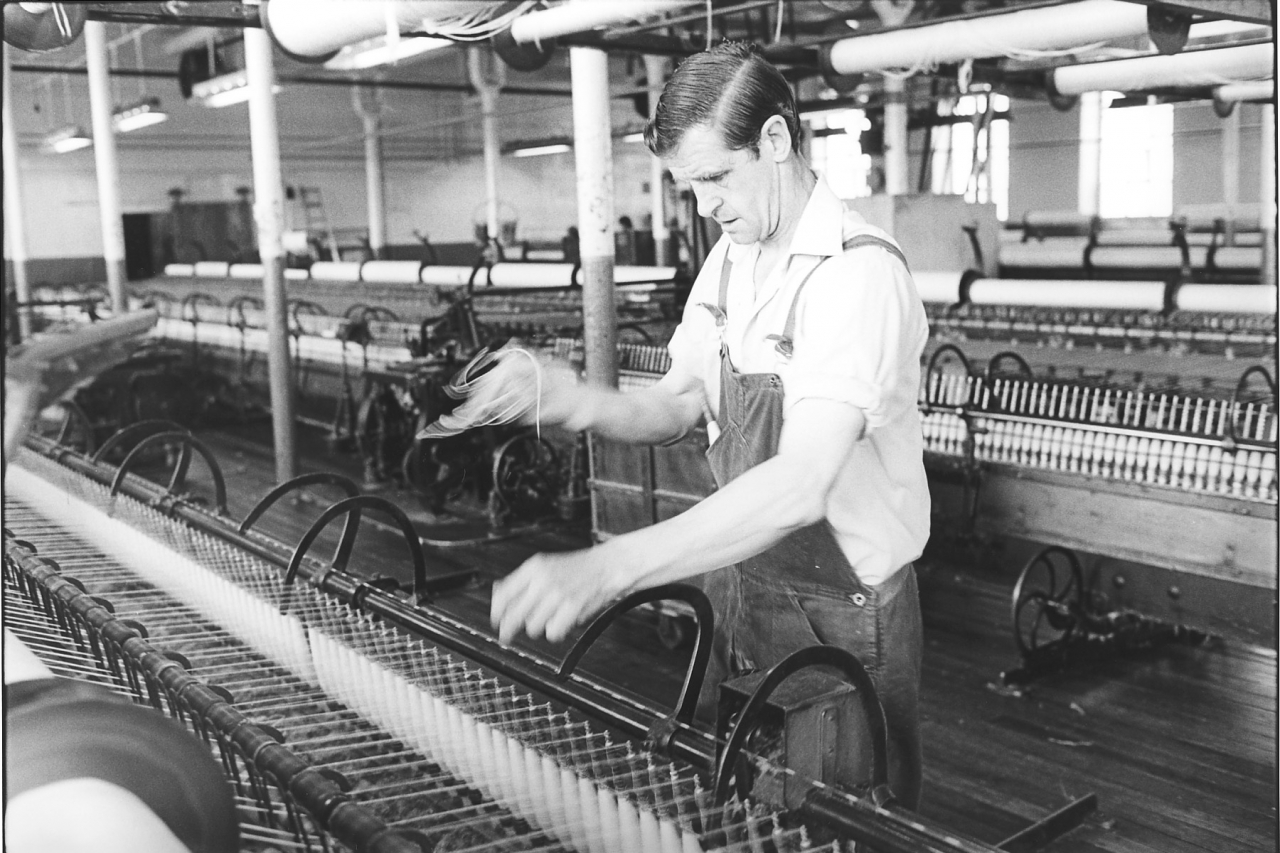
Oh yes. Now this is a set of pictures I like. Now, just before you start talking about these pictures, this set of pictures from now on, really you could say that it's what 90% of spinning's all about isn't it? Piecing ends.
R - That's what it is, it's such as this is the main thing isn't it, that's what I do.
Yes. Piecing ends up. Right, we’ll go through these now and you'll tell me as much an you can about it.
(10 min)(250)
R - And this picture 64 is where I've just pieced the end up and I'm just winding the waste round my fingers, off the end what I've pieced up. What could have dropped down on to the carriage. I'll wind it on to my fingers. It’s better picked up that way you know and that goes into the waste bin.
(250)
And your left hand's flying out again towards the …
R – Yes, towards the end…
And you are just going to feel the tension there, are you? Just feel it.
R - Just to feel the tension. Well, sometimes you get a little bit of a loop on and all as you do is just twist with your fingers to straighten it out, you see.
Yes that's it, before the carriage starts drawing out.
R - Before the carriage starts drawing it out. Then you don't get a big lump on it and things like that.
Picture 65.
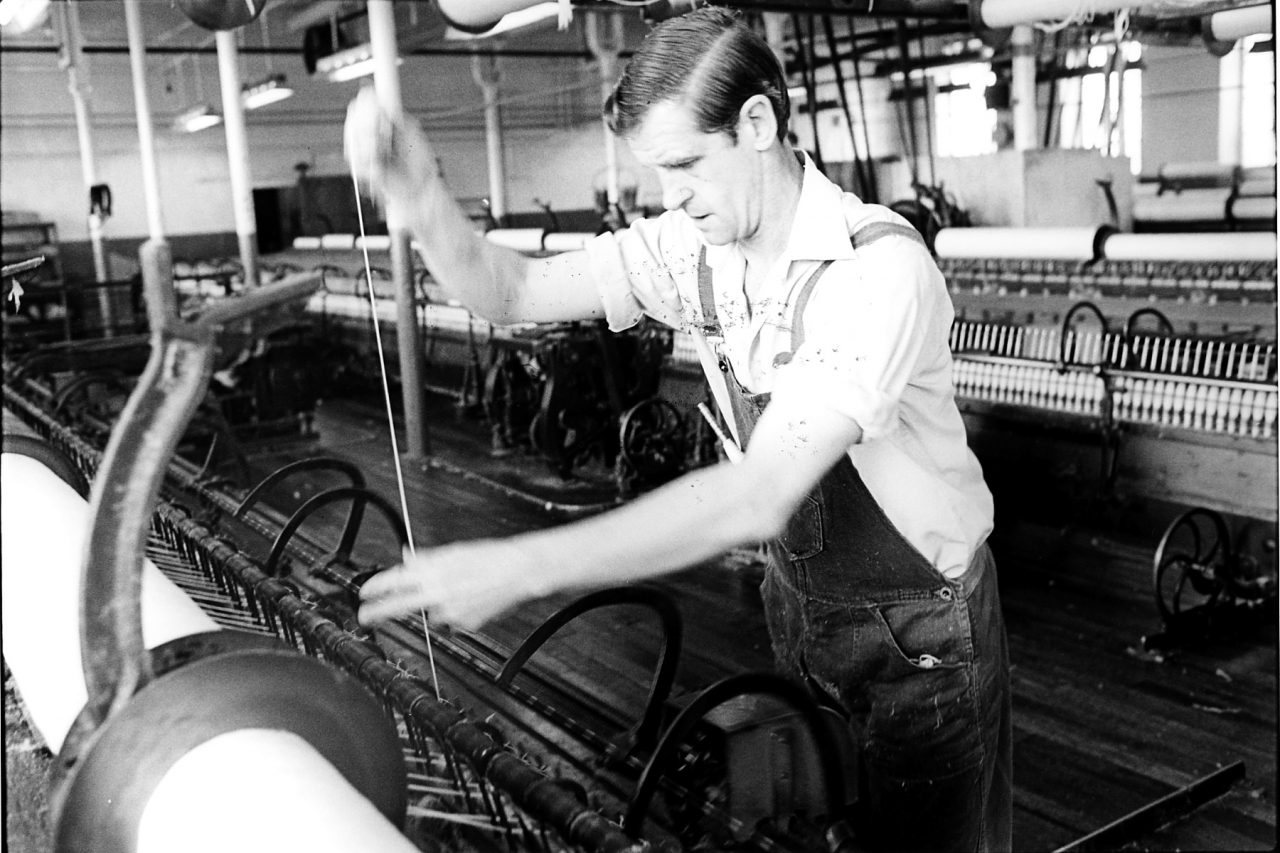
R- 65 is where I've pieced up. This is where I have pieced it up going into the roller beam. I’ve pieced it before the mule touches the roller beam, and that’s the loose end what's broke off and I’m pulling it up out of the way. Which you can pick up before it comes in. That's the only place you can pick them up when they are going in, just before it touches your roller beam.
Aye, that's it. Now, just before it touches, because of course you can't piece up when it’s coming away because you have got nothing to piece up with have you?
R – No. Well that’s towards the end of the piecing there you see. Pieced up and then it comes out again you see. It's pieced up.
Yes, that’s it.
R- But a lot of spinners won’t pick up waste like that, a lot'll just piece it up and drop their end on to the carriage and then pick it off after when your mule starts coming out. A lot depends on how much waste in on your carriage at the time. If your end's been running down a few draws then you’ll have a bit of waste on your carriage. Then you’ll piece it up and drop your end on to your carriage or you might wait while it hits your roller beam, comes out, and then you'll piece it up and then you can take all your lot, all you have, all in together then.
Yes, that's it, because it’d be very easy to break some more ends when you were pulling that out wouldn't it?
R- That’s what happens, you break your ends, the other ends then. It goes on to your other end. And it’s only when you've about half an inch or an inch of your end you can gather it up. It's going in, but I don't know how much there is on there like. I don't know now, that might be the end, you see and I just pull it up and the end's coming up off the carriage there.
(300)
Aye. Picture 66 now. Yes, you have, you've just pulled it, that’s it, you have pulled up, you are balling it up in your hand, oh no, you’ve got hold of a cop haven’t you.
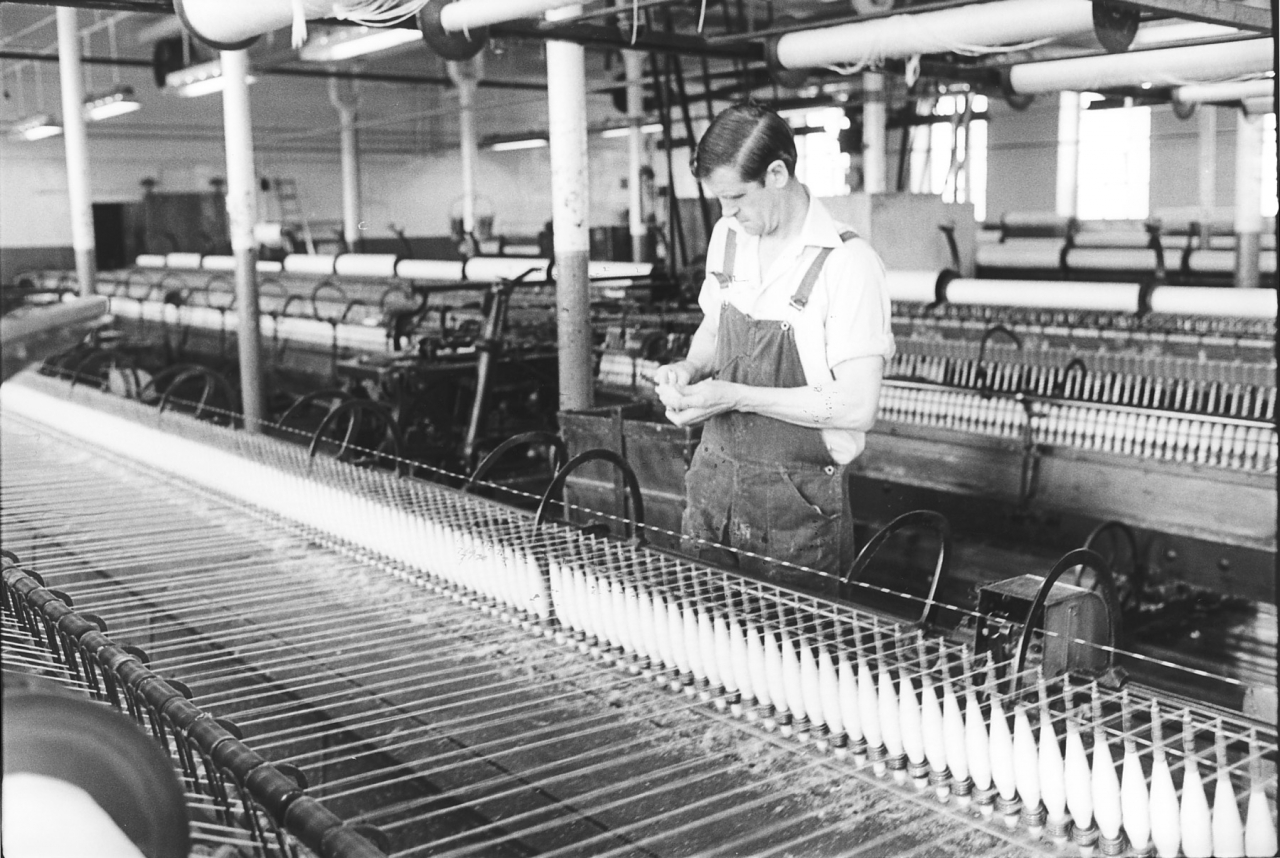
R- I’ve taken a cop off there.
Aye.
R- It’s probably got some waste on, picked some waste up off the carriage and it's gone round on a cop. So, instead of holding the cop there, with the mule running I've taken it off and there I'm taking it off, taking the waste off, pulling it off, and finding the end.
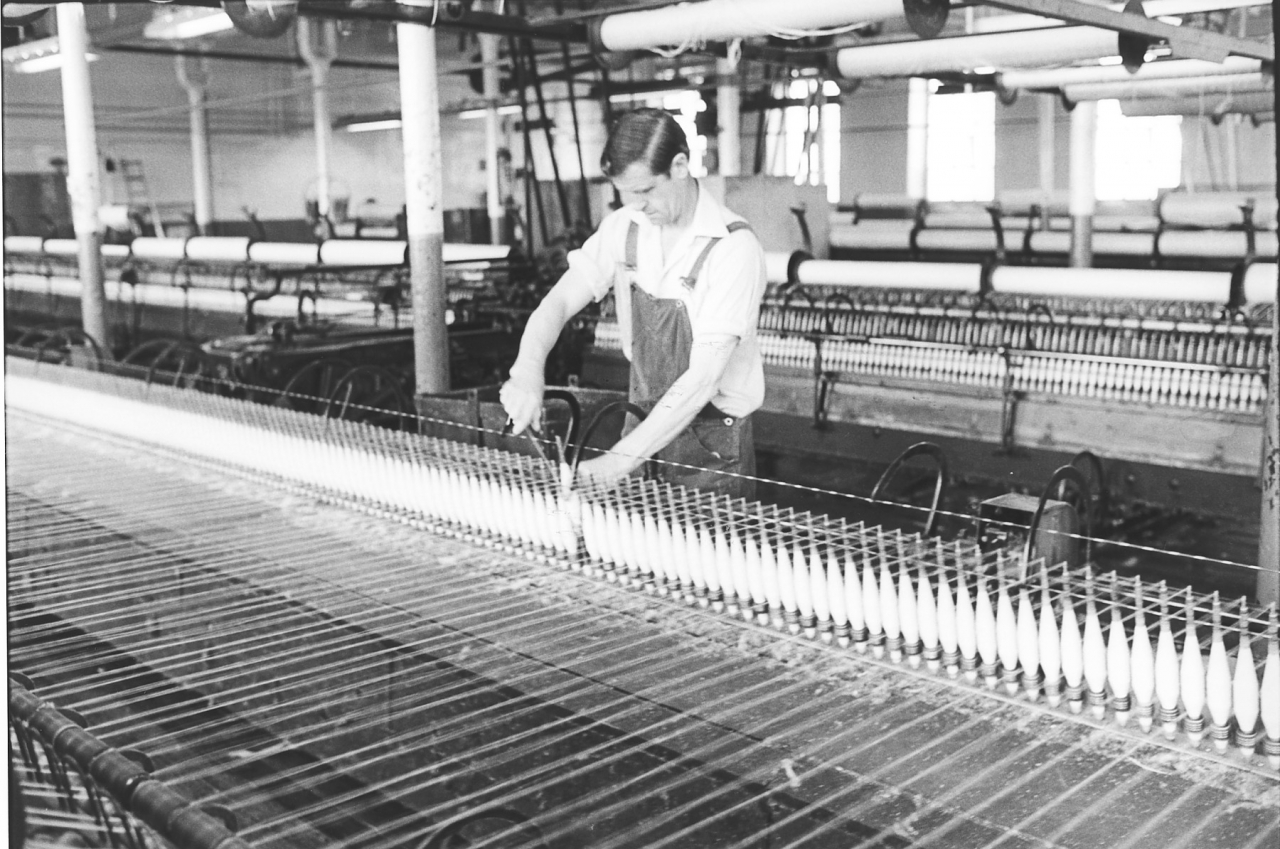
Now then, number 67, this is where I’ve wound it all off and I'm putting my cop back on to the spindle, ready for to piece it up again. You see?
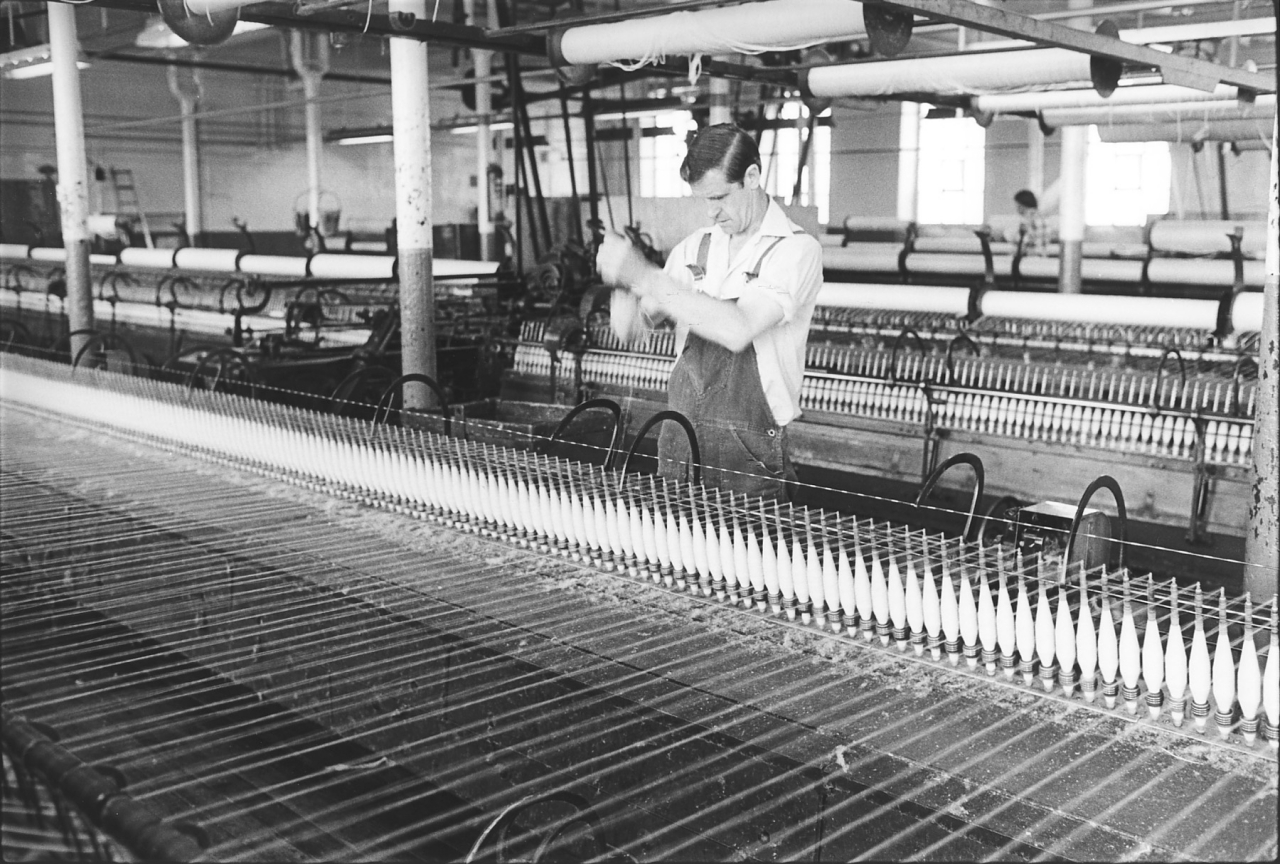
And 68 I’ve just put the tube on there and what I'm doing there is just getting my cop level with the others. I've put it on and I’m just taking a bit off, so as it gets level with the other cops.
Aye, you can see it's up a little bit there, yes.
R- I can, see it. Yes I can see it's just raised up a bit down there…
Because you’ve not just pushed it down so far have you?
R- No. But, you see, if you push a cop farther down, then you'll get a nick in it. [because of the stage the winding of all the others has reached] It’s got to be level. If you raise it up a little bit and just take a little bit off…
Yes. That's it. Aye, you are sure it's right, you are sure it's right.
R - Then you can gauge it against the others.
Yes. And there, in picture 69 you are still pulling some off it, aren’t you.
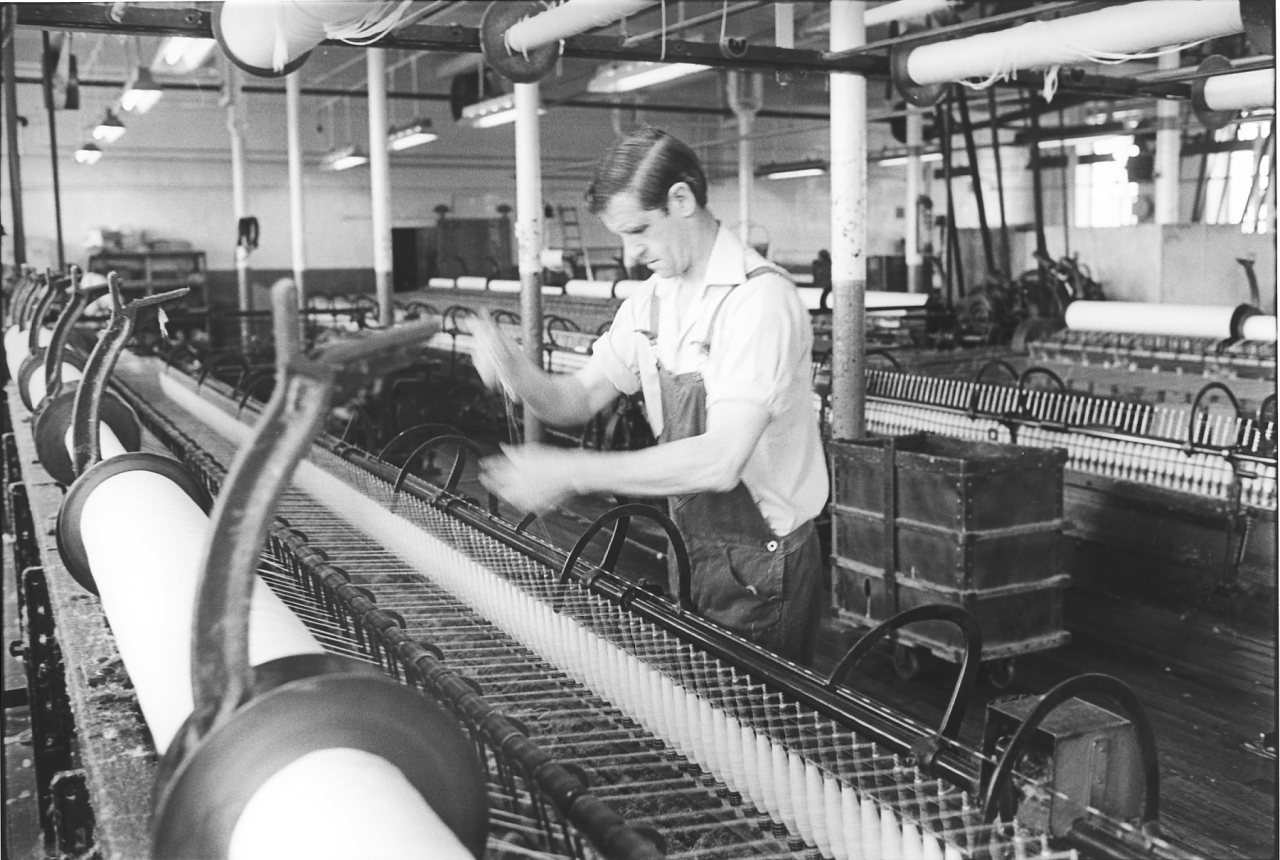
R - I'm still, yes, I don't know whether it's the same end or not.
Yes it’s the same one, it was the next negative. You see, the negative number tells me it was the next negative.
R – Yes, that's right Yes.
It were only a fraction of a second after so it was when the carriage was…
R - Coming into the roller beam. Yes.
Coming into the roller beam again.
R – Yes well, I probably hadn't just wound enough off. I'm just winding a bit off there again.
Yes you are still winding it off. Aye.
R - And 70 I’m still doing it.
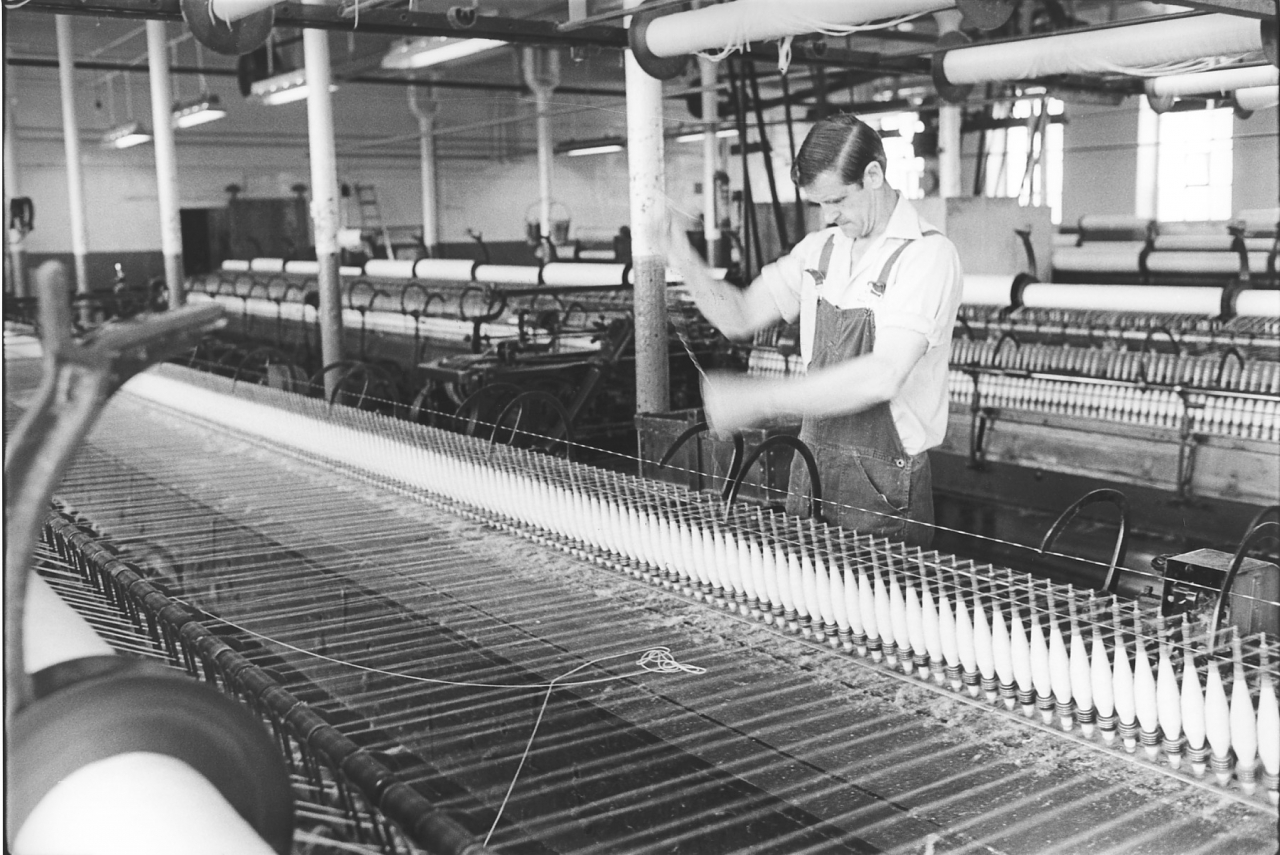
You are still winding it off. Yes, and there's the end…
R - There is the end running down on to the carriage.
(350)
The end running down on to the carriage, yes.
R - Still winding off.
Still winding off, you have not got it right yet.
R - No. And 72.
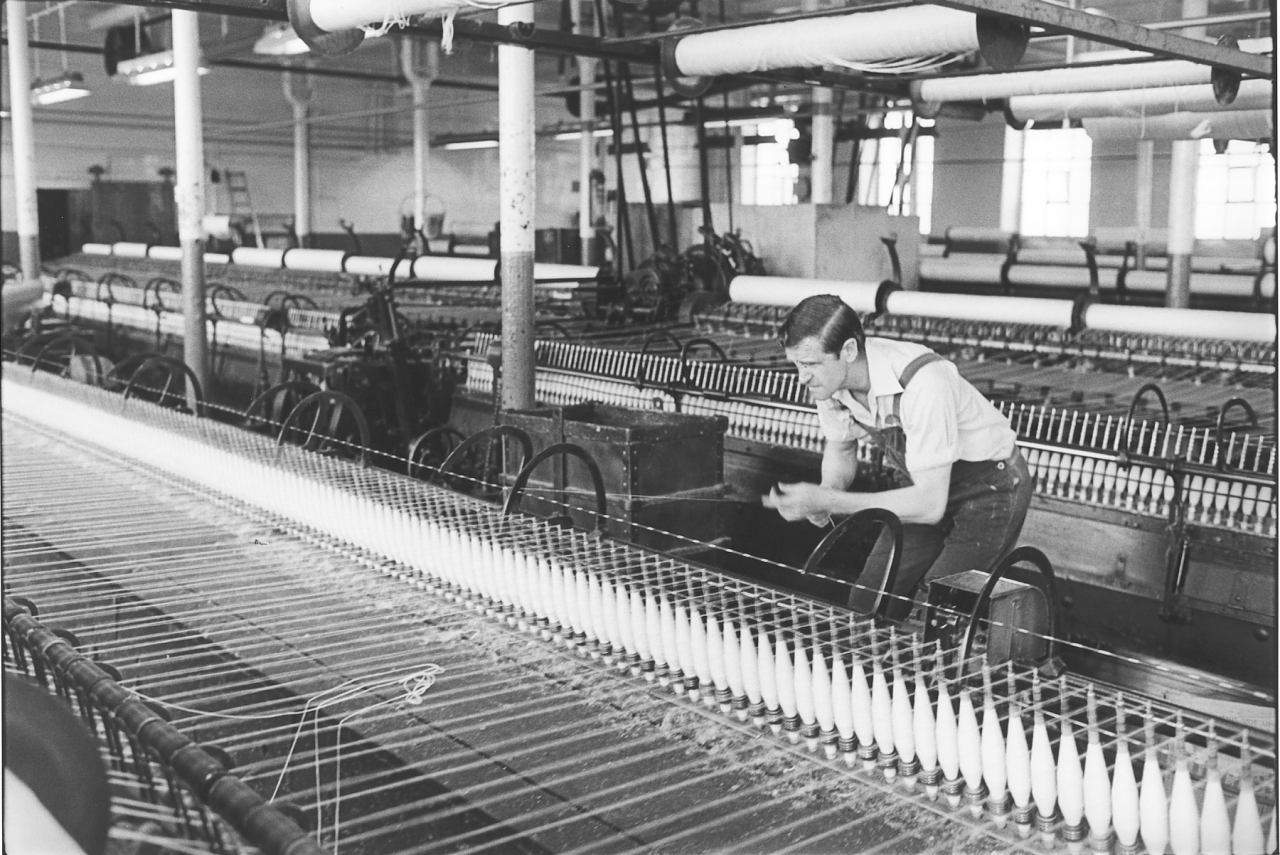
And 72, now then…
(15 min)
R- That's where I'm looking to see whether it's level or not, with my other cops you see. Now then, it looks like I've got it level there.
And you can see the waste under the carriage, how it's built up on each draw.
R - Each draw it builds up, yes.
Each draw you are getting a bit more laid under the carriage.
R - Getting a bit more and a bit more, you’ve got a lot there after a bit.
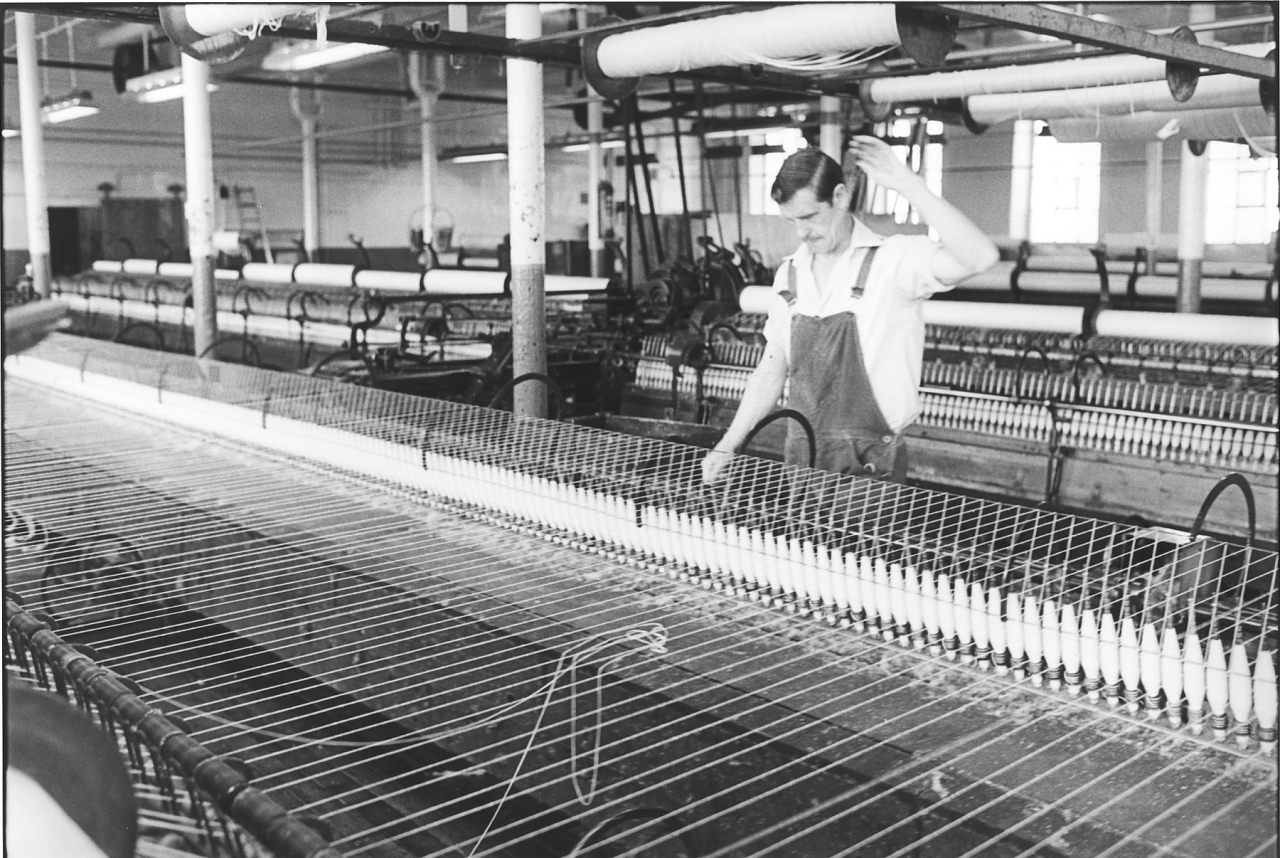
Now picture number 73. Now I’m satisfied that it's level with my other cops, it’s ready for piecing up when the mule goes in.
Yes, and you are holding an end up there aren't you?
R – I’m holding the end up for, from the spindle.
You see you can't [see it]. Yes, it's vibrating so it’s not showing [on the picture] you can see it there, you can just see a bit of a blur there where it is.
R - So it's not showing, I can just see a little bit of a blur there where it's up.
And course you are moving that fast you know. You don't realise how fast you move.
R- Yes, and picture 74, that's where I'm doing, I’m piecing it up.
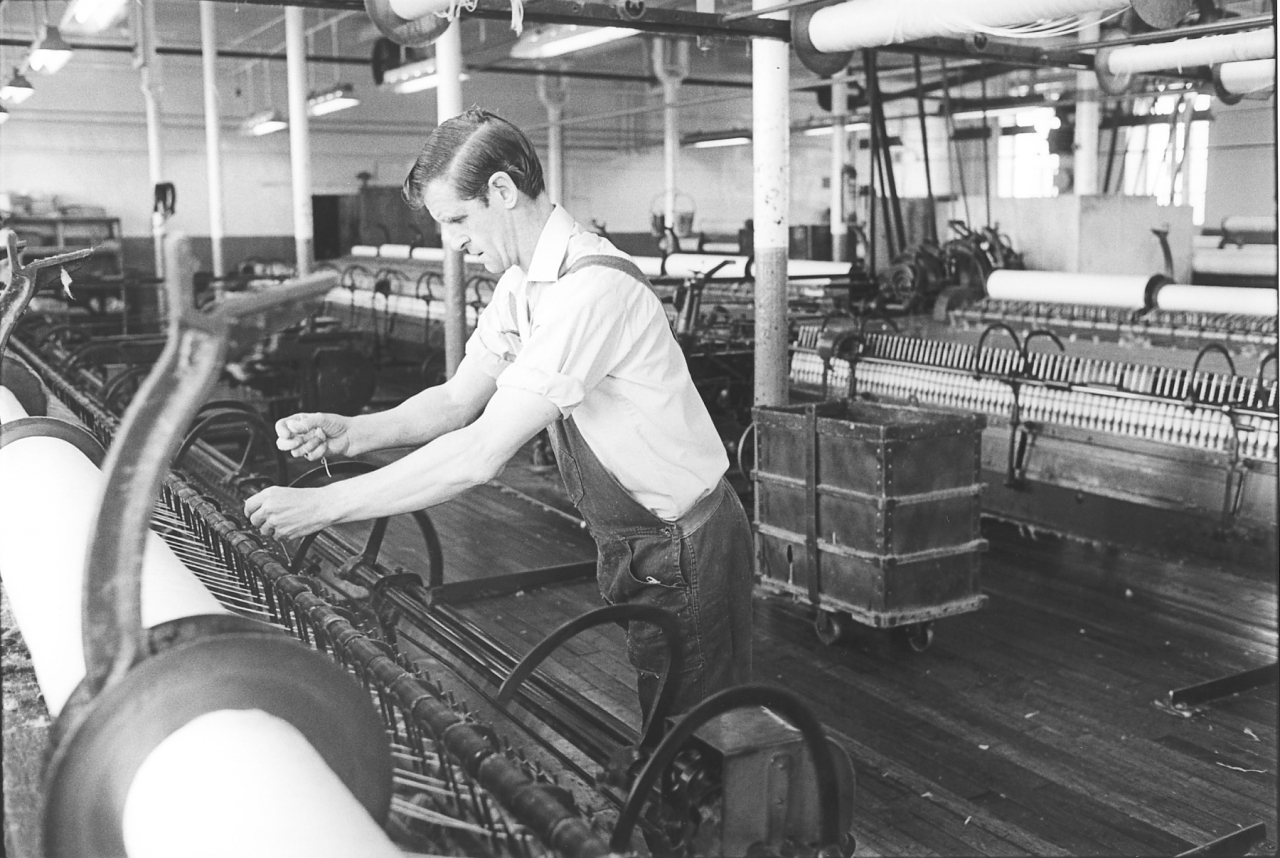
That's it, you are piecing it ...
R - That's, I'm piecing it up when it goes to the roller beam again. There you see?
Yea, that's it, aye.
R- Or rather I’m going to piece it up then I decide not to do it then. I decide to piece it up when it's coming out.
Yes. Aye, this here, look at the muscles in your arms, as your fingers are going up, that's with your fingers twisted isn't it, right back.
R - There yes, they are twisted, they show all the muscles on the back of your arms yes.
You know, have you seen them twisting and showed all the muscles up. Aye, right, picture 76.
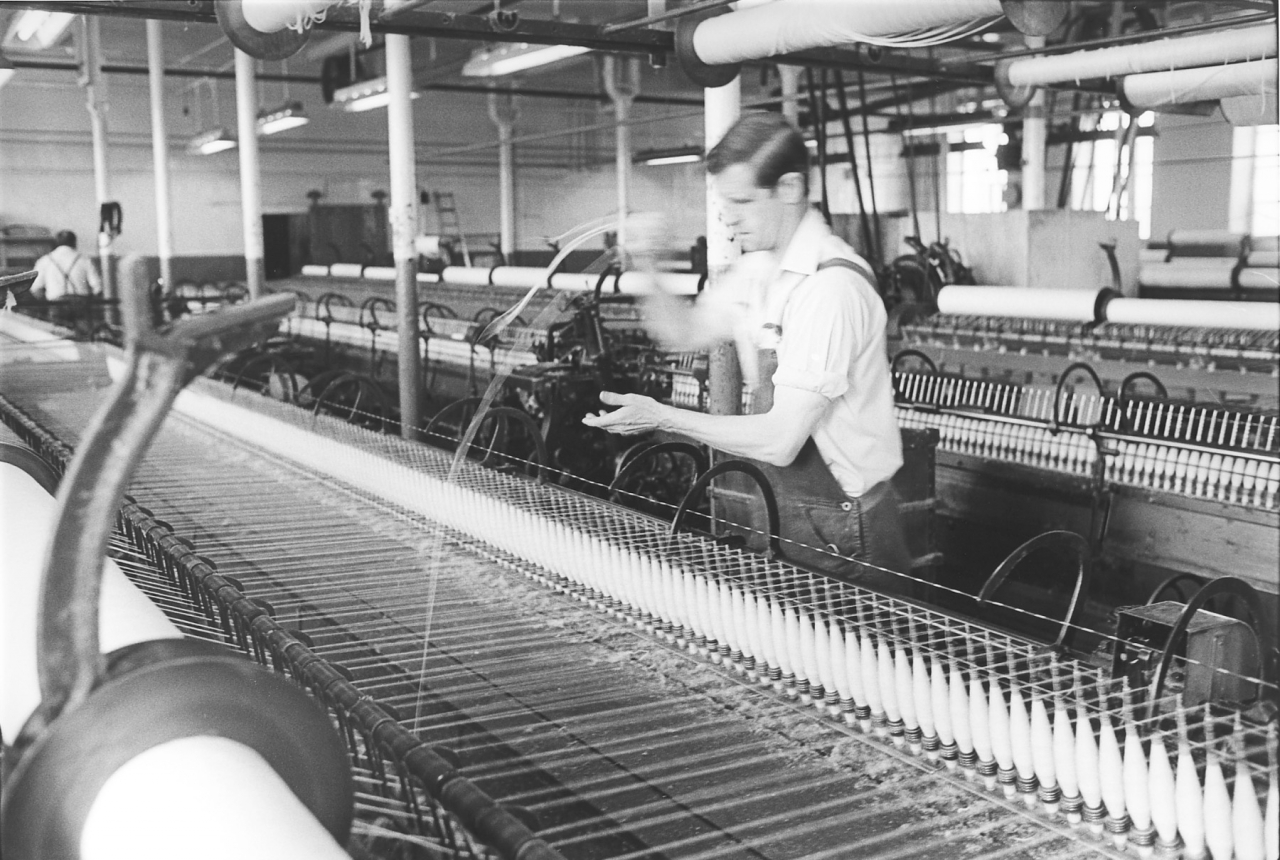
R - That's the end of that piecing.
Aye, it's not quite, there you are.
R- Now on 76, this is where I'm taking all my waste up, what would run on to my carriage previous to my end running down.
Yes, and you can see it flying out. I've noticed when you do that, you reach down through it don't you? And then you sort of bring it out in one smooth movement.
R- Yes, one movement right out.
Yes because…
R- And you do it like that in perhaps two or three movements, it just depends how much you have on your carriage.
Yes, that's it. Because if that end caught up in those other ends as it was coming through, it'd just break those ends out wouldn't it? It’d just twist up between them and you'd have two or three ends down then.
R - Yes. Sometimes it won't do, sometimes it'll go on to the end. What I do [if that happens] I break it down, because you haven’t to let that [double yarn] go on to your copy you see? So you break them all down and start afresh.
Yes. And on picture 77, again, you are balling it up in your hand.
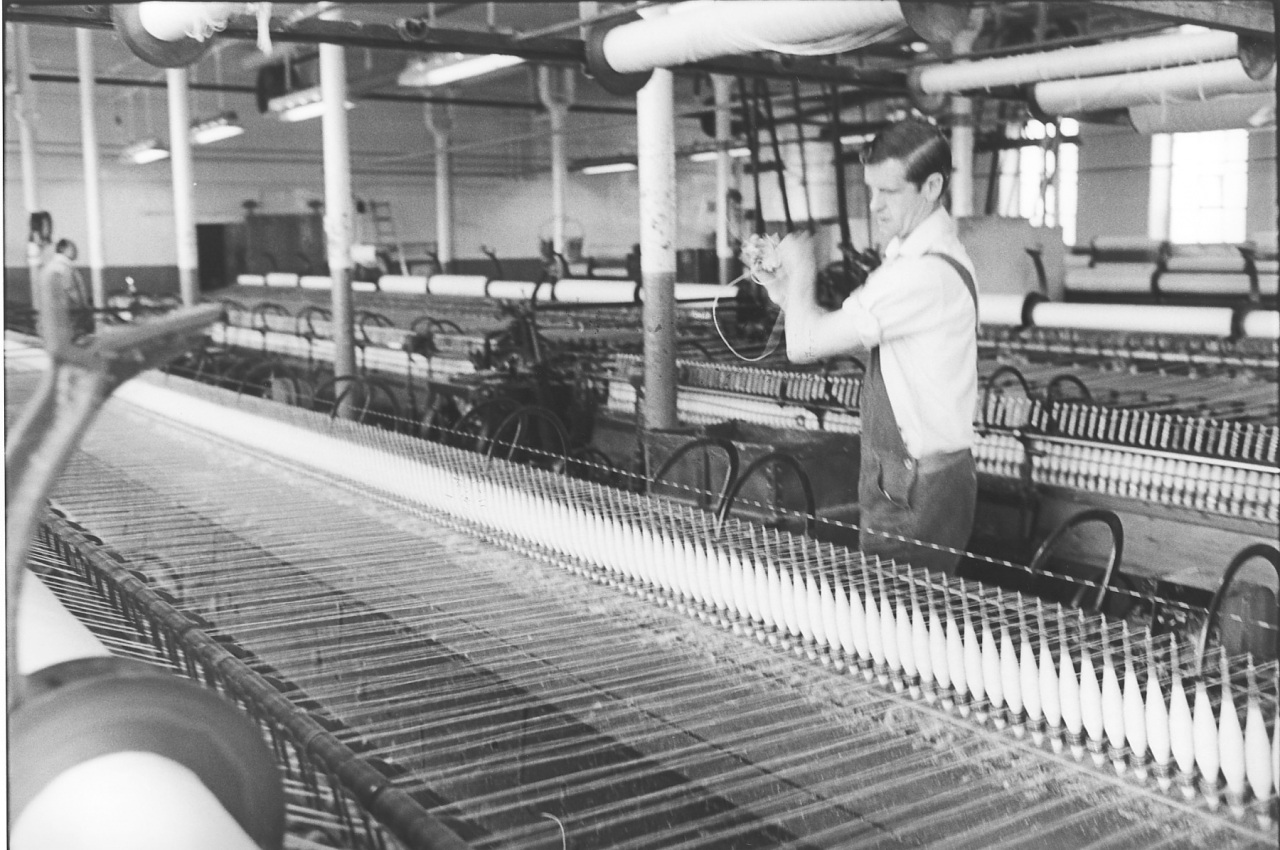
R- And 77, then that's finished. I've took it all off my carriage and that’s that. The end is completed.
(400)
Yes, well, I don't know but I can't remember whether 78 is a picture of it. Ah, that's it, it were just, that's just completion.
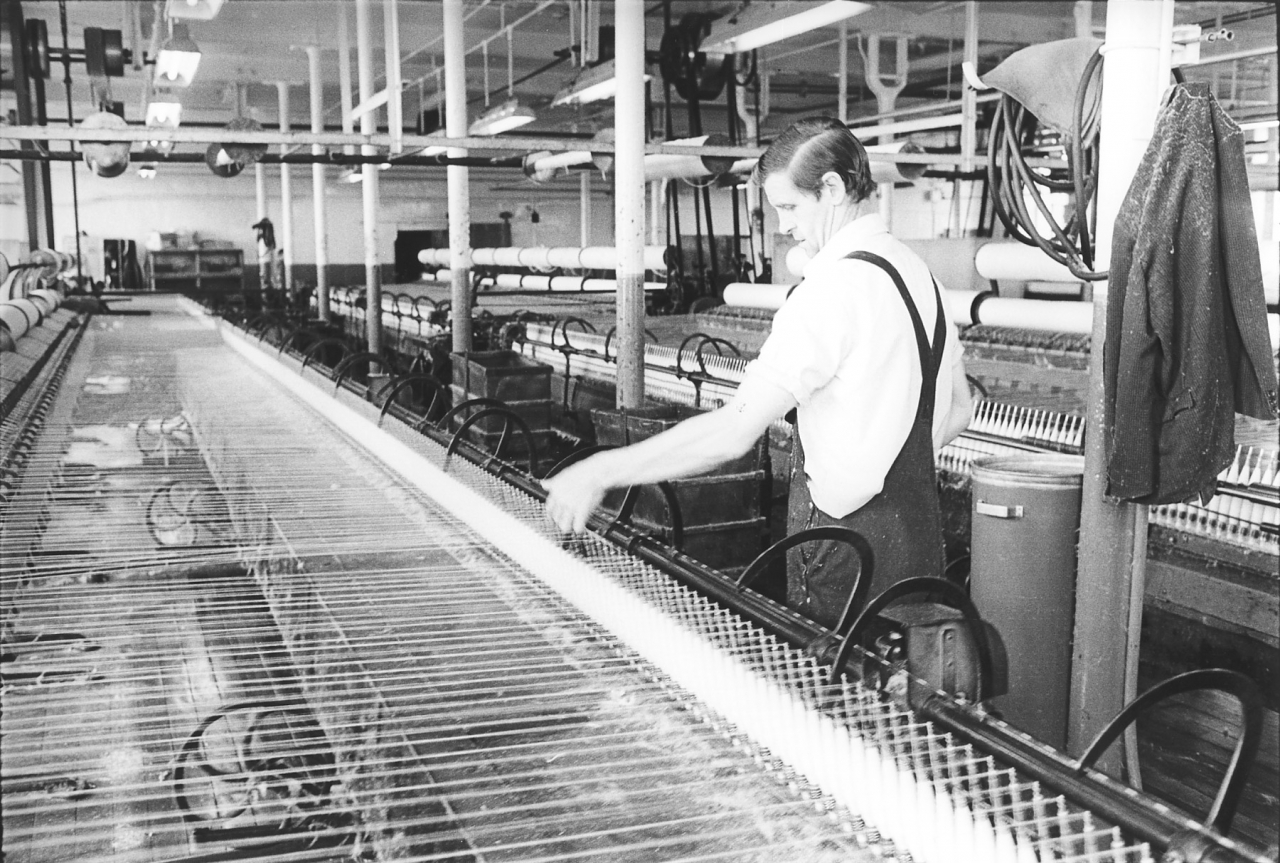
R - That's it. I’ve just completed. And then I'm just feeling the tension of that end and what have you off this.
Yes. I notice you just reach down, you don't just pick one up, you pick two or three up at a time, don't you?
R – Yes, finger span, three, four or five. Yes.
Yes. That's it. And that's just to compare them is it?
R - You just pull them up gently just to test them. You test that end what you have just pieced, if it's the same tension as your others.
Yes, that's it, aye. Tapers do exactly the same thing when they're taping to find out whether the yarn's elastic enough. They'll just pick one out you know, a very fine end, probably about 44s, it might even be 60s and just lift it up and let it run over their finger and feel how elastic it is. It tells them whether they've sized it properly Jim.
R – Yes, because sometimes, if your piece an end up when your mule's coming out and you've pieced it up too late you just need to feel at your end, and if it’s not twisted enough, you can feel it's soft.
So if it is too soft, what can you do about it?
R- Well. If it is too soft you break it down and piece it up afresh.
Aye. Is that right? You break it?
R – Yes. You've to break it. You get hold with your fingers and just break it down and then you wait till your mule goes in again and piece it up afresh. But you should always piece it up before it gets half way out as that's when it starts putting all your twist in.
That’s it. It puts the twist in. That's it, aye.
R – The nearer to the back it goes and the less twist in that end. It's got to have, your mule's got to have at least half of that twist in it, half of the mule's got to be twisting it.
Yes. And there again, that's all directed towards the same end, and that’s giving the weaver a perfect cop.
R- Yes, that's right. Because when that goes into the loom, if it's soft spun, too soft, it'll just break won’t it won't weave.
It'll break then yes.
R- And that's the idea of this with your fingers you know, you just keep testing to see if there's twist there.
Does anybody else ever come and test it Jim?
R – Yes, we have what they call wrappings and they're wrapped, I think it's twice or three times a week, Tuesday sometimes Wednesday, Thursday. And they take a wrapping. Now then they take wrappings off cops, two cops off every bobbin. And you send 15 cops altogether for to he wrapped, and they test them for strength. And if they are not the right strength they alter what they call your pinions on the headstock and it makes it [the yarn] heavier or makes then lighter, it just depends which way it is.
Yes. No, as I say, I know that down at Bancroft they have a high opinion of your yarn. It must have been good.
R - It's this particular stuff is that.
It must have been right. Aye. Now then, picture 79. Something a bit
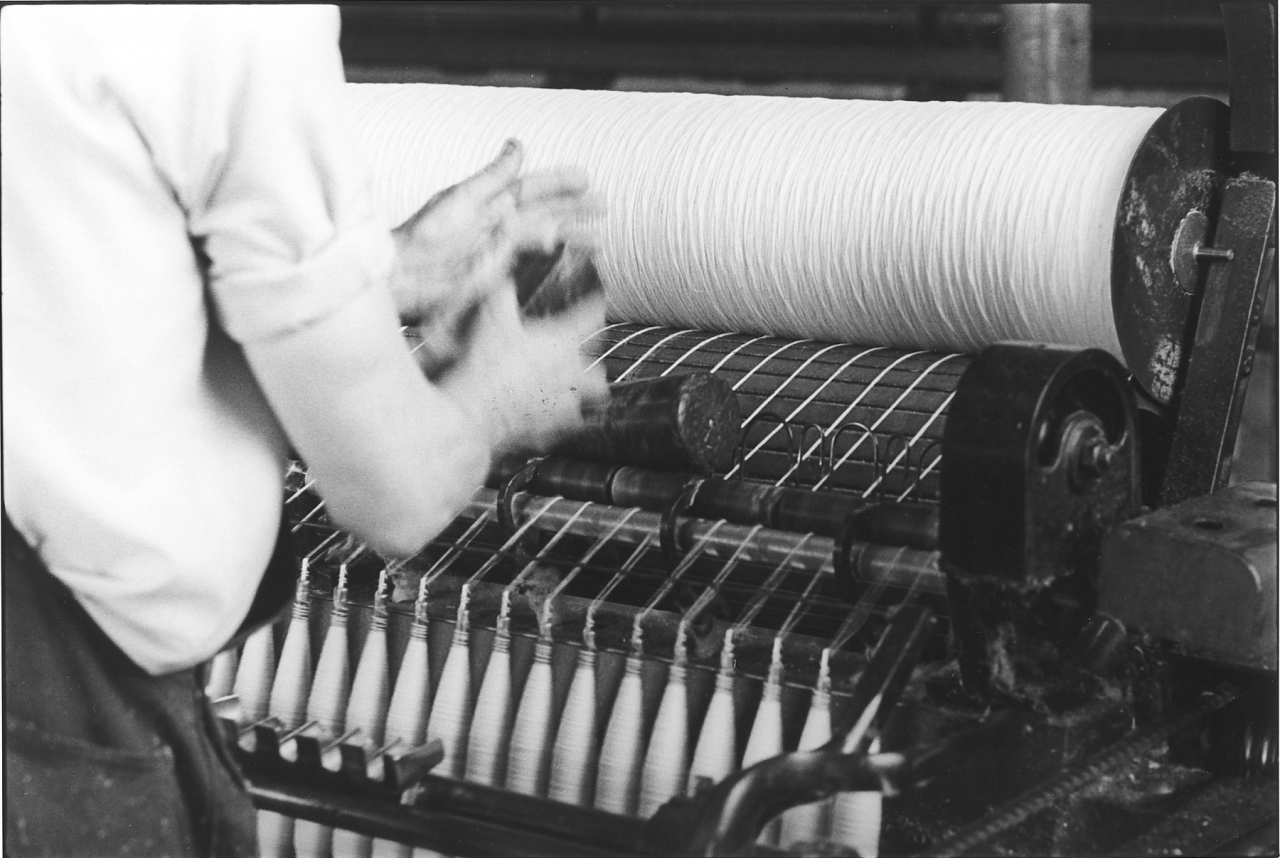
R- This is just a picture of me cleaning my what you call clearers off. And they run across, when the mule’s running, on to the leather rollers and they just clean the leather rollers when it's running.
Yes, just that conical hardwood block, I think there's a better picture in 80, it shows you rubbing it with your hand there and then you’re picking the fluff off.
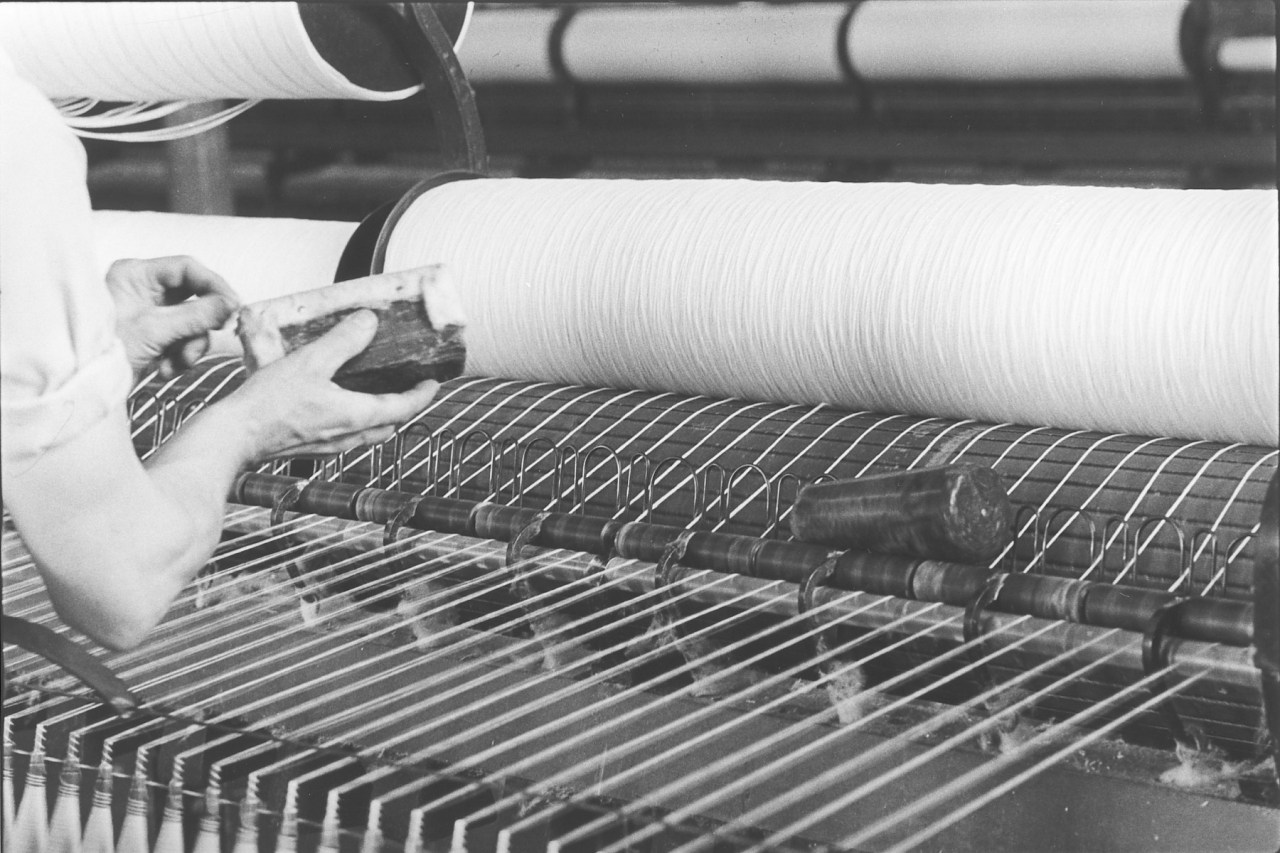
R - Picking the fluff off the ends there. And this is my other one, this is what sends that down the rollers you see.
Yes. Beautifully simple but it works.
R- It’s simple but it does work.
That conical block. How long does it take to go down one half of the mule? Would it take about 10 minutes or so?
R- Oh no, it takes longer than that.
More?
R- About half an hour.
Half an hour, aye.
R – Yes because they don't go right fast, they go right slow. And then there again a lot depends on how many times your mule's been stopped.
It just moves once, when it's been drawn out.
Yes, and of course it only moves when your rollers are going, when you are actually drawing. Yes, when you are drawing, yes that’s right.
R - And it goes slower. Now in some rollers, these, the round one, some has little brushes on, just for to go round and just touches your leather rollers and cleans them up but theme haven’t, there's nothing on them. And there's 81, it's just the both of them together.
Yes, it has a metal end on it hasn't it, that wooden roller. It goes into a slot in the end of that block. Aye.
R- Into a little slot in there near the back there, just for to push it along. Yes.
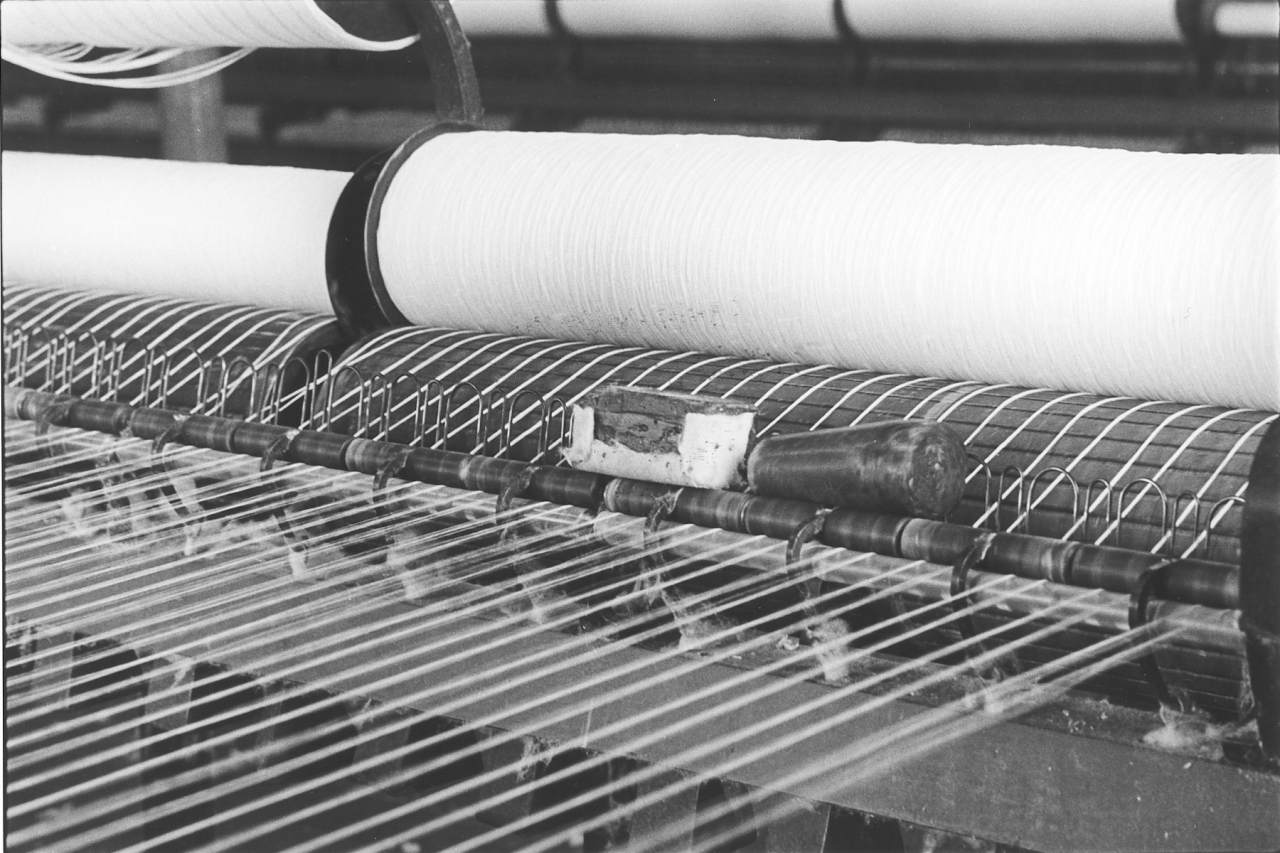
[80]. The clearer quietly moving along doing its job.
It's on a bearing, aye. Yes, there's only one end crossed on there, on that bobbin there on 79. It's the far end of that bobbin that's crossed.
R - Well, this one's crossed here, but you can't see it.
Oh aye, of course you can’t see it. Aye, it's just out of sight.
R - You can’t see it. This is the wheel end you see and you can't see it.
Yes, that’s it.
R - You see the two ends of there but it's out of sight.
That's it, yes. You are right.
R - Because we've crossed all our side ends.
(500)
Yes, you are right again Riley! You are right again.
R - Number 82.
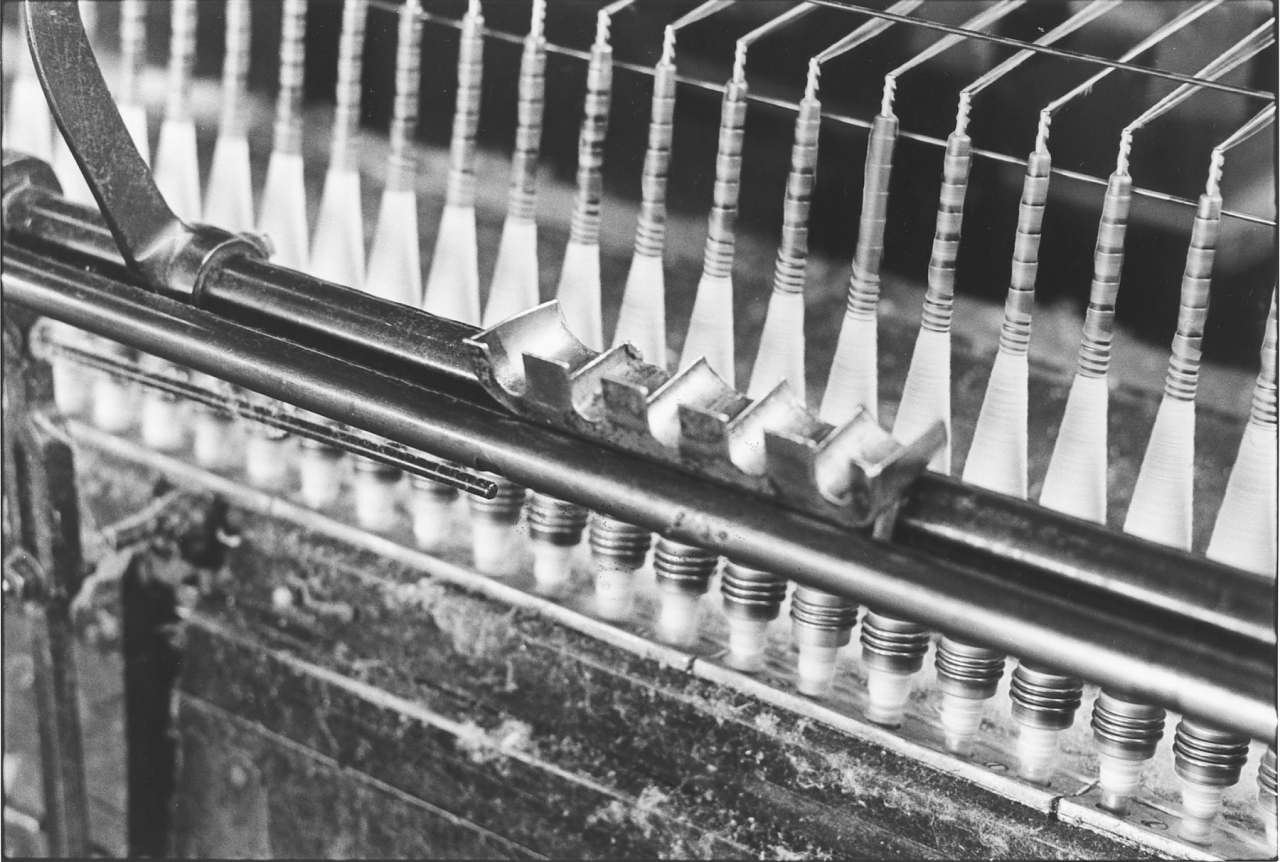
Oh that's ...
R - That's a photograph of what we call the presser, for pressing your pirns down.
Yes. Andy that’s a nice picture of what’s going on at the end of the spindle when it's actually putting the twist in, in't it?
R - That's right yes.
They are flying off the end of the spindle.
R - But this actually doesn't come off your spindle.
No. It doesn’t come off, it's just…
R- It's just going round on top of the spindle, to put the twist in.
Round and round, that's it yes.
R- But it doesn't actually draw it up off the tube, it just keeps going round on top of the spindle.
No, that's right.
R- And these are, ah, I have a paper here. I didn't know. And these are 63” stretch, what they call stretch. That's from your roller to when your mule comes up the back, it's a 63 inch stretch.
Yes. So, one draw ...
R - Now then, when you break an end down, I'll show you on number 79. If you break an end down there where your rollers are…

[79]
Aye, just in front of the rollers, yes.
R - In front of the roller, and let it run slack and let your mule run on to the back, then break the end down off your roller and lay it down and measure it, it measures 42 inches does that end with no twist in.
Yes, that bit of roving measures 42 inches, yes.
R – It’s 42 inches. Now then. In fact your mule, what they call your stretch from them rollers when your mule gets on the back, it's 63 inches stretch. So in fact that end is being stretched 21 inches.
Yes, that's it, aye. So it’s being stretched at the same time as it’s twisted.
R- Stretched and twisted 21 inches.
Yes. And the twisting would tend to shorten it anyway wouldn't it? So it's putting a lot of tension on that yarn, isn’t it?
R- It's putting a lot of tension on it, and it's stretching it 21 inches that end, because I measured it the other day. Because they take, they do that sometimes does the overlooker. He'll come in and he'll break the end down and let it run slack, and break it off again when your mule's got on the back and then he'll lay it down outside the mule and he’ll measure it, how many inches it measures. And then he can tell how much stretch your mule's doing; and if it is stretching too much then they can alter it then you see? They can alter the stretch of your mule. If it’s stretching too much, if it’s taking too much out of the yarn you see? And you wouldn't think as it would stretch 21 inches.
(550)(25 min)
No, you wouldn’t would you? No, the fibres must be like sliding over each other until the twist goes into it, mustn't they? And then of course that locks them up, the twist.
R – Yes. And when any students come in and we explain things to them we tell them about that and you know, it's surprising, they are surprised how much stretch there is on them ends.
Yes, because when you come to think, if you tried to stretch it 21 inches you’d break it.
R- You'd break it You'd think so yes.
You’d nearly think so. If you tried to stretch it 21 inches. Aye.
R- So it's just really stretching a lot there isn’t it.?
Aye, and that was one of the things I wanted to ask you about. Picture 83. Now I've seen you do that a lot, now you tell me what you are doing.
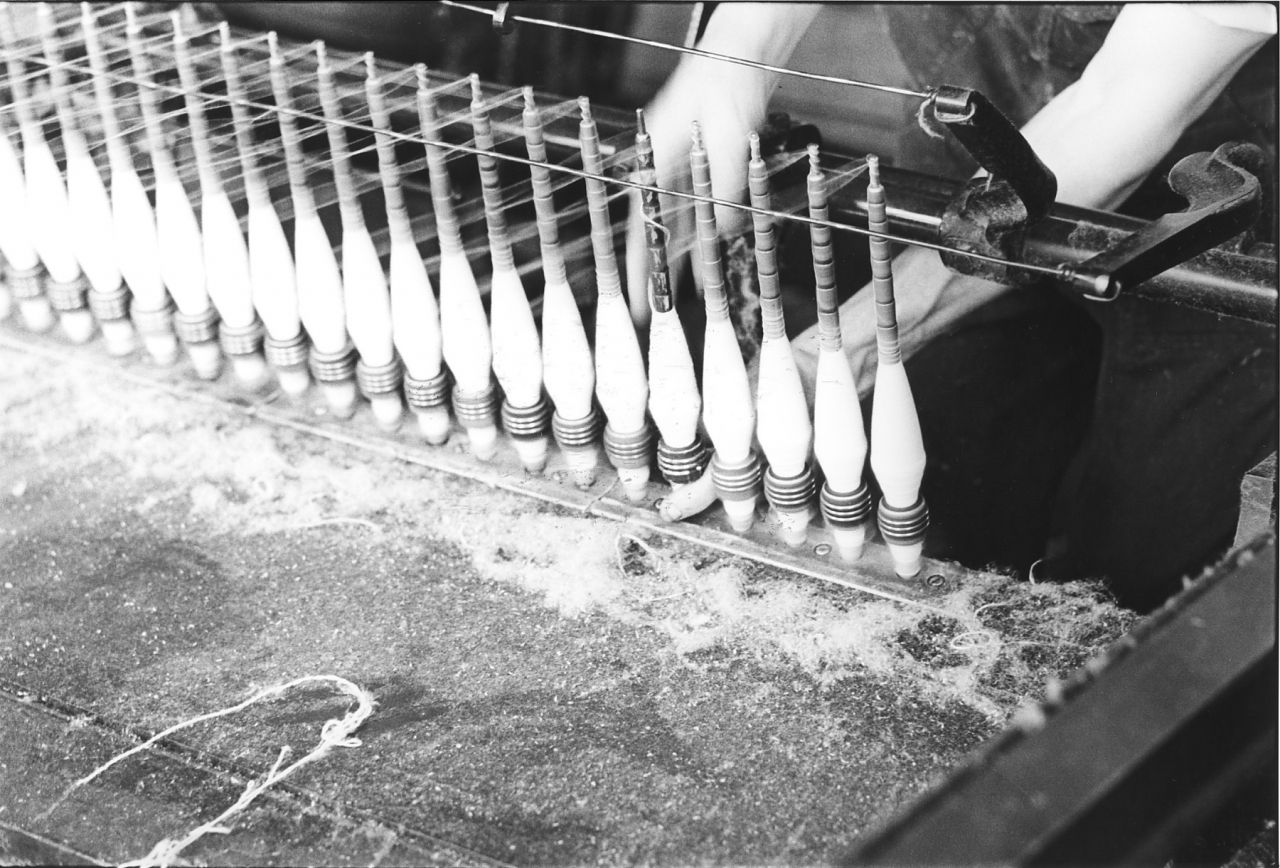
R- 83. Well, my end’s broke down on the cop. It didn't actually break down on the top of my spindle. So I've put my finger round the bottom for to stop that spindle so as I can get hold of that end and pull it up, work it up to the top of my spindle. See?
Aye I see. Because of course if it's going round and is putting twist in…
R- As it’s going round it’s putting twist in.
You couldn’t get hold of it.
R - You can’t get hold of it. And the only time you can get hold of that end if you don’t do that is when your mule's going to back off then your spindles go the other way around when it backs off. Then you just get hold of that end, and you just pull it up when it’s backing off.
Aye, that's it, aye.
R - Otherwise you stop it with your finger. But sometimes you have to be careful because it'll burn your fingers ‘cause it's going round at a terrific pace is them spindles you know?
While we are just on these two pictures, 82, you can see that stop rod can’t you?
R – That’s the stop rod for stopping your mule.
Yes, just under the two faller rods.
R- Under the two faller rods, yes.
Yes, the spindles that the faller rods are on, they the axles on them, there is a thin rod, and it just ends underneath the presser and that's the end of your stop rod isn’t it.
R - That's rights yes.
So this'll be down at the end of the mule; well, it would be because that's where you leave your presser yes?
R - That is, that's at the end of the mule, we leave it there after we have done, pressed down, on the other mule, we just walk across and put it on ready for starting on your other mule. So, that’s the wheel end now.
Yes. And again of course these are Northrop pirns, these are aluminium pirns.
R- They are aluminium, yes.
Yes, aye. Did you? Of course you did, you wound on to pirns straight from the mule for the weaver’s looms at Goodshawfold didn’t you?
R- Yes we did, yes.
Aye, but not Northrops?
R- Not Northrops, we didn't use them, we just used ordinary, what they call Welsh hat.
(600)
That’s it, Welsh hat, paper tube with a metal end.
R - On paper tube yes.
Yes. Now then, picture 84 forward.
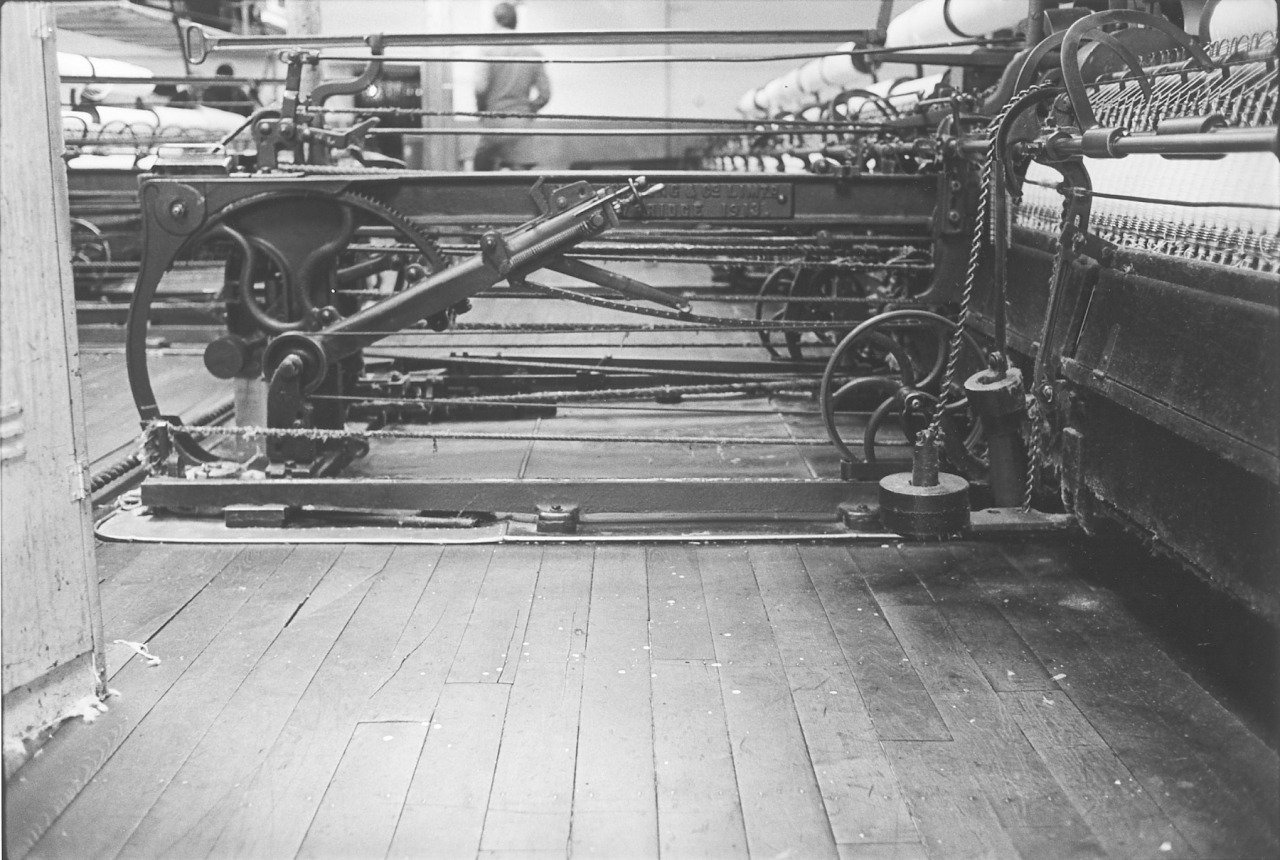
R - 84 is just a view of the mule room.
Yes, well, these are different views of the mule aren’t they?
R- Different, yes.
Now these weights here, there's some weights on the right hand-side of the picture, hanging down on chains. Are they to bring the fallers back? Faller wires?
R- Not those, no. They, the small ones is on your counterfaller. When it backs off it brings that counterfaller back with the weight. We've got to have them on because if you don’t, you only need to touch this counterfaller and it falls over. So you’ve got to have weights on to keep it up ...
Aye. Yes that's it aye.
R- Because if you just touch them they fall over. Now then, these big weights, you've got to have these on for your weight on your cop, it winds on tighter, the more weight you have on the tighter your cop goes. You see, whatever counts you are on, you alter these weights. If you are an fours you might have another bigger weight, you might have three on there instead of two. But also, if you have too much weight on and you are on a fine count, then your spinning goes all to cock, you have too much weight so you take a bit off and you just slur them under there on to the floor, out of your road. But more or less you have them two big ones on, you see there's two on there?
Yes, on 85. Yes.
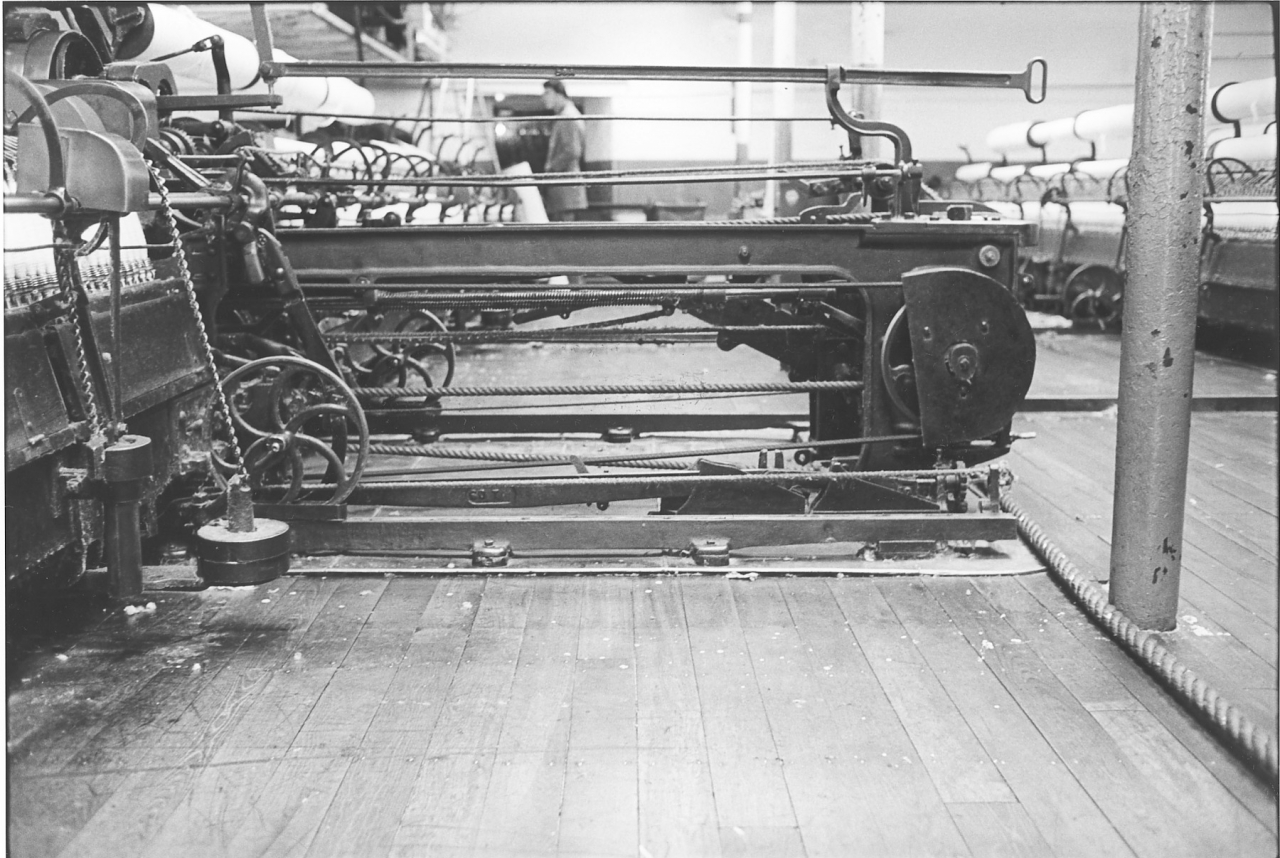
R- Yes. But on fours, on a thicker count, you have got to have three on so as you get a tighter cop, that’s what they are there for. And you've got to have the same weight all the way across. But if you are going to, it's got to be distributed evenly has them weights. But if you want a little bit extra weight putting on then you put one of these small ones in your middle one and leave your two end ones with these two big ones on.
This in the area where we can’t, and I realise that you can’t go into too much detail, because I mean, you'd just lose somebody, but what’s this we are looking at here on pictures 82 and 83. Is there a name for it or is it just part of the headstock?
(30 min)(650)
R - Well it's just the front part of your headstock.
Yes. And this lever here with the half gear?
R - This is what you call your quadrant this. That's your quadrant. And that controls your winding faller. And it also makes these cops right and all. Your quadrant, that’s what it is.
Yes. This piece of rope here that’s fastened at the end on the frames and going back, what’s that?
R – That’s your undercarriage band.
Undercarriage band yes.
R - Well that runs down the side of here, and it runs underneath your carriage right to your wheel end.
Yes. There is one for each side isn't there?
R- There’s actually two under there and they cross one another underneath. And one goes to here and one goes underneath to your wheel end.
Yes. And I should point out, it’s clearer in 85, that the thick rope that's on the floor there is nothing to do with the mules, it’s a piece of rope that was there. The rope splicers were in, and that piece of rope had a block and tackle on the other end of it. And it was fastened to the other pillar, further up, and they were stretching that rope before they spliced it. It’s when we were talking about stretching ropes before you splice them.
R- Yes.
Well that’s what they were doing. But they were doing it with a block and tackle on the floor; and you can see what good condition that floor's in there, can’t you? It’s a beautiful floor.
R – Yes it is.
It is. Absolutely beautiful. Which is the rim band on 85?
R- This with the cover on.
Aye, that wheel with the cover on. Yes.
R - This is the rim band with the cover on, and your band runs along there on the top and you see it again at the bottom ...
Yes, at the bottom.
R- And right through the headstock, right at the back.
Yes. And what's the thicker rope that you can see in the middle Jim, is that part of your rim band as well, that?
R- That’s not the rim band no.
Ah. You're right, you're right.
R – Eh! It’ll come to me in a minute.
You're right.
R - I didn't know, I forget, I can mention it every time and…
It’s right, it’ll come back to you.
R - It'll come, it'll come in a minute.
I’ll see it again in a minute or two, don't worry, it's all right.
R- Yes, that’s my check band.
Check band, that’s it.
R- Yes. Yes well, sometimes, when that comes loose, your check band, that checks your mule going in from your roller beam, from when it’s on the back, into your roller beam. If that check band is slack then your mule'll go in at a terrific pace and it'll hit your roller beam. It’ll bang. Yes, and then your mule'll come out and you'll get your ends all wound up the top of your spindle.
Aye, when it bounces back, right? Yes.
(700)
R - When it bounces back and it bangs, and then you've got to lift your fallers up to take it off the top. Because if you don't, when it backs off again it’ll break down.
Yes. Break them.
R- So you've got to have that pretty tight, so as your mule can be checked. That's what it means isn’t it? It checks your mule when it's going in you see.
Yes, check, that's it. It’s funny you saying that, because I noticed one of those sets of mules up in the top, when I was watching those running as the carriage went in, when it got to the roller beam it was sort of hitting it with a fair clout you know. Not too hard, but it was hitting it you know.
R - Yes. But that's because with this check band, if you have then too slack, they go in too hard, and they hit your roller beam too hard. And you can always tell when one of them's going to break because as you’re piecing up on the other mule, you can hear that. It’ll hit your roller beam and you know then that it’s come slack, it's breaking. And a lot of times they break at what's called ‘on the knot’ at the back where they are knotted, that's where they break mostly.
Yes. That’s the knot on to the frame at the back is it?
R- Yes, because it's a thick band is that.
It Is.
R- On 86, 86 is just a front view, that's the plate at the front. Now then this band…
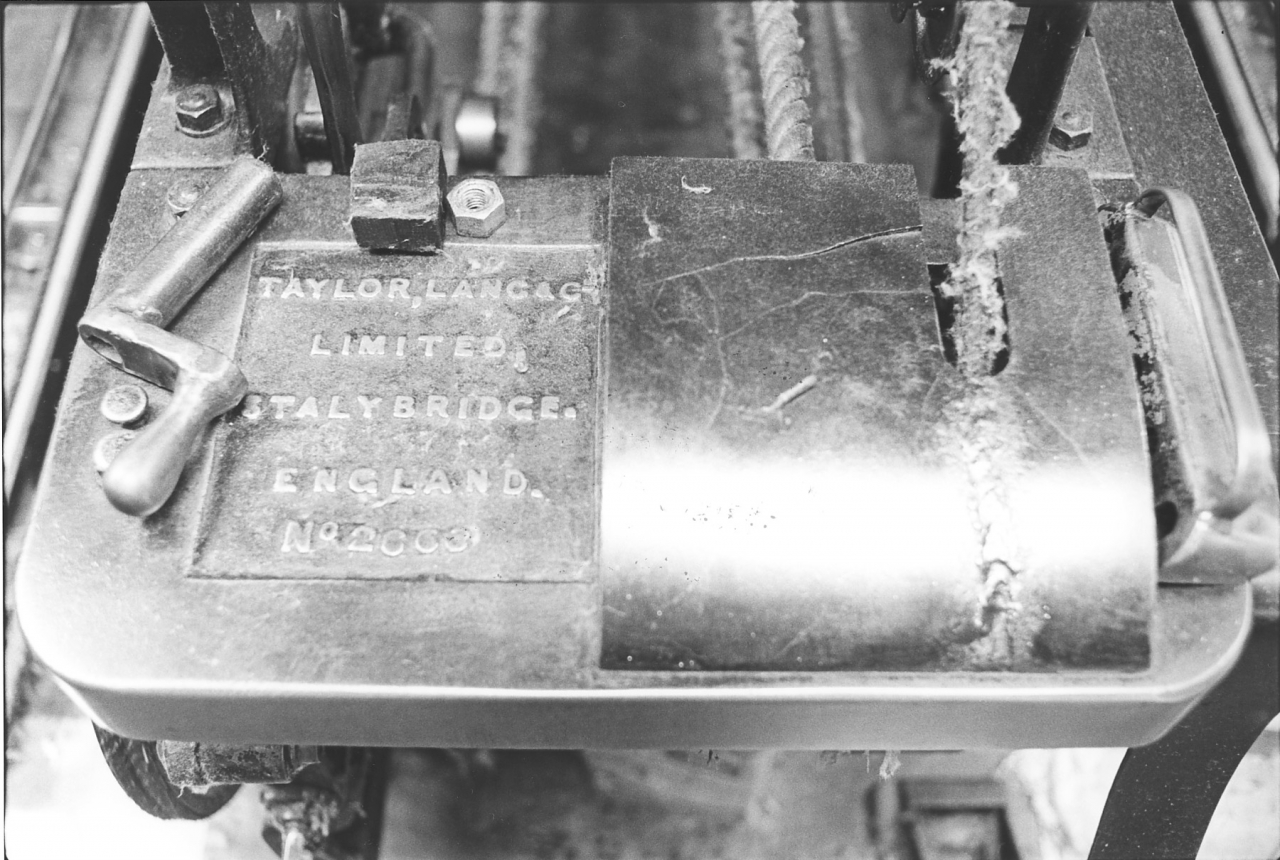
Yes, the one that's going through the…
R- This is what you call a steadying band. It just steadies your mule, that's all. That one, this band here just on your left hand-side of this small one, that's what you call your quadrant band. That controls your winding of your winding faller. If that's too slack, then your winding faller keeps going up and down and then it can put a nick in your cops you see? So that's got to be tight, that's your tightest band on your mule is that one. That's what you call your quadrant band then that has to be tight. If it isn’t then your fallers keep waving up and down when it’s going in and out. So that has to be tight. Yes, that’s the tightest band on your mule that. You can’t slacken that, it's got to be tight all the time.
(35 min)
R- That's the block what you put under when you're doffing.
That's just over ...
R- That's to take your fallers down.
Yes. Just over where it says Taylor Lang and Company there is a little block of wood.
R- That's right, yes.
Aye. And what's the little handle next to it?
R – That’s to wind what you call your builder back when you are starting to doff which I’ll show you later on in another photograph. It shows your builder in another photograph. And this is somebody’s presser what they have just put on the side there.
Oh it’s a presser isn’t it, aye.
R - You took them at the holidays, did you?
Yes that's it, aye.
R- Well, they'll have just put it there out of the road.
Yes, that’s it. And that's been cracked once or twice and all, that on top there hasn't it? It’s been welded.
R - That's been welded has that, yes.
(750)
Aye. Fairly polished up. Will that be with leaning on it?
R - I don't know, I think they get broke, like, with taking them off you know? If a band breaks, if a steadying band breaks then Arnold comes in sometimes and he'll happen take it off and he’ll just drop it on the floor. Well you see, they are only cast iron and they break. But now we've a lot of mules being broke up for scrap and what have you, the firm’s bought a lot of them you see so we've a lot of spares. So this must have been welded like a few years ago when they hadn’t a lot of spares you see?
Yes. Now then, picture 87. Now I don't expect you to describe everything on that picture Jim, it’s…
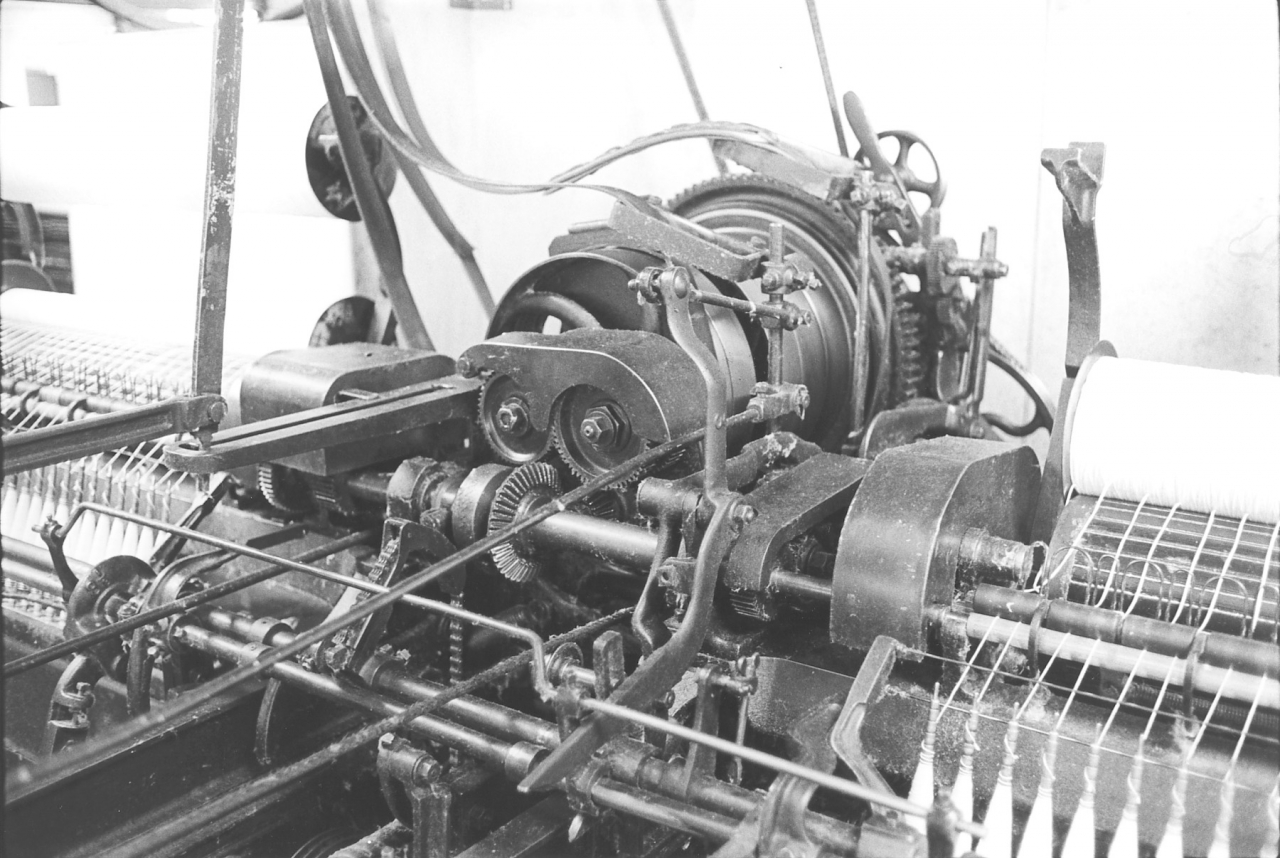
R- I can’t describe all that lot!
Well, you say what you can about it.
R- These straps what’s down, this is the twist strap and carriage strap what drives your mule.
Yes now those are the belts and this was during the holidays of course.
R- Which we take off you see.,
Yes. Why do you take them off during the holidays?
R – Well, so as they don’t stretch you see.
[I’m not too sure Jim was right here. They would have shrunk I would have thought rather than stretched.]
That's its aye.
R - They don’t stretch and then you have your same tension on your belt when you put them back on again as what you had when you stopped at the holidays. But if you leave them on you'll have too much stretch and then you, they pull out you see, they stretch out. And then you'll not get the same drive off them.
Yes. And of course a lot of the actions of your mules depends on the fact that your belt pulleys are being moved off one pulley on to another, off a loose pulley and on to a first speed and a second speed.
R- Well, you start on the middle, that's your loose pulley and then it comes over on to your first speed when it's coming out.
That's the nearest one to you isn’t it.
R- That's the nearest one to me here. The front ones are your carriage pulleys. But this, it starts on your middle pulley, your loose pulley, it comes along to your first speed when your mule's coming out. Then it's putting a bit of twist in there because your twist is moving round at the same time which is the lever here at the top.
Yes. At the right hand-side of the pulleys yes.
R- At the right hand-side of the pulleys. And then half way out, then this arm moves the twist right over, your twist belt right over on to the third speed, and then when it gets over there that's when it's putting all your twist in.
Yes. And that's when the mule takes come driving isn’t it.
R – That’s when it's driving at the top you know, it's a full, full drive.
Yes. I see that these belts here, belts at Whitaker’s, they seem to go in for lacing them with leather, don't they?
R - They lace them with leather yes.
Is that the best way?
R- Yes, I think it is, yes.
You certainly don't get that clicking when the belt fasteners are going round.
R – No. They had belt fasteners at Ilex, they don't use laces, but they always use laces at Whitaker’s and they always have done.
Aye.
R- And all these wheels at your front here.
Under that little guard? Yes.
R- Under that little guard, these here speed wheels. You can alter them for the speed of your mule, to make it go faster or make it go slower. The bigger the wheel you put on. I don't know, I think it's the slower it goes. And the smaller the wheel the faster it goes. And these wheels on here, they are a 56 speed wheel. You can go as low as 50 and as high as 58. But the least you get down to is 50 and then it's putting more twist in, it put more twist in your mule. But as you go up, and your mule's coming out a lot quicker then you take a bit more twist out of your ends you see.
Aye that's it.
R- But the overlooker balances it all up. You see with his twist wheels and his speed wheels, and he does all that you see. As soon, when he start wrapping his tensions on the ends he can alter all this you see?
So an overlooker has to start off as a spinner.
R- He starts off being a spinner does an overlooker. He's got to know all his headstock. And they used to go to night school once over did an overlooker for learning but they don’t seem to do it now.
Aye. I want to ask you about that later. I want to ask you a bit about that, about training. What's this rod that’s going over the top here, that looks to have the bend in it, the small rod that's…
R - That's your, the rod on an earlier picture, your starting and stopping rod what goes into your mule. It goes along your mule, but it comes up there you see.
Yes, on a bracket, that's it, yes.
R- On the top, on a bracket and on the top you see? And this chain here down at the front here, that's what you call your backing off chains. That alters your winding faller, when it's backing off it’s coming up.
Aye, that's it, yes
R – Yes. See the tighter you have that and it's not coming up as far. As you are about slack, then your fallers'll come higher up. And you've got to have that just a certain tension, now the overlooker comes and sees to that you see. Although you can alter it with a little ratchet thing on the front here, you can alter that, you can tighten it or slacken it but we don't touch it once the overlooker's set it. See, he gets you the right tension on it. It can pull your ends down see, if you have it too slack you can have your fallers coming too high. And it pulls your ends from under your rollers.
Aye.
R- You see and pull it right up and pull your ends. So it's got to be a certain tension has that. And this is what you call your steadying band.
Yes, steadying band coming in. Yes.
R - Goes on that little pulley and right under and it runs on to your back shaft which runs under these drums. And it goes to your clock, you know, the clock under these pulleys under here what works off your back shaft.
Yes well that's something, I want to get a picture of that, for I haven't one way or the other.
R- Yes, you haven't taken one of that have you?
Because that’s the same as the pick clock.
R Yes, just the same.
Very good
R - And this is your rod for setting on
Yes, it's hung down from the ceiling but it's ...
R- It’s hung down from the ceiling up here and it sets these belts going round, you see?
(850)
Yes.
R- Now then, under this cover here…
Which is?
R- These are what you call your pinions. Now then, the overlooker could come and alter them happen twice a week depending on your stuff, how bad your stuff is. If your stuff's going lighter or heavier then he takes a wrapping the same as I said, he takes these cops off and then he comes and he pulls this cover up and takes a pinion off here and puts another one on, and it’s putting more stuff through your rollers, it puts more stuff through your rollers off your bobbin you see?
Yes. Because the amount of roving that comes out through your rollers of course, is governed by how much those rollers turn.
R – That’s right, that's it.
Yes. But those rollers aren't like fine spinning rollers, they don’t actually put any draft in do they? They are not drafting rollers.
R - They do draft.
Do they draft?
R - Oh yes, oh yes they do draft.
Oh I didn't know that.
R- Yes, they do draft.
Aye.
R- And these also draft and all under this cover and all. Them belong to your drums for the bobbins.
Ah, to the drums at the back that the bobbins rest on yes.
R - These ran your drums on your bobbins you see? Them under there
So, if those are moving slower than them little rollers at the front…
R - Than these little rollers at the front.
It’s putting drafting between the bobbin and the rollers yes.
R- That’s where you are getting your draft from.
So are you getting draft like you do on fine spinning, between the two sets of small rollers?
R - It must be the same, just the same.
Aye. That's it aye. So really you are getting two lots of draft there. One between the small rollers and the bobbin.
R – Yes, the small rollers and the bobbin.
Governed by the speed that the big roller underneath moves.
R - That the big roller’s go on.
And then one lot between the front roller and the back roller.
R- Your steel roller and your back roller.
Aye, that’s it, aye. Oh I didn’t realise you got that. Because I mean, that’s really the same as Crompton's original mule, that's how his original mule worked. I must have a look at a fine spinning mule and see what the difference is you know. I know where there is one, there is one at Manchester, I must have a look and see what the difference is. Because I don't understand enough about the difference between fine spinning and the condenser spinning.
R- This rope, can you see this rope right at the back ...
Ah, right at the back, yes.
R- That's your drawing up band which is ran on to this pulley what you can see at the back, this pulley at the back.
Aye, a little pulley, yes.
R- That draws your mule in. If you haven’t got that on it’ll not draw your mule in, it draws your mule up does that and it goes to a pulley up at the top where your shafting is. And the thing is of course, what I've said, in your twist, this in your twist peg this on the front here.
Aye, that bar that’s going up the side.
R- That's going round all the time, that puts your twist in.
And that’s the one, if it misses stopping it, it'll put double twist in won't it?
(900)
R- That’s the one what, if it keeps going round it puts your double twist in.
Well done. And everybody has a good laugh, is that right?
R- Yes. Is it coming to the end of this one?
Well it is but you are all right Jim. You are all right because I don’t think there is much on these next three pictures. Ah, wait a minute, there is on those , yes now, picture 88. Now then, that's just a closer view of the headstock. And, really, it's the same thing that we have been describing before.
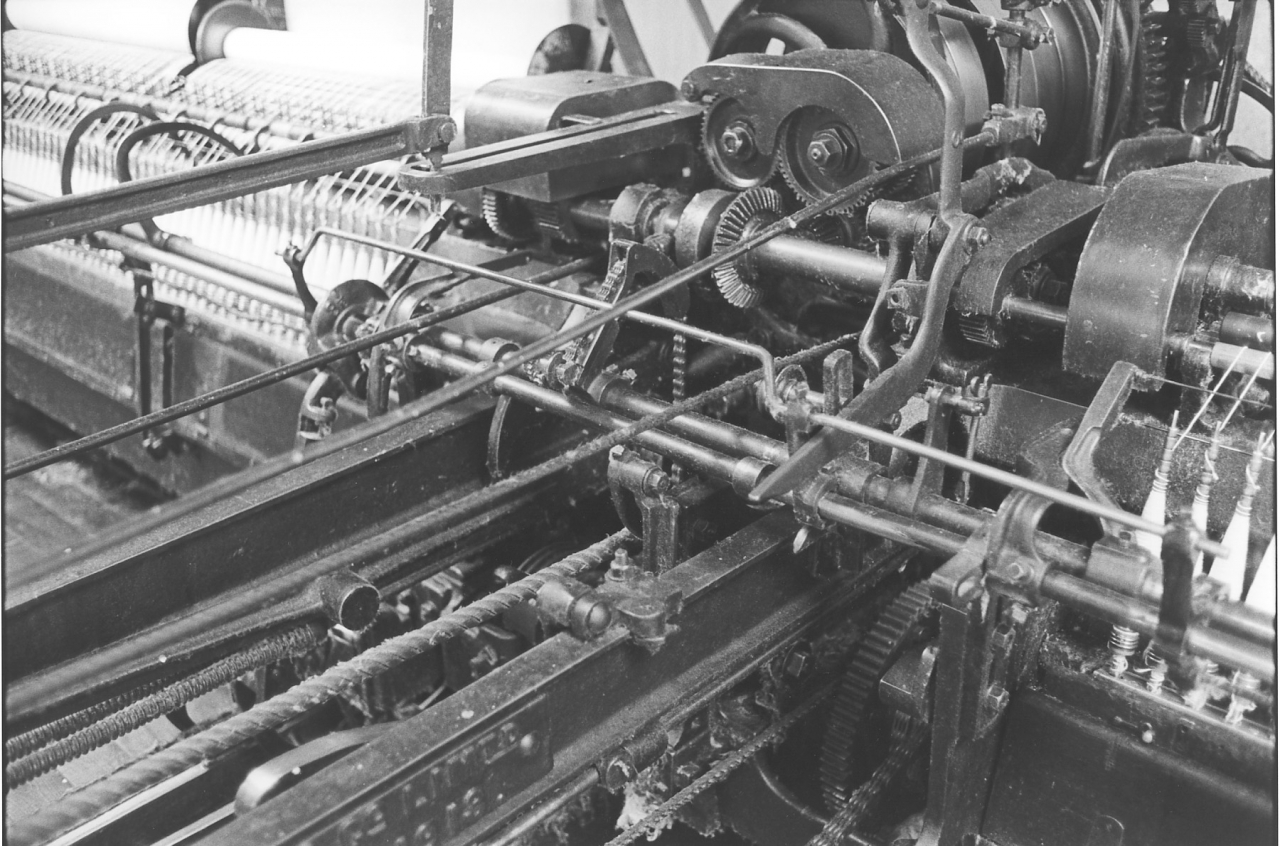
R- The same.
The chain's a bit clearer on that.
R- Yes the backing off chain yes.
Yes. The backing off chain.
R - Now then this thing here…
Now then wait a minute, let’s see if we can…
R - That's what you call your thumbscrew that.
Yes, now what we are looking at, if you look at the spindles on the right-hand corner of the picture you can see the spindles with the cotton winding on to them, with the twist winding on to them. And then just in front of them is the stop rod on a bracket. Now if you follow the stop rod on to the left, half way along the first straight piece of stop rod there is a little lever sticking up behind.
R – It’s got a wing nut on.
Yes, and it's got a wing nut on top of it and a rod going down. Now what's that again?
R - That controls your winding of your mule. When you start your mule up after you have doffed, that wing nut has to be at the top then your mule'll wind, this is your chain at, right at the bottom of your picture as you can see.
Yes, you can see the chain.
R - That winds right at the bottom of your set and that controls it. Now then, if you turn that wing nut down then it'll stop winding. So it’s got to be at the top when your mule's, when you've doffed your mule at the bottom. Now then, when your mule’s been running about half an hour your cops get built up and then that gives over winding, see? That's what it's there for, and that’s your winding peg that controls your winding on your mule. But if you set your mule on and you don't wind that wing nut up to the top it will wind then your fallers dip and break all your ends down.
So you've got to alter that wing nut as you’re going on.
R - That's to be altered all the time your mule's running till your cops get built up, until eventually it gives over winding.
I've seen you reaching there every now and again into the headstock when it was running.
R- Yes, you’ve got to watch that all the time.
Aye, when the carriage runs in?
R- Yes.
I've seen you reaching and just…
SCG/17 July 2003
9,140 words.
LANCASHIRE TEXTILE PROJECT
TAPE 79/SD/09
THIS TAPE HAS BEEN RECORDED ON AUGUST 21st 1979 AT 26 HARGREAVES DRIVE, RAWTENSTALL. THE INFORMANT IS JIM RILEY, MULE SPINNER AT SPRING VALE MILL. THE INTERVIEWER IS STANLEY GRAHAM.
We are carrying on with the description of the pictures in the Spinning Folios and we are still talking about picture number 88.

Now, two big cast iron beams with Taylor Lang’s name on again. Now funnily enough that one says, does it say 1919?
R- 1919 yes.
Yes and the plate on the end of the mule is 19 hundred and , ah, that’s upstairs on the top floor.
R - That's the top floor.
Top floor, yes of course it is.
R- Them on my mules is 1901.
Yes they are.
R- And one's 1903, so this in the top room.
That’s it. It's the top floors. Aye they must be younger mules, they must be younger than the mules up there.
R- Yes.
Aye. Now, that nearly took us astray then. Whereabouts is that shaft, do you know, that shaft that's hung up at the back with, stretching those ropes. It's got a scroll wheel on the end of it. You know, at the back of your mule, next to the windows there under
(50)
the motors, under the shafting. There's a shaft hung up there on some band for stretching it. Now what’s that shaft? You told me what that shaft…
R- That's a scroll shaft is that.
Whereabouts is that in the headstock?
R- Well that's at the back of your headstock, you can't see it from here.
Its at the back, you can’t see it.
R- You haven’t got a back view of the mule, but it runs all them bands you see. All your bands run on to that scroll at the back. There’s three scroll bands and a quadrant band and your rim band of course. But them scroll bands, them go from your front right to your back on to that scroll shaft, and that controls your mule as well. It controls your speed if you, well, it drawn it up evenly, your mule.
Yes. I mean, I have no doubt that anybody looking at this will realise what we've said all along, what a complicated thing a mule headstock is.
R - Oh, it is very complicated, yes.
I mean, I have heard it said that every engineering motion known to man is in the headstock: of a mule and I can believe it, looking at it because there’s, well I don't know I can't thing of anything that isn't in here except hydraulics. There are no hydraulics in there, but apart from that, hydraulics and electricity excluded, I think everything is in there.
(100)
R - Yes. Now then, this wheel here, what you can see here with teeth on.
Aye, just below the girder with the nameplate on, yes.
R- Just below the fallers, yes. That, as the shaft goes through there, and it goes through inside your carriage. And that sends your tin rollers round inside where your bands go on.
Aye, which drives the spindles.
R- Which drives your spindles, and it goes right through the headstock right to the other ends right through. And that’s all on that shaft is that.
Yes that's a long shaft that isn’t it. It goes right the way right the way through the mule.
R - That's a long shaft yes.
Yes well there is one place where we have got the door open at the front of the carriage, and we can see the spindle bands. Aye that's just looking…
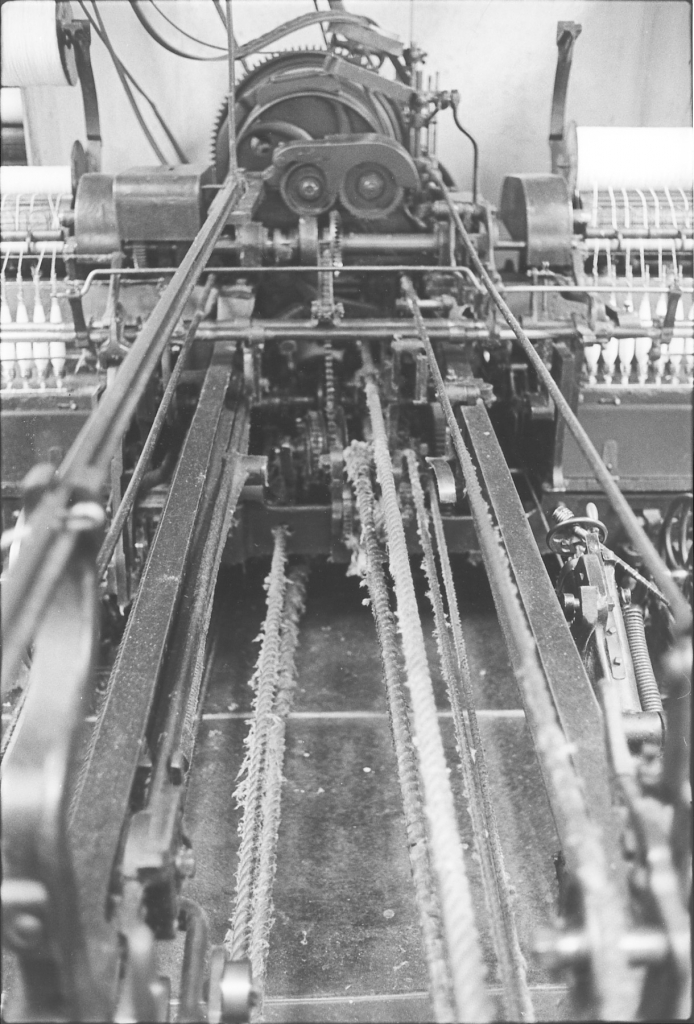
[89]
R - Well 89 it's looking down the ropes. See this rope on your left is the check band.
The left one's the check band? Yes.
R - The check band. It goes right underneath. Now then, this band here goes right under the mule and it goes on to that what I've just said, your quadrant at the back. It goes right under the headstock.
When you say quadrant do you mean scroll? ... There is a quadrant on it.
R - That's my check band. And that's my quadrant, this big one at the top.
(150)(5 min)
Ah, the big one at the top, yes, your quadrant.
R- That’s your quadrant, and that's the same. It goes from there and round a pulley under here on the headstock and back round.
Yes it’s actually the same band.
R - It's the same band that goes round.
Yes. And the small one, this…
R – That’s what that is ...
That one there? Is that a rod?
R – No, that's a band. That's what you call a weight band.
Yes.
R - Now then, when it comes from there it goes on to a weight at the front of your headstock and you put a weight on. Now then the more weight you put on that band, the tighter them cops go, it'll tighten your cops up will that. There’s different ways to tighten your cops up but you can tighten it up with that, that's your weight bands and it's got a weight on. I don’t know whether you have got us a view of a mule showing the fronts or not, I'd be able to show you from the front ...
No there isn't.
R- Is there not? No
No there isn't. Aye again you see, that shows there are some more pictures to do.
R- No, there isn't one there, and I thought you might have had one you know? No.
No. I’ve slipped up again Jim.
R – But it’s over here, it's over this front here, in front of the headstock you see?
Yes. In the front of the headstock. Anyway.
R- You see it’s at the other side of this wheel here, at the other side of your rim band. Well actually ...
Now we are looking at picture 92 now.
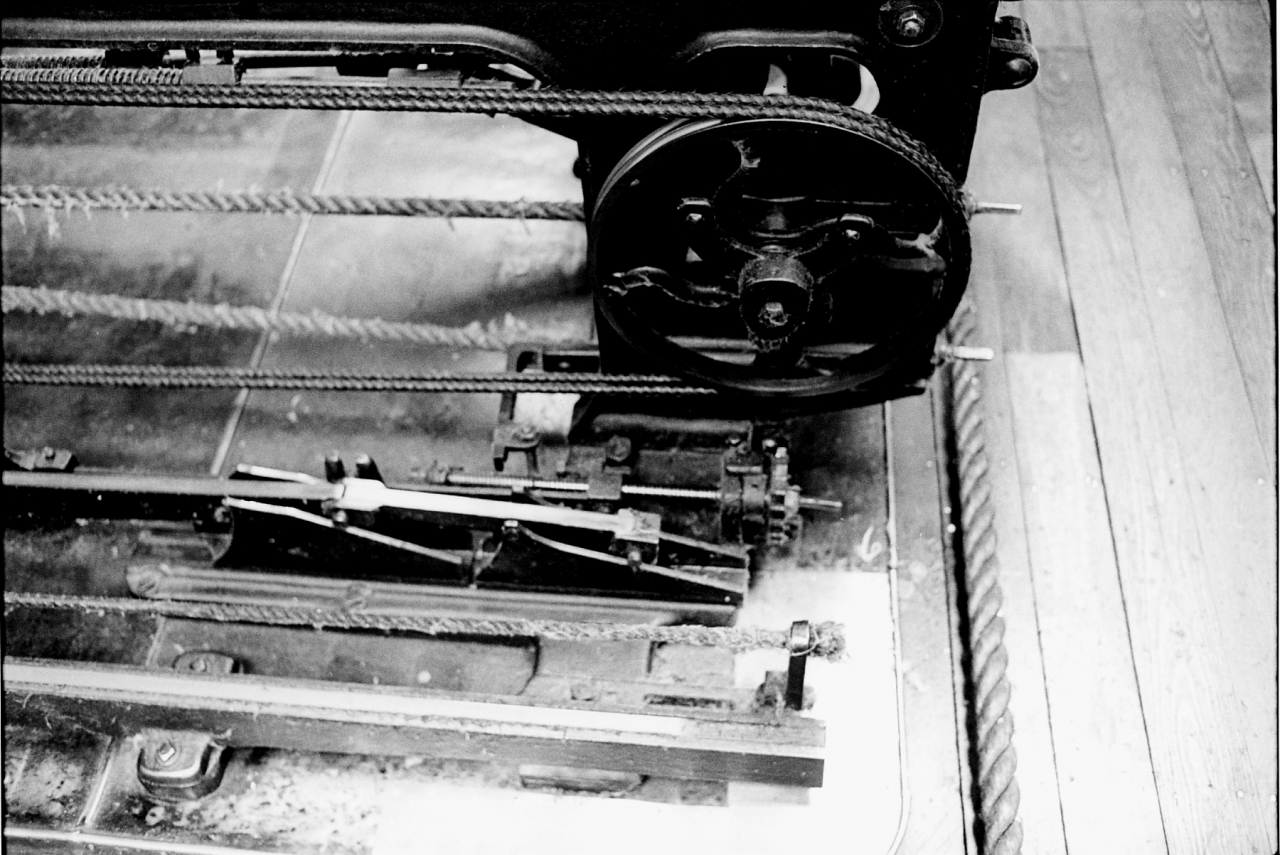
R- On picture 92 it's there, looking through that hole.
Yes if you look over the top of the wheel that’s holding your rim band.
R- Rim band.
(200)
The double rope, there, you can just see the rounded edge of the weight through the gap in the carriage.
R - The rounded edge and it's a weight is that yes. And it's fastened on to a rope which runs through.
Yes, that’s it.
R- And that's the one there. Now then, this top one here, that’s what, of course, that's your steadying band.
That's what, that's the one that…
R- That runs on to your back shaft.
Yes, that's the one that's right next to the right-hand cast iron bearers. Yes.
R - Right next to the cast iron rod there. This rod goes to your carriage, that controls your carriage fork from the front here. Because it moves does that when you set your mule on with this rod. You set it on and that fork moves over, this rod moves forward, and moves that fork over on to your drive pulley.
Yes, So that alters…
R - On to your drive pulleys.
What’s it on? On to the loose pulley?
R - It's on the loose pulley when it's at the front, then it moves it over and it starts driving. Drives on to your drive pulley.
That’s it. I don’t think anybody will argue against the fact that it’s a complicated piece of machinery.
R - It is.
Complicated piece of machinery. Now then, 92 is just down on the floor next to the, at the front of the headstock.

R – It’s underneath your rim band. That's your rim band what's running across there.
Yes, that’s it aye. Now what's this ratchet on the end?
R - That is what you call your builder, that builds your cops.
Aye.
R- And that's going all the time is them teeth. That builder, I don't know, it must be in the top room but ours has 23 teeth, it's a 23 teeth builder. Now then that just keeps building your cops, it's going all the time. Now then this rail here is what you call your copping rail.
Aye, the rail that's going over.
R - That's going…
Yes, well it's in both 90 and 91 yes.
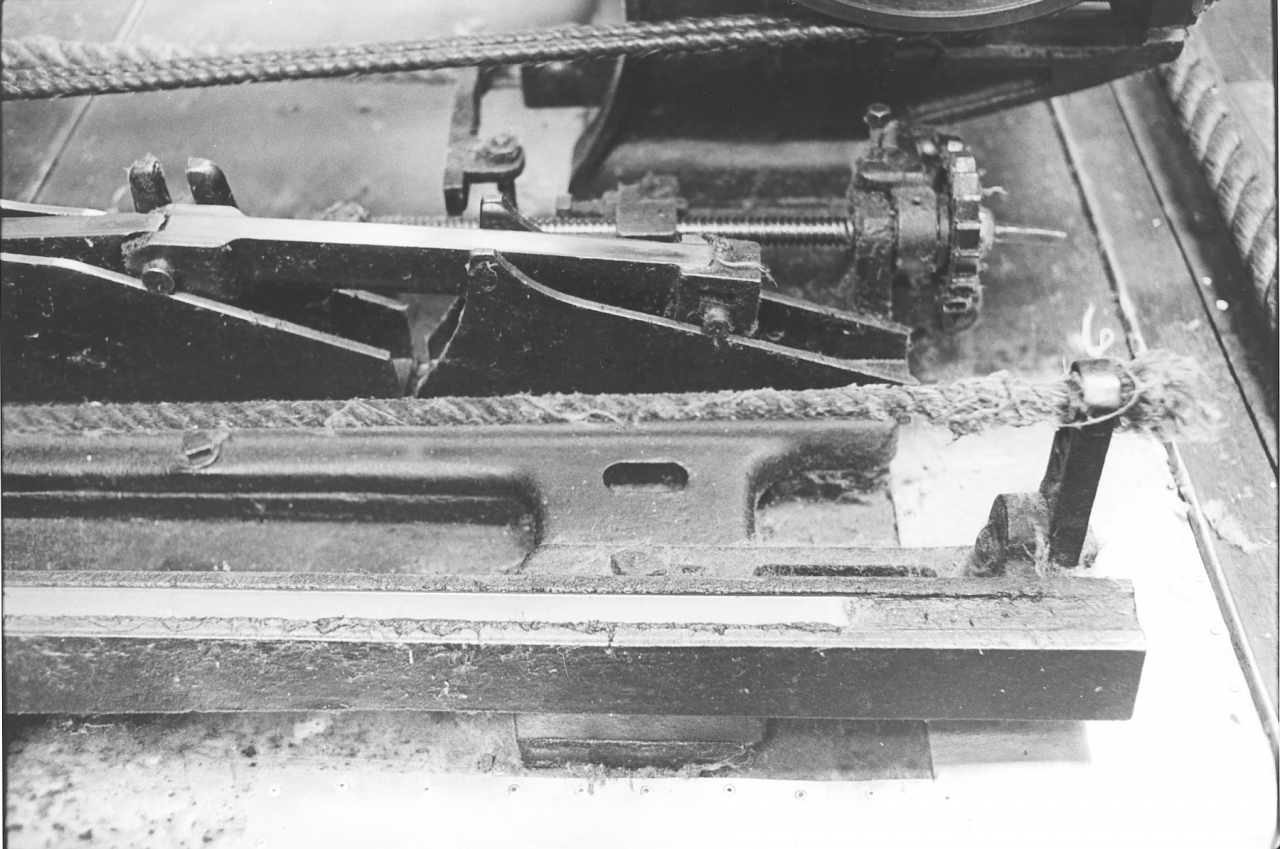
[90]

[91]
R- Yes well, all this is combined. It's a copping rail on two copping plates. Now then, that alters your cops as well does that.
Aye. So the shape of those plates, the slope on them and how they are set…
R - The slope on them and how they are set, that shapes your cop does that.
Yes. Aye.
R- But once they've been set then they are right. But this builder at the front, if your cops start going thin, then you take your builder off and put another one with an extra tooth on. If there’s a 22 on you put a 23 on and it fattens your cops up.
Yes because it takes it longer for it to wind up, and it takes it longer to go up so it is thicker.
R - But this actually shapes your cop.
Yes, it puts the shaping into it.
R - It's the shape of your cop, yes.
Aye that's it, aye. Because of course your cop starts off with a taper, it tapers down to the bottom and tapers up to the top as well.
R- It tapers, as well yes. And that's all done by these copping plates and your copping rail.
Aye, that's it.
R- And inside here, this round thing here, and your round one there, they are what they call dyes. And you can alter them, you can take then out, and they are only a little square block with a little screw on, and you can wind them up or down, you see? On both of them. And you can shape your cop with it.
It’s no wonder they have to go to night school Jim.
R - Well it's, there is a lot to learn in a headstock, a lot to learn.
There is that, there is that. And of course the shiny patch on this casting at the front under the, now, wait a minute, that band there is the…
(10 min)(300)
R – That’s your undercarriage band.
Your undercarriage band, that’s the lowest of the ropes, the top ones the rim band in the picture 88.
R - Rim band, yes.
And the lower rope that we’re looking at is the carriage band.
R – Carriage, undercarriage band.
Yes well, if you look at the bottom of the picture, this piece of cast iron. That's where the wheel's running, isn't it.
R- That's where your carriage wheel runs on there yes.
Where it’s polished. Yes.
R - And it’s just flat, it hasn’t got a groove hasn’t that wheel, it's just a flat wheel, see, what runs on there.
Yes.
R - And this is your same picture isn't it?
Yes, picture 91 is the same picture but a close up of the copping blocks and the ...
R- 91 is a close up of the copping rail.
Copping rail rather yes. And the rail ...
R - .. and the rail at the front where your carriage wheel runs.
…at the front that your carriage is running on, carriage wheel's running on. I've heard you talk about a thing called the boot leg, have we come across that yet?
R- No we haven't got it, see you haven't got it I don't think.
Oh dear, well there you are you see, we shall have to… Anyway, keep going…
R- Yes, you have got it later on.
Oh good! We'll come to it then. What’s this one, picture 90?
R - So we are on to 92 now.

Ah, two pages lads, you're right, you're right, 92 yes. Now that's an overall view of everything we have been looking at. Once again I’ll just point out that that rope, the thick rope on the right hand-side that's running down the boards is a driving rope that’s being stretched. It's nothing to do with the mule itself.
R- Nothing to do with it.
It was a driving rope for one of the motors. And well you can see that ratchet, that builder there quite well and the threaded rod. And if you want to, can you alter that yourself?
R - I can take that off and put another builder on yes.
(350)
Yes, that's it, aye. And at the back there looked to be two rods coming out with nuts on them, are those for tightening the check rope up in the …
R - This bottom one, that tightens your check band up which is that thick one at the bottom there. When your mule starts running hard and banging, then you just wind that up a few teeth, just to tighten it up. And the top one is your rim band.
Aye. That tightens your rim band up.
R- That one tightens your rim band and pulls it back. Yes.
Yes, it pulls that pulley wheel back and just tightens it up.
R- Yes. But when you're running, when you start off in the morning, before you go home at night, you slacken that off, take the tension out of it, every night.
Aye, let it take up during the night, let it get elastic during the night yes.
R- Let it take up during the night, yes. And in the morning, then you just take it up a little bit you see? And as, as your mule get warned up later on, after about half an hour just wind it back a few teeth just to take the tension off it again and it'll last a lot longer will your rim band.
Aye, that's it aye.
R - And they always tell you, an old overlooker I used to talk to, he used to say never have a tight rim band because it’s as good as putting a tooth in your, on your twist when you have that too tight and it's driving.
Yes, when you say putting a tooth on your twist, on your twist wheel, on your gear wheel, yes, that’s it.
R - On your twist wheel, on your gear wheel yes. So if you have it too tight it's driving you see so you slacken it off a bit so there’s not a right lot of tension on it. So every night when we go home we just slacken that off, you see. There is a lot of things you've to do, you know?
Christ Almighty there is!
R - But you do it automatically, over the years you know, you just do it.
Well yes.
(400)
R- And people say well how do you find time to do this and that? You know, you just automatically do it. Now 93 ... Now then this is your right hand side of your carriage wheel this is your boot leg.
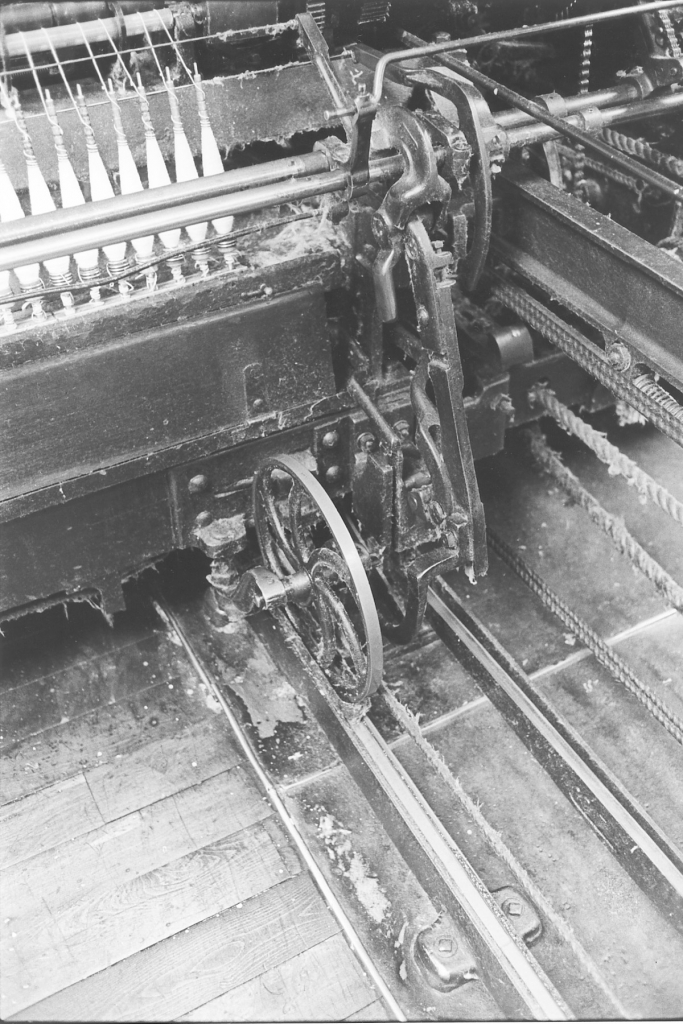
Ah, that rod that's coming down from underneath the stop rod, the bend in the stop rod?
R- From the bend in the stop rod. It's all one is that, that's all your boot leg. And this at the bottom of your boot leg, that's what you call your sickle, that's a sickle. That changes your fallers does that sickle. It's got a little stop thing inside there and it goes on to there.
Now is that what Tommy was on with while you were getting ready that day to doff? Was Tommy on with that boot leg?
R- Well yes, when you get ready for doffing you wind your builder back at the front, here. You hook your fallers down and you pull that boot leg up and put a little block underneath it so at it takes your counterfaller down to your spindle rail.
Aye, that's it aye.
R- So that’s what your block's there for, that's what your boot leg’s there for.
Yes, that block we were looking at on the front of the headstock yes.
(15 min)(450)
R- On the headstock, that goes underneath this boot leg here you see? This square here, it's all boot leg is that. And it's a block, a big square block; and it runs on to this rail.
The rail that’s running along the floor underneath. Yes.
R- What's running along, that’s your copping rail is that rail.
Aye, and that's the rail that's altered by those blocks that we saw, isn’t it, the position is altered by those blocks.
R – Yes. And them, there's a screw here, right at the, well just nearly at the top and that little one at the top and all there. That alters your cop, your height of your cop. If you slacken that nut off there, either drop it or knock it up a bit it takes the bottom of your cop farther up your spindle.
Yes, that's it, like where it starts to wind, yes.
R- Where it starts to wind. You can take it up or drop it farther down. Now then the other pair, they are running sale weft just at the present and they are on Welsh hat. Now then they have been altering that today you see because them Welsh hats probably go farther up the spindle. So therefore you've to alter this boot leg to get it up to starting at the bottom you see. That's what your boot leg does is that.
Aye. And I notice all underneath that carriage there’s a piece of tin plate isn’t it. Is that to catch the oil drips?
R- This was all tin yes. Yes, it catches hold of your oil and what have you and then it gets cleaned up of course when we clean and they're right shiny is them tins.
Aye they will be with being oiled up all them years yes.
R- They are very shiny yes. Now then, what are we on to, 94.
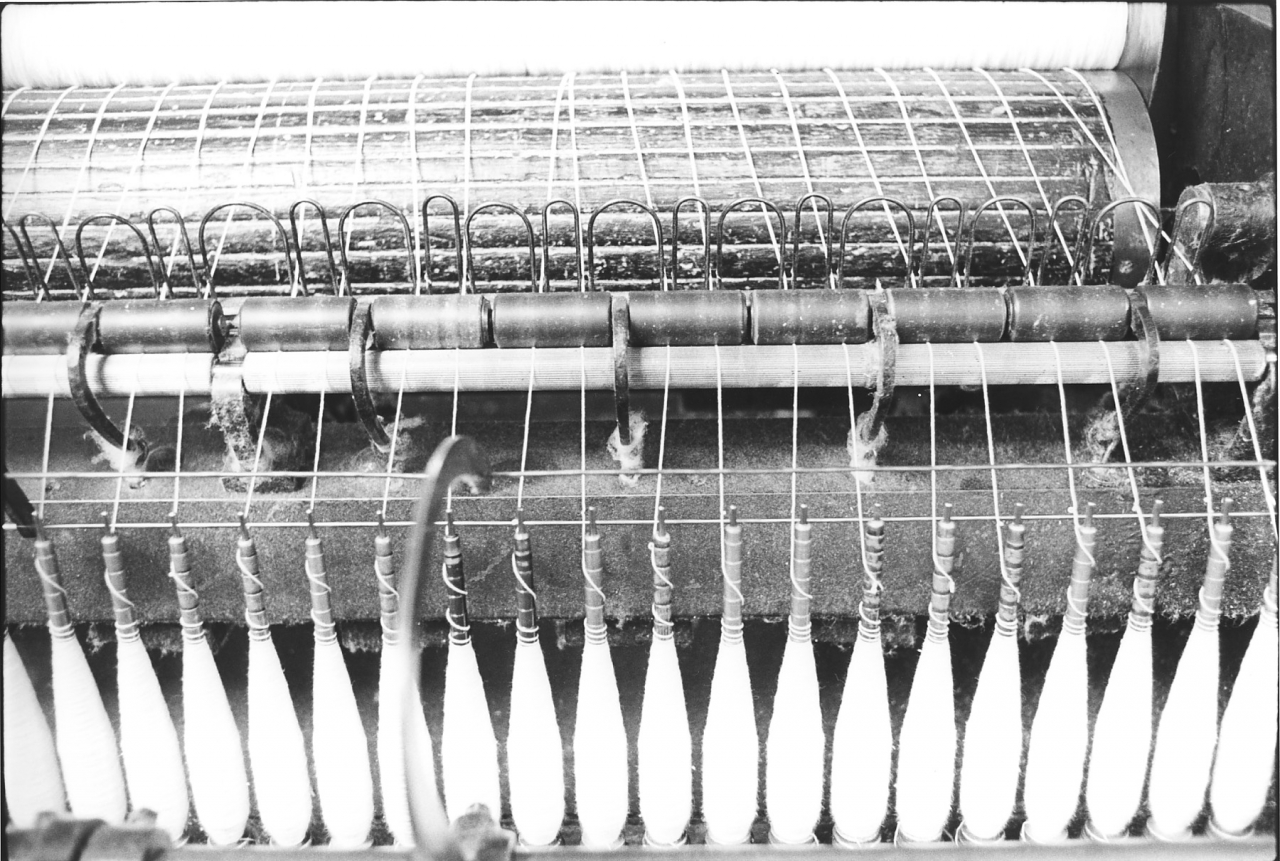
Aye picture 94.
R - It's just a front view of your spindles with the cops on.
That's it aye. And those are, that’s it. And the rollers, and the guide wires, and it just shows where the roving's going in.
R – Yes, But I’ve told you at one time about them rollers, why they are leather.
They are leather. Now tell me again, now we are talking about the darker rollers which are on top of the metal rollers, yes?
R - Which are on top. Yes, on them small ones. Now them are leather and underneath the leather there’s, they've put some stuff underneath to absorb oil, it's a covering underneath. And, they once tried, when I worked at Oak Mill at Dunnockshaw they once tried some plastic rollers. Well, with plastic, if they get oil on or they get damp it stays on top of your roller with being plastic, it doesn't soak in, it doesn't absorb it. That's why they always have leather rollers, they are easy to clean. They get very dirty does the other rollers, plastic ones.
Yes, those are the ones that the rubber's running across, that clearer's running across.
R - That clearer runs across them to clean them up.
Aye, it runs across.
R- But if you get oil on them, leather rollers, it soaks in, it’s absorbed you see?
Yes. Of course that was taken during the holidays when all them mules were stopped. And 95 is the same picture really, but a bit lower down. It shows the door open in the front.
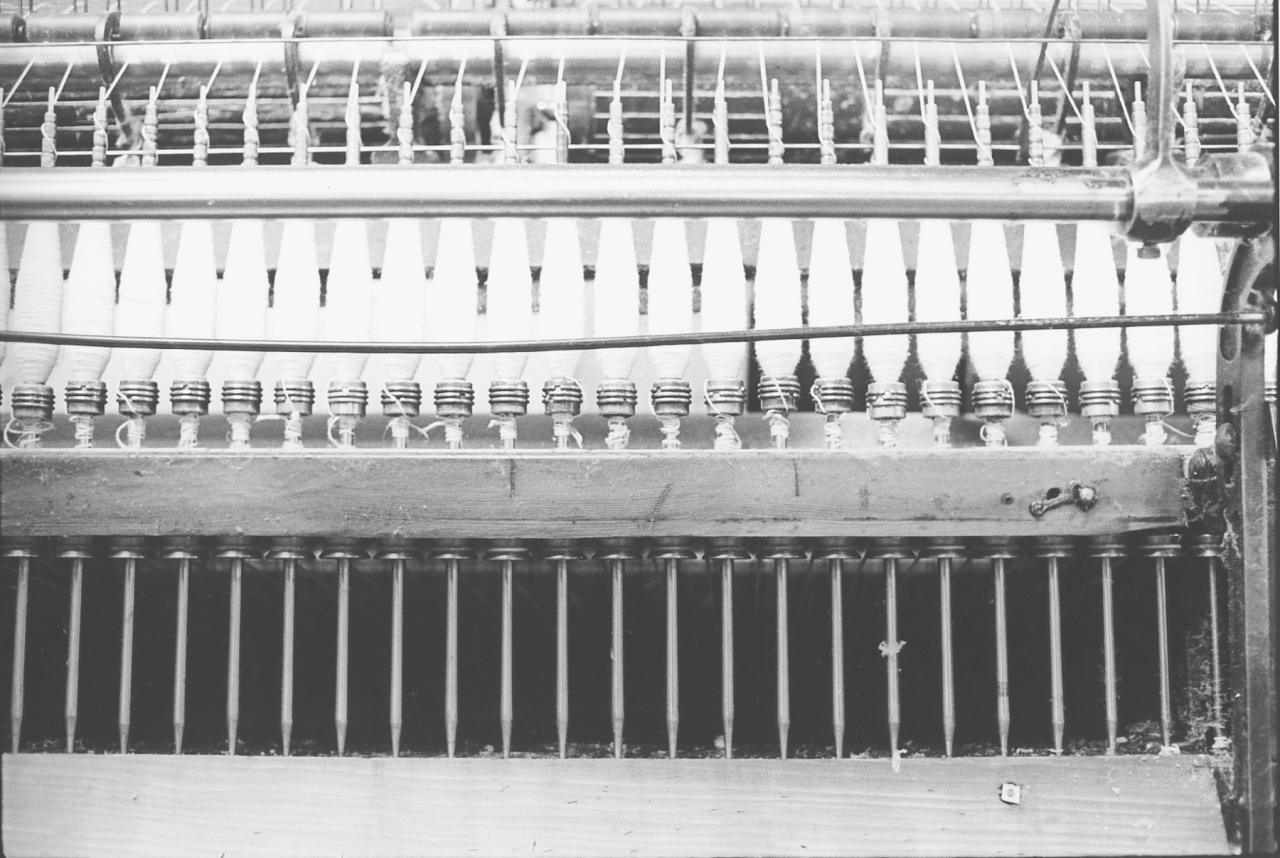
R- That's the spindle board, that's the spindle board at the front.
Yes that's it aye. Now your tin roller's inside there, at the back isn't it?
R- The tin roller is in the back there what your bands go on to that go on to them spindles.
Yes you can see the pulleys at the top, you know, at the top you can just see the pulleys.
R- Yes you can see some pulleys and just the band going through on to your tin roller.
And, at the bottom where that point looks to be going into that wood there is a brass bearing isn't there?
R- It’s a little brass bearing, you oil them, you put oil in them.
Yes. How often?
R- Twice a week, Monday morning and Wednesday morning. Some don’t oil them some oil them only once a week, some oil them once a fortnight. But if you don't you'll get them squeaking. And at the top of your spindle rail, this narrow board under here, then under there you have little bearings, brass bearings. That's where your spindle goes into, that’s full length of your spindle there. Now then we oil them once a week.
Aye. And that wood's just about soaked in oil isn’t it.
R- Just absolutely soaked in oil and your carriage inside gets soaked. And when you scour, the oil all inside there has to be cleaned out with rags. It's to soak all your oil up and clean them all out. And you do all theme spindles on their own, individually, clean them all off and wipe all down inside with a rag. That's what you have to do when you're scouring.
Do you take the spindles out when you scour? No?
(550)
R – No, you take your top board off, and then your spindle’s will lift up. Then all as you do is put a piece of rag in underneath with your fingers and dry it.
Aye.
R- I think it's coming to the end here, Stanley.
Aye, we are coming to the end. Aye well now this is the end. I mean that is in fact a picture in the bale warehouse downstairs. 96
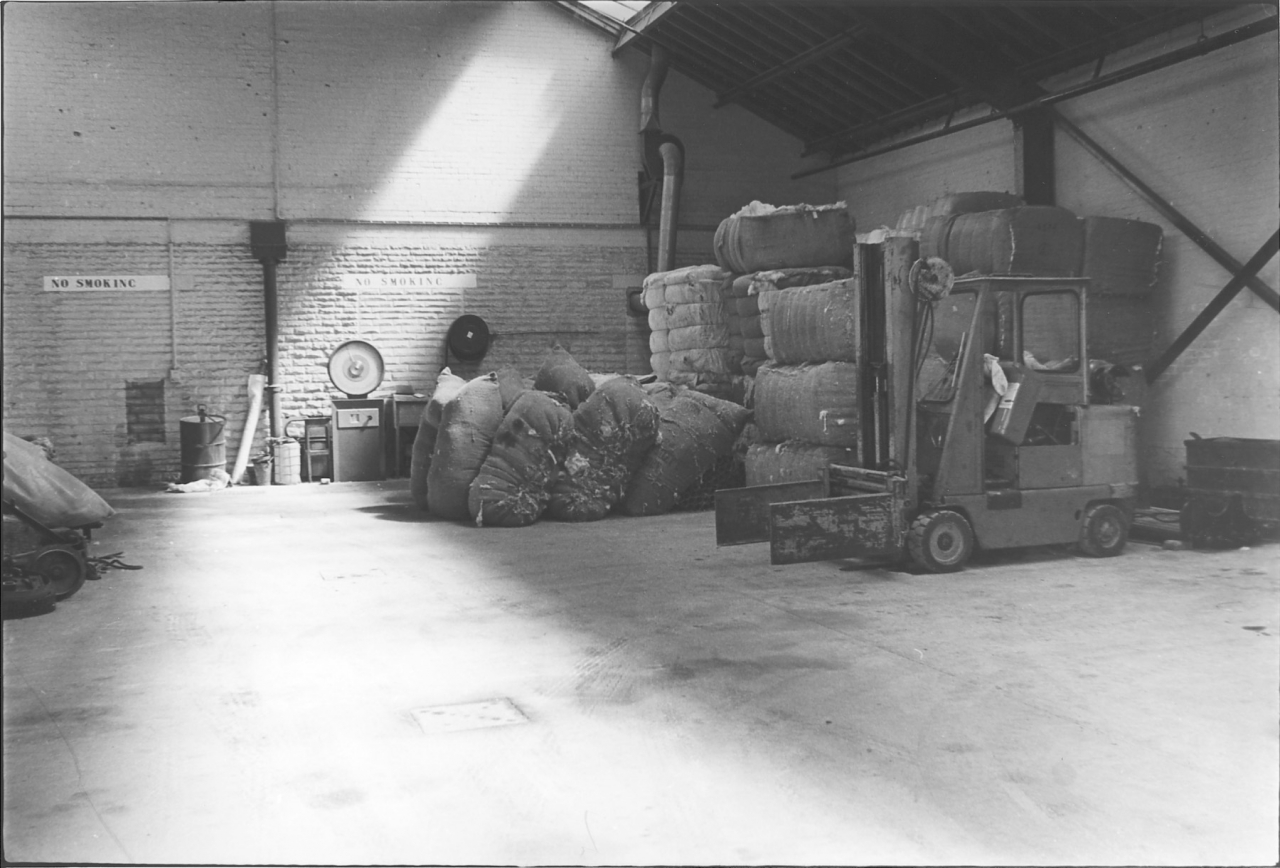
R - In the bale warehouse.
A very uninteresting picture after the mules I might say, because…
R – Yes, that's where the bales come in, what's coming from your press.
That's it, they take them in there, don't they?
R - They come in there, you see, for, when we're sending them out, you see?
Before they're sending them out. That’s what the fork lift truck’s there for, lifting them on the wagons. I don't know Jim, it’s very uninteresting after the mules is that.
R - It is, it certainly is.
Right. Well that's all the pictures. That's gone through the pictures then so we’ll finish the rest of this tape off just clearing any loose ends up there are. Now, one thing that we started talking about before but we never really got round to it, was the fact that I think that nearly all textile workers have always been underpaid. I know that most workers think that they are underpaid but textile workers, especially in recent years, have always been well below the national average for working people. And I know that your wage is still the same. Now you were telling me how much you were getting when you were at Grane Road in 1968.
R – No, when I worked at Oak Mill at Dunnockshaw in 1968.
At Dunnockshaw, that's it aye. Yes.
R- Which was £18 a week.
£18 a week. I’m trying to remember, 1968, I'm trying to think where I was. 1968 I was working for ... 1968, that's 10 - 11 years ago. Yes well, 1968 I was just coming away from the dairy, and I was on £17 or else £18 a week. And I know there were quite a lot of people in engineering and such that were on a lot more than me, £17 or £18 a week and you were on?
R - I were on £18.
£18 a week then. Yes, and what’s your normal wage now. I know you can’t really say a flat wage with mule spinning now.
R – No, it isn’t a flat wage.
1979, you know with all your bonuses and everything else on top, what sort of a wage can you make in 40 hours?
R - £62.
£62 that's gross?
R - That's gross, before they take anything out, yes.
Yes. Well now, when you come to consider that at the moment we have engineers out on strike for an £80 pound flat wage, which is before overtime and everything else is added on, overtime and bonus and everything else is added on. It’s not a good wage that.
R – It’s a poor wage for the job as we are doing.
Yes. And another thing to consider is the amount of skill and the amount of experience that goes into it. And I think that, I really do think that when you take those factors into consideration, you're underpaid.
R - We certainly are underpaid.
Yes it’s a bad wage.
R- It is a bad wage.
But there again, I can remember asking you one question, in all the time you've worked in textile mills, have you ever known the weavers take industrial action and finish it, ah well, weavers and any textile workers take industrial action and finish up better off than when they came out?
R – No. I don't think we have ever been on strike, spinners.
Never?
R - Never as I know. We have never been on strike.
Well there you are.
R - And every rise we’ve put in for has been cut by half. We have never got us full rise as we put in for. We once put in for a 13% rise but we only got 7%.
(650)(25 min)
How much a week is the Union dues?
R - 20p a week I pay.
20p. Aye. What do you think of the Union? Do you think that they are a good Union? Do you think they are a good thing for you?
R - I think they are a good thing is the Unions. But they, our Union's never been right strong. They were years ago, right at the beginning, when I went on piecing and when I were a young lad. Then there were a lot of textiles, a lot of spinning then, that's when the unions were strong. Then, that's when they should have fought for better conditions and pay when it was strong. Not now you know, it’s nearly finished with now is the textile trade.
What’s your Union?
R - Just the Spinners Union.
Spinners? That’s it?
R - The Spinner’s Union.
It’s different than the cardroom workers?
R – Yes. Cardrooms are like the Textile Union.
Aye. There'll be very few spinners, there'll be very few. Oh, of course there will be the ring spinners.
R – There will be. I don't know whether they are in ours or not. But our Union's folding up, Spinners Union in Haslingden, the branch, and it's folding up in November because they haven*t enough members. We have only about 80 or 90 members in Rossendale now.
Can’t you tell then to cash all their assets and distribute them to the members that’s left? It'll be like winning the pools.
R - That's what they are doing.
Is that right?
R- They are folding up and all the money's being shared out between the members what's left.
Aye.
R- Yes. And the people what's eligible for pay out are the people what’s been made redundant or retired, from 1976 until now 1979. But the people what finished in textiles, give their notice and finished, they don't get anything at all. But all the members what's in now is getting paid all what's due to them you know.
Oh, and what would their assets be?
R – I’ve no Idea. I’ve heard as their assets in just this branch alone were about £14,000.
Well, and have they got a building? You know, have they a building of their own, you know, for offices?
(700)
R- No. No they just have their offices. They’re over working man’s club.
Oh well, you look as if you might finish up with 30 or 40 quid then at least.
R - Well a lot more than that I think. Yes, and it folds up in November; and there isn't a right lot of members to pay out to.
Oh well, at least you’ll be getting one consolation out of it.
R - So we will all get a bit of sommat out of it, you know? Now when this Union folds up, then we're going to the Allied Textiles Union which is with the card room workers. In with the card room that’s where we are going.
You are very lucky really to have got a pay out I'm telling you, because I mean the situation could easily have arisen where they said alright, we’ll amalgamate with the Allied Textiles, and they take over our assets.
R - Allied Textiles. Well, a lot of Unions, if you go and join another Union you have got to pay that Union so much money for to join.
Yes, aye.
R - But they have enquired about it have the Spinning Union and they said they don't have to pay any money into the Allied Textiles we can just go in and be a member.
Aye. So they are going to divi up! Good show. I’m glad to hear you are having one windfall. I think I’ll have to get into the Spinners Union right sharp. Now another little thing that I know you can tell me something about. I was talking to you, as usually happens I was talking to you while the tape wasn't on and we were talking about deliberate sabotage you know? I mean, like warp stabbing in weaving sheds. And you were telling me about something that once happened to you down at Grane Road which was sabotage of a sort, but wasn't really the same thing as warp stabbing. Now you tell me about it.
R- No, it was sabotage by birds funnily enough. At Grane Road they've a lot of what they call skylights, little windows what open in the roof and they always leave them open. And birds has always come in, and they have nested in the mill and they have never got them out. When the old Harry Hardman, the old boss, what’s dead of course now, he used to say let the birds come in if they want to come in. They never shut them out and they have always come in since then, they've never bothered about them, they've come in and flown round and gone out again. Now then, this particular Monday when I came into work one Monday morning, I came in and I got the shock of my life. All the bobbins had all been picked all the way down the mill on both sides on top of the creel and all them what were in the mule. And the birds had come and pecked all them little black seeds out of them, and spoiled all the bobbins. So we had to take every one out and get the card tenter off her cards and we had to ready all the card bobbins down before we could put them in again. Now then we did all that. The morning after we came in again and the same thing had happened, picked them all again. So at the finishing up we had to get some old cloth out of the warehouse and every night when we stopped we used to have to cover all the bobbins up to stop them from picking on them because they certainly made a mess because we had to ready all the bobbins on every one. And they picked out just odd places all the way along thirty ends, all the way along.
Do you think it was because you had got a sort of cotton in that had a lot of seeds left in it?
R – That’s what they were after, yes, that little seed.
Aye. There always used to be a lot of birds at Bancroft in the tape room. In fact Joe Nutter and Norman Gray who's died now, Norman in particular had them trained, he had the sparrows trained they'd come and eat off his knees. He’d be sat there having his sandwiches, and he used to put a little bit on his knee and the sparrows used to come and sit on his knee and he used to feed them, always fed them. And I remember that Ernie Roberts called them flying mice, and I thought that was a very good description for them really because that was just what they were.
R - That's what they were yes.
But, I tell you when sparrows used to cause me trouble. When they got into the engine house. If you got one in the engine house. Because on the beams right up in the top there was a lot of dusty and you had the engine all polished up, and a bird would get in and they were usually starlings not sparrows, land they'd flap round trying to find their way out, and they were knocking dust down off the top, and it's dropping down and on to the carpets they could make a mess.
R - Yes they can yes.
Oh they can make a hell of a mess. Terrible.
R- But a lot of them birds used to come in like for food, you know. What, after what some, they used to put it down, bread and that for them to come in you know and, and eat it, and ...
(800)
Aye, well, we are getting near the end of this tape and it looks as if mule spinning is going to go on. I don’t know I was talking to Richard Hardman and he says there's nothing to replace it, it looks as if mule spinning's going to go on into the foreseeable future. But if it does finish, you know, if mule spinning does finish before you retire, what would you think you know, would you be glad it finished or how?
R - Oh no, it's been a good living for me, has spinning. I’ve enjoyed it, I'm still enjoying it. But what I'll do if it closes I don't know, it'll be another job like but I shall be sorry.
I'm not thinking really of Whitakers closing down you know, I'm thinking more or less of them getting another process to replace mule spinning you know? I don't know what sort.
R- Well I don't know what they can find. The same as you said about Richard Hardman, what he said about spinning, and they can't get anything to replace it, not to make yarn good enough as what the mules make. Nowhere like, nowhere near it.
And yet when those mules do eventually wear out what do you put in to replace them you know?
R- I don't know. I've no idea.
It makes you wonder how long you could keep a mule running. I don't know, I think… ...
R- Well it’s a matter of buying spare parts isn’t it? I mean Hardman’s has always had a lot of spare parts. They had a store room down there at Higher Mill in the bottom room and that were just there for spares only, and it were littered with spares. Every part on a mule you can mention, they had it. And they used to have a church on top of Grane Road before they pulled it down, and that were full of spares for the mules. But a lot of parts what break, they can weld them. You see weld them, they can do them themselves. And they have a lot of spare wheels and things like that. So I think they can maintain them for a good number of years yet.
Yes. When you look back, I was looking the other day when I was coming down to see you, I stopped and had a look at that little row of houses, you know, where Loveclough Working Men’s Club was.
R - Oh that, yes. That what’s pulled down.
And it's leaning forward, and…
R- Yes the front's all bellying out.
Do you ever look at it yourself and then think about how you live today and think of the difference?
R- Well I looks at it many a time. I looks at Loveclough when I goes up sometimes, when I go up to the club, I goes up sometimes to the club
(850)(35 min)
and I have a good look round and it just takes you back a bit you know when you were younger and we used to play and the place seems … A lot of things has disappeared, they pulled a lot of things down, a lot of buildings. But the place itself is still the same and all the memories flood back, you know? It's the same as anything else, it’s progress. The old uns have got to come down and make way for the new. But there's nowhere in that village for to do any shopping now, they have all to go to Rawtenstall or to Burnley now you see and it spoils it. All there is in Crawshawbooth like, there's a Coop at Crawshawbooth.
Yes, that’s it aye.
R - And that’s about all and a little sub-post office.
Aye and a lousy chip shop.
R – Yes, they have a chip shop. I don't know what it's like, it's lousy is it?
Oh, it’s lousy. I had to go in there the other night for some fish and chips going home. My God, I needn't have bothered. But no, I was just looking at it as I come past. I tell you the thing that strikes me about that row of houses, I did a picture of it, I'll let you have one of the pictures, the size of the stones in the chimney flues.
R - Oh yes, some big ones, isn't there?
Tremendous. Especially at this end, looking from this end, tremendous stones.
R - They were built to last, weren't they then?
Oh they were and yet they're bellying out eh? There’s something gone wrong somewhere.
R- Well they are now. But I mean that club what's there now. It were made into a club, it was just ordinary houses you see. And the upstairs room were just two bedrooms they knocked the middle, the dividing wall, knocked it into one big room. And the amount of music and dancing, and what's gone on in them rooms. It’s surprising what punishment it’s taken.
Oh, that's happen what’s brought the walls out!
R- People blitz, yes. But they used to have, it’s not long ago, they used to have pop groups up there. Yes, there used to be dancing upstairs and they used to say “Eh, that floor’s going to go through!” And they used to have it surveyed every year and they came and tested all the rooms and they were pretty sound. Aye, good old buildings.
Anyway, it won’t be long, they are building the new club behind there. It won't be long before they’ll be doing away with that lot altogether.
(900),
R- Yes they are. Yes, Christmas, they want it to be in by Christmas, in that new Club. All being well and weather permitting you know.
Yes. They’ll be busy.
R – Yes and the rest of that will be knocked down then. I think it’s being landscaped. That’s what they were saying.
That's a better row altogether, the next one down towards Crawshawbooth isn’t it.
R – Yes, that next to the…
Yes, a better row of houses altogether.
R – That’s what they call Brading Terrace is that, or Brading Terrace is round the back actually, on the front it’s Burnley Road.
That’s it. Are those the top houses? Are those the ones you used to live in there? Are they the ones with the cellar houses behind?
R- The cellar's underneath there.
I didn't realise that that was the row.
R – Well, when I got married we went into one of those houses round the back, Back Brading Terrace is that and on the front they’re Burnley Road because they are back to back houses some of them.
Yes. When you got married were you in one of the upstairs ones or one of the downstairs ones?
R - We were in one of the upstairs ones where those cellars were underneath, where they lived under there.
So you went back over, living over the top of the house. Aye.
R- Over the top of the house we lived in there.
So were those really back to back then, those houses?
R- Some of those have been broken through, and some's back to back. I think there's two or else three that’s back to back. And the others had been knocked through from the front.
Aye. I must have a very careful look at them, because it's a very interesting road.
R - But underneath there's just the cellars.
And they are in very good condition aren’t they.
R- A good row is that.
Yes. What number was it you lived in then?
R- 7 Back Broading Terrace that were round the back then.
Number 7? Aye.
R - Well, my father lives in, round that back, he lives in the middle house, number 3.
Does he? Number 3?
R - Number 3, round the back.
Aye. So, he lives in the same terrace that you used to live in? Aye, that’s good is that. I shall have to have a look at that. Does he still go up to the club your dad?
R - Just a few odd times, not a right lot. He goes to Crawshawbooth a lot, to the Progressive at Crawshawbooth.
Yes. Well, very good Jim. I think we’ll call it a do at that. Once again, I keep telling you but thank you very very much. You have been a great help to me.
R- My pleasure.
Well I hope it has been a pleasure.
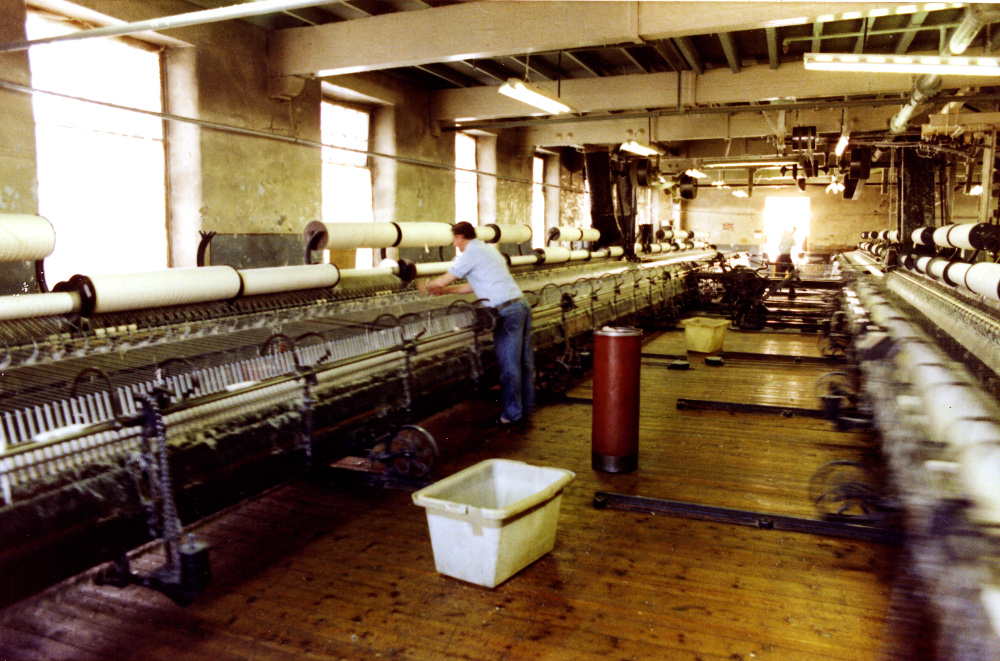
Not a bad place to have another look at the last condenser mules running on their last day at Field Mill Haslingden in November 1988. The industry has gone forever and I'm so glad I got there in time to take advantage of good men like Jim Riley. One thing is certain, nobody can ever do these tapes again on spinning.... [2013]
SCG/17 July 2003
7,025 words.
